Paul van Yperen's Blog, page 164
April 11, 2021
Jeanne Aubert
Jeanne Aubert a.k.a. Jane Aubert (1900-1988) was a French singer and actress, who was successful in Paris but also on Broadway and the West End.
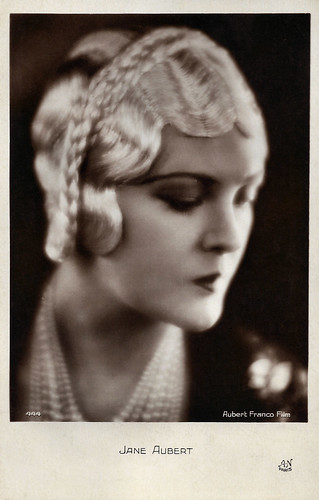
French postcard by A.N. (A. Noyer), Paris, no. 444. Photo: Aubert Franco Film. Jane Aubert in La Possession/The ownership (Léonce Perret, 1929).
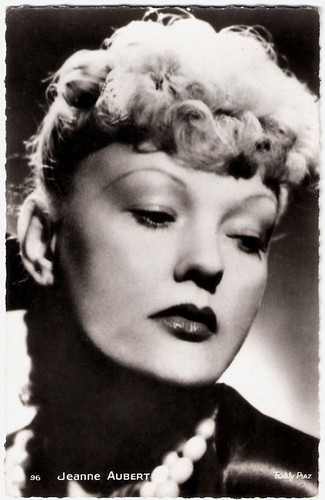
French postcard by Editions O.P., Paris, no. 960. Photo: Teddy Piaz.
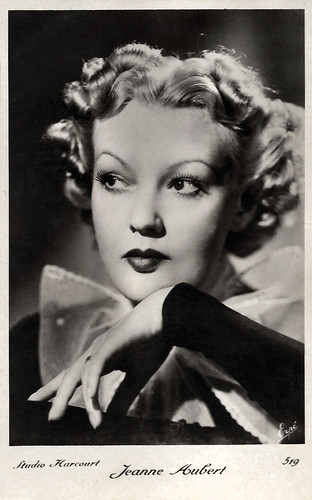
French postcard by Erpé, no. 519. Photo: Studio Harcourt.
The moral of this story is, never marry an actress
Jeanne Aubert was born Jeanne Perrinot in 1900 in Paris, France, to a single mother, Augustine Marguerite Perrinot. According to IMDb , her father was a French aristocrat.
Preceding her birth, four generations of Aubert's had made and sold artificial flowers, but Augustine pushed her daughter into a career in show business. At age five, she began performing on stage at the Théâtre du Châtelet. As a teenager, she studied voice and music.
At age eighteen, Jeanne appeared in an elaborate Mistinguett revue at the Casino de Paris. She sang in the chorus at the Apollo theater in Paris and had bit parts in revues at the Théâtre Édouard VII.
She gained prominence when, as an understudy, she replaced the lead actress in 'Le Bon Juge' (the good judge). The song 'Si tu vois ma tante' (If you see my aunt) made her a "grande Chanteuse" in Paris.
After that, she was signed for a featured role in a production in London and went on to perform in Belgium, Italy, and Switzerland. In 1926, she went to the United States to perform in 'Gay Paree' at the Winter Garden Theatre. After 175 performances, she returned to Paris to appear at the Moulin-Rouge in the revue 'Paris aux Étoiles' in 1927.
In 1928, she helped to organise the first female branch of the Jeunesse Ouvrière Chrétienne (JOC), a Roman Catholic apostolic organisation for young people. Aubert served as the first president of the JOCF of France.
Using the stage name Jane Aubert, she appeared in the silent film, La Possession/The ownership (Léonce Perret, 1929) starring Francesca Bertini and Pierre de Guingand . Wikipedia calls it her film debut, but actually, Aubert's first film was Être aimé pour soi même/To be loved for oneself (Robert Péguy, 1920).
La Possession was seen (reportedly 52 times) by Nelson Swift Morris, son of a Chicago multi-millionaire. His family had made their fortune in corned beef and at the time, Morris was overseeing a meatpacking operation in France. He used his connections to get to meet Aubert and the two became involved.
Eventually, they moved to the United States and married. Morris opposed Aubert's acting so much that he got out warrants forbidding her to appear in European shows. Obviously, the marriage failed and they were divorced in 1933. Morris, who also survived the Hindenburg disaster in 1937, later commented: "The moral of this story is, never marry an actress."
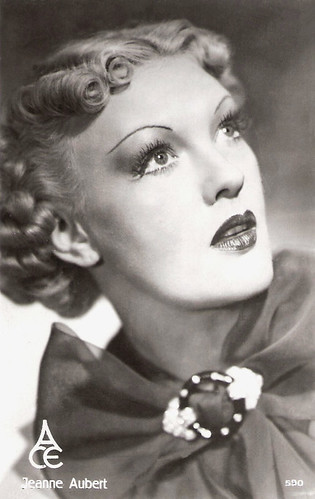
French postcard, no. 590. Photo: ACE.
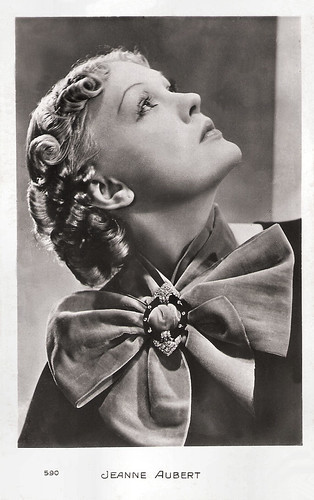
French postcard, no. 590.
Madame Aubert never lost her elegance, charisma, and shine
In 1931, Jeanne Aubert was a guest star on a radio broadcast on WJZ, singing selections from the show 'America's Sweetheart' in which she appeared on Broadway. Her other Broadway credits included 'Princess Charming' (1930), 'The Laugh Parade' (1931), 'Ballyhoo of 1932' (1932) with Bob Hope, and 'Melody' (1933) with Gypsy Rose Lee.
Following her divorce, Aubert began working in Broadway musical comedies and appeared in the short films The Mysterious Kiss (Roy Mack, 1934) and The Gem of the Ocean (Roy Mack, 1934).
In 1935, she returned to France where she acted in several films during the ensuing two years. These included Les époux scandaleux/The scandalous spouses (Georges Lacombe, 1935) with Suzy Vernon and René Lefèvre , Passé à vendre/Past for sale (René Pujol, 1936) with Pierre Brasseur , and La souris bleue/The blue mouse (Pierre-Jean Ducis, 1936) with Henri Garat .
In 1937, she returned to the stage, performing in musical varieties with the celebrated songstress Fréhel at the ABC Theatre in Paris. She was part of a number of other shows in London and other cities throughout Europe including the original London production of the musical 'Anything Goes' by Cole Porter, in which she played the lead role of Reno Sweeney.
During WWII, she appeared 630 times in 'La Veuve joyeuse' (The Merry Widow) at the Mogador Theatre and also in two other theatres. Although never a headline star, for the next decades her career was busy with numerous recordings, film and stage performances, and eventually roles on television.
Her later film include the comedy Les croulants se portent bien/The crumblers are doing well (Jean Boyer, 1961) starring Fernand Gravey , the drama Les ennemis/A Touch of Treason (Edouard Molinaro, 1962) as the mother of Roger Hanin , and her last film, Un monde nouveau/A New World (Vittorio De Sica, 1966) with Nino Castelnuovo.
In 1965, she returned to the stage in Arthur Miller's 'Après la chute' (After the Fall), directed by Luchino Visconti at the Théâtre du Gymnase.
Rudi Polt at IMDb : "Madame Aubert never lost her elegance, charisma, and shine." Later in life, she was the companion of Olympe-Charles Hériot whose family created and owned the Paris department store Les Grands Magazins du Louvre.
Jeanne Aubert passed away in 1988, aged 88, in a retirement home in Coubert, Seine-et-Marne, France, and was interred in the Cimetière Parisien de Pantin in Pantin.
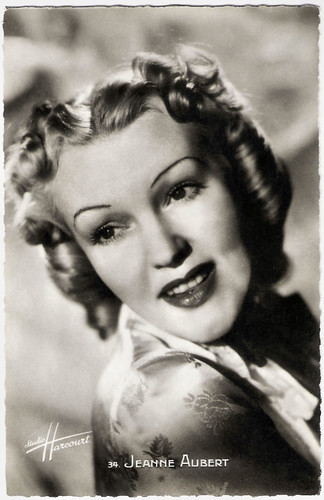
French postcard by S.E.R.P., no. 34. Photo: Studio Harcourt.
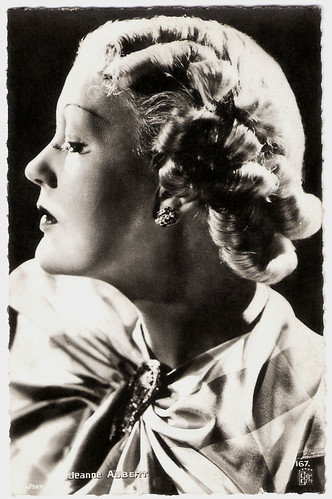
French postcard by EPC (Editions et Publications Cinématographiques), no. 167. Photo: Star.
Sources: (IMDb), Du Temps des Cerises aux Feuilles mortes (French), Wikipedia, and .

French postcard by A.N. (A. Noyer), Paris, no. 444. Photo: Aubert Franco Film. Jane Aubert in La Possession/The ownership (Léonce Perret, 1929).

French postcard by Editions O.P., Paris, no. 960. Photo: Teddy Piaz.

French postcard by Erpé, no. 519. Photo: Studio Harcourt.
The moral of this story is, never marry an actress
Jeanne Aubert was born Jeanne Perrinot in 1900 in Paris, France, to a single mother, Augustine Marguerite Perrinot. According to IMDb , her father was a French aristocrat.
Preceding her birth, four generations of Aubert's had made and sold artificial flowers, but Augustine pushed her daughter into a career in show business. At age five, she began performing on stage at the Théâtre du Châtelet. As a teenager, she studied voice and music.
At age eighteen, Jeanne appeared in an elaborate Mistinguett revue at the Casino de Paris. She sang in the chorus at the Apollo theater in Paris and had bit parts in revues at the Théâtre Édouard VII.
She gained prominence when, as an understudy, she replaced the lead actress in 'Le Bon Juge' (the good judge). The song 'Si tu vois ma tante' (If you see my aunt) made her a "grande Chanteuse" in Paris.
After that, she was signed for a featured role in a production in London and went on to perform in Belgium, Italy, and Switzerland. In 1926, she went to the United States to perform in 'Gay Paree' at the Winter Garden Theatre. After 175 performances, she returned to Paris to appear at the Moulin-Rouge in the revue 'Paris aux Étoiles' in 1927.
In 1928, she helped to organise the first female branch of the Jeunesse Ouvrière Chrétienne (JOC), a Roman Catholic apostolic organisation for young people. Aubert served as the first president of the JOCF of France.
Using the stage name Jane Aubert, she appeared in the silent film, La Possession/The ownership (Léonce Perret, 1929) starring Francesca Bertini and Pierre de Guingand . Wikipedia calls it her film debut, but actually, Aubert's first film was Être aimé pour soi même/To be loved for oneself (Robert Péguy, 1920).
La Possession was seen (reportedly 52 times) by Nelson Swift Morris, son of a Chicago multi-millionaire. His family had made their fortune in corned beef and at the time, Morris was overseeing a meatpacking operation in France. He used his connections to get to meet Aubert and the two became involved.
Eventually, they moved to the United States and married. Morris opposed Aubert's acting so much that he got out warrants forbidding her to appear in European shows. Obviously, the marriage failed and they were divorced in 1933. Morris, who also survived the Hindenburg disaster in 1937, later commented: "The moral of this story is, never marry an actress."

French postcard, no. 590. Photo: ACE.

French postcard, no. 590.
Madame Aubert never lost her elegance, charisma, and shine
In 1931, Jeanne Aubert was a guest star on a radio broadcast on WJZ, singing selections from the show 'America's Sweetheart' in which she appeared on Broadway. Her other Broadway credits included 'Princess Charming' (1930), 'The Laugh Parade' (1931), 'Ballyhoo of 1932' (1932) with Bob Hope, and 'Melody' (1933) with Gypsy Rose Lee.
Following her divorce, Aubert began working in Broadway musical comedies and appeared in the short films The Mysterious Kiss (Roy Mack, 1934) and The Gem of the Ocean (Roy Mack, 1934).
In 1935, she returned to France where she acted in several films during the ensuing two years. These included Les époux scandaleux/The scandalous spouses (Georges Lacombe, 1935) with Suzy Vernon and René Lefèvre , Passé à vendre/Past for sale (René Pujol, 1936) with Pierre Brasseur , and La souris bleue/The blue mouse (Pierre-Jean Ducis, 1936) with Henri Garat .
In 1937, she returned to the stage, performing in musical varieties with the celebrated songstress Fréhel at the ABC Theatre in Paris. She was part of a number of other shows in London and other cities throughout Europe including the original London production of the musical 'Anything Goes' by Cole Porter, in which she played the lead role of Reno Sweeney.
During WWII, she appeared 630 times in 'La Veuve joyeuse' (The Merry Widow) at the Mogador Theatre and also in two other theatres. Although never a headline star, for the next decades her career was busy with numerous recordings, film and stage performances, and eventually roles on television.
Her later film include the comedy Les croulants se portent bien/The crumblers are doing well (Jean Boyer, 1961) starring Fernand Gravey , the drama Les ennemis/A Touch of Treason (Edouard Molinaro, 1962) as the mother of Roger Hanin , and her last film, Un monde nouveau/A New World (Vittorio De Sica, 1966) with Nino Castelnuovo.
In 1965, she returned to the stage in Arthur Miller's 'Après la chute' (After the Fall), directed by Luchino Visconti at the Théâtre du Gymnase.
Rudi Polt at IMDb : "Madame Aubert never lost her elegance, charisma, and shine." Later in life, she was the companion of Olympe-Charles Hériot whose family created and owned the Paris department store Les Grands Magazins du Louvre.
Jeanne Aubert passed away in 1988, aged 88, in a retirement home in Coubert, Seine-et-Marne, France, and was interred in the Cimetière Parisien de Pantin in Pantin.

French postcard by S.E.R.P., no. 34. Photo: Studio Harcourt.

French postcard by EPC (Editions et Publications Cinématographiques), no. 167. Photo: Star.
Sources: (IMDb), Du Temps des Cerises aux Feuilles mortes (French), Wikipedia, and .
Published on April 11, 2021 22:00
April 10, 2021
The Merry Widow (1925)
In the silent film The Merry Widow (Erich von Stroheim, 1925), John Gilbert plays a prince, who must woo the now wealthy dancer (Mae Murray) he once abandoned in order to keep her money in the country in order to keep it from crashing economically. The reception for the film was superlative. Critics praised the artistic choices, such as the colours in the wedding sequence at the film’s end. The Merry Widow boasted the largest box office for any Hollywood studio in 1925 and would remain the most successful film both Murray and von Stroheim ever made.
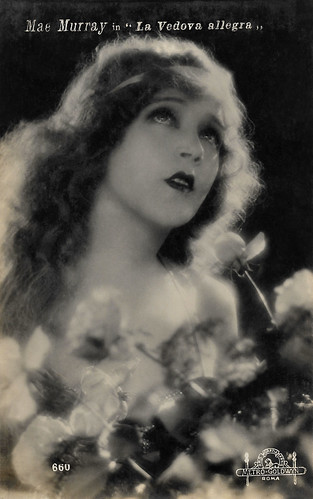
Italian postcard by Casa Editrice Ballerini & Fratini, Firenze, no. 660. Photo: Metro-Goldwyn, Roma. Mae Murray in The Merry Widow (Erich von Stroheim, 1925).
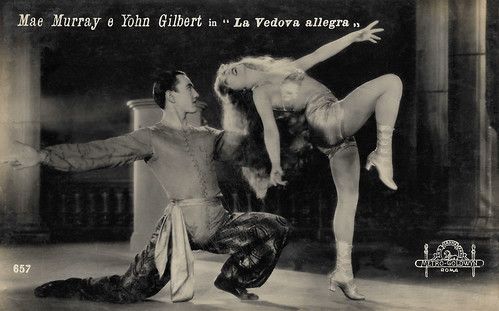
Italian postcard by Casa Editrice Ballerini & Fratini, Firenze, no. 657. Photo: Metro-Goldwyn-Film, Roma. Mae Murray and John Gilbert in The Merry Widow (Erich von Stroheim, 1925).
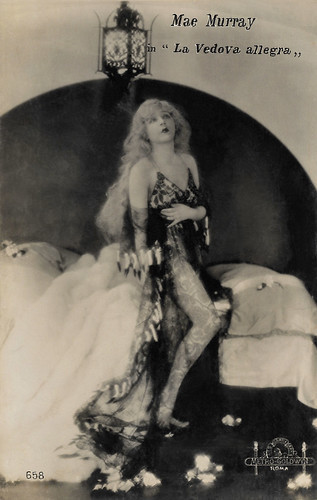
Italian postcard by Casa Editrice Ballerini & Fratini, Firenze, no. 658. Photo: Metro-Goldwyn, Roma. Mae Murray in The Merry Widow (Erich von Stroheim, 1925).
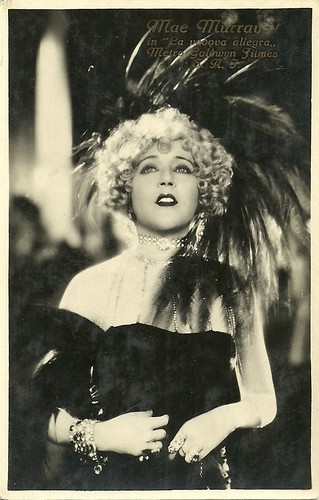
Italian postcard by G.B. Falci, Milano. Photo: MGM. Mae Murray in The Merry Widow (Erich von Stroheim, 1925).
After a couple of shaky weeks at the box-office, it was a major success
The American silent film The Merry Widow (1925) is a romantic drama/black comedy directed and written by Erich von Stroheim . Next to Mae Murray and John Gilbert , the film also stars Roy D'Arcy as Crown Prince Mirko, and Tully Marshall as Baron Sixtus Sadoja. Joan Crawford and Clark Gable both made uncredited appearances as extras in the film before they became famous.
The Merry Widow is based on the 1905 operetta 'Die lustige Witwe' by Austro-Hungarian composer Franz Lehár. The librettists, Viktor Léon and Leo Stein, based the story – concerning a rich widow, and her countrymen's attempt to keep her money in the principality by finding her the right husband – on an 1861 comedy play, 'L'attaché d'ambassade' (The Embassy Attaché) by Henri Meilhac.
Prince Danilo Petrovich falls in love with dancer Sally O'Hara. His uncle, King Nikita I of Monteblanco, forbids the marriage because she is a commoner. Thinking she has been jilted by her prince, Sally marries the old and lecherous Baron Sadoja, whose wealth has kept the kingdom afloat. When he dies suddenly, Sally must be wooed all over again by Danilo.
The operetta has enjoyed extraordinary international success since its 1905 premiere in Vienna and continues to be frequently revived and recorded. Well-known music from the score includes the 'Vilja Song', 'Da geh' ich zu Maxim' (You'll Find Me at Maxim's), and the 'Merry Widow Waltz'.
'Die Lustige Witwe' was first performed at the Theater an der Wien in Vienna on 30 December 1905, with Mizzi Günther as Hanna, Otto Treumann as Danilo, Siegmund Natzler as Baron Zeta and Annie Wünsch as Valencienne. After a couple of shaky weeks at the box-office, it was a major success, receiving good reviews and running for 483 performances.
The piece became an international sensation, and translations were quickly made into various languages: in 1907, Buenos Aires theatres were playing at least five productions, each in a different language. Productions also swiftly followed in Stockholm, Copenhagen, Milan, Moscow, and Madrid, among other places. It was eventually produced in every city with a theatre industry.
Bernard Grün, in his book 'Gold and Silver: The Life and Times of Franz Lehar', estimates that 'The Merry Widow' was performed about half a million times in its first sixty years. Global sheet music sales and recordings totaled tens of millions of dollars. According to theatre writer John Kenrick, no other play or musical up to the 1960s had enjoyed such international commercial success.
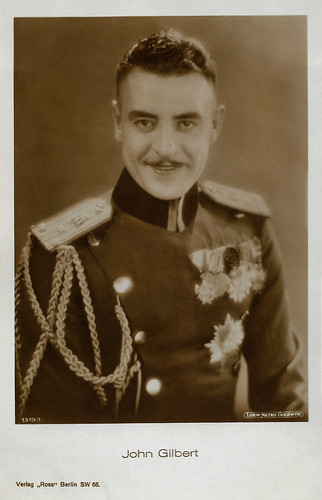
German postcard by Ross Verlag, no. 1319/1, 1927-1928. Photo: Loew Metro Goldwyn. John Gilbert in The Merry Widow (Erich von Stroheim, 1925).
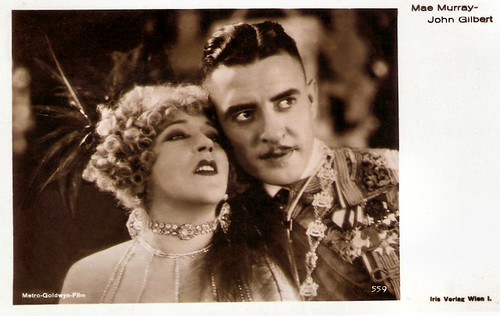
Austrian postcard by Iris Verlag, no. 559. Photo: Metro-Goldwyn-Film. John Gilbert and Mae Murray in The Merry Widow (Erich von Stroheim, 1925).
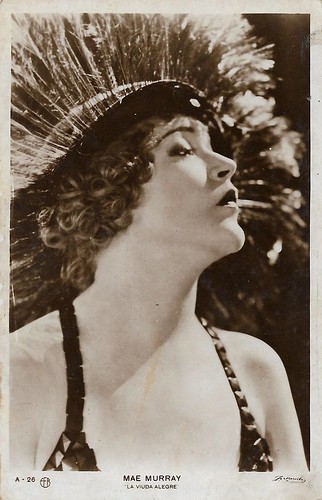
Spanish postcard by EFB (Editorial Fotografica, Barcelona), no. A-26. Photo: Zerkowitz.
Murray's less-than-merry life as a showgirl and desired object of a baron/fetishist
The first film adaptation of 'Die lustige Witwe' was a Hungarian film, A Víg özvegy/The Merry Widow (1918), directed by Mihály Kertész, who became later known in Hollywood as Michael Curtiz and was one of the most prominent directors during Hollywood's Golden Age. Prince Danilo was played by Mihály Várkonyi, who also worked in Hollywood under the name of Victor Varconi .
Erich von Stroheim's 1925 version was the second film adaptation. The Merry Widow (1925) was shot over twelve weeks with a budget of $592,000. Filming was tense as Mae Murray and director von Stroheim did not get on well. After production, Metro-Goldwyn-Mayer decided it could no longer work with the director after he added sexually explicit scenes and changed the operetta's libretto.
Mordaunt Hall in The New York Times : "The Widow is, of course, impersonated by Mae Murray , who demonstrates true acting ability in this effort. Hitherto she was like a top, and one seldom caught much more than a flash of her face. Here she stands still; she wears her costumes with a full realization of their splendor.
Lucia Bozzola ar AllMovie : "Freely adapting Franz Lehar's Viennese operetta, von Stroheim spent a great deal of screen time on Murray's less-than-merry life as a showgirl and desired object of a baron/fetishist, a lecherous prince, and Gilbert's noble Danilo of "Monteblanco." Through lavishly depicted show numbers, orgies, boudoir assignations, and finally Sally's marriage and swift widowhood by the physically impaired baron, von Stroheim turned The Merry Widow into an examination of the decadence beneath the polished surface of the European nobility. Numerous cuts to feet (over the objections of production head Irving Thalberg) particularly reveal the nature of the baron's fetish; MGM cut a few scenes deemed too racy. Danilo and Sally still unite in the famed "Merry Widow Waltz," allowing love to triumph over sordidness and lead to a grand Technicolor finale."
Upon its release, The Merry Widow (1925) was both a critical and box office success. Critics praised Murray's dramatic skills while also noting that von Stroheim had "made an actress out of Miss Murray". The film made a profit of $758,000.
The Merry Widow was adapted for the screen in sound versions in 1934, 1952, 1962, and 1994. While a print of von Stroheim's silent The Merry Widow (1925) still survives, the end sequence shot in two-tone Technicolor is now lost.
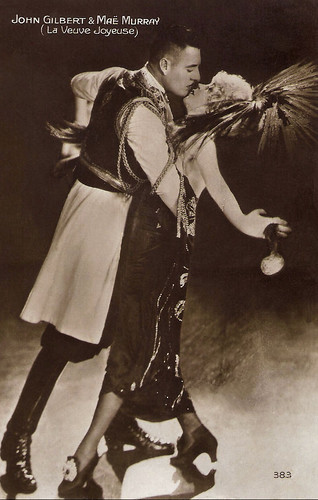
French postcard by Cinémagazine-Edition, Paris, no. 383. Photo: Metro-Goldwyn-Film. John Gilbert and Mae Murray in The Merry Widow (Erich von Stroheim, 1925).
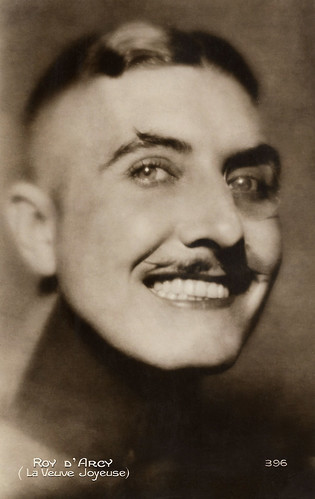
French postcard by Cinémagazine-Edition, Paris, no. 396. Photo: Roy d'Arcy in The Merry Widow (Erich Von Stroheim, 1925).
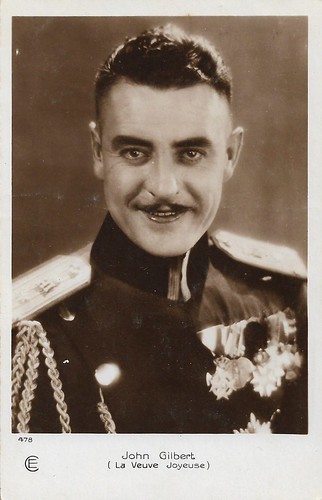
French postcard by Editions Cinémagazine, no. 478. Photo: MGM. John Gilbert as Prince Danilo in The Merry Widow (Erich von Stroheim, 1925).
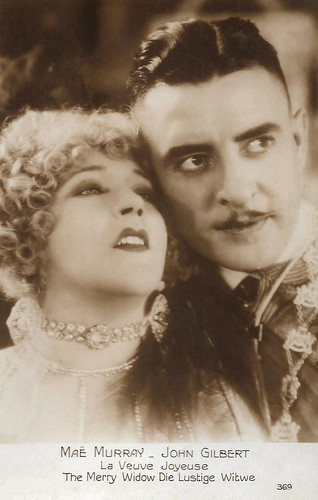
French postcard in the Les Vedettes de Cinéma Series, by A.N., Paris, no. 369. Mae Murray [the trema is a mistake] and John Gilbert as the romantic couple Sally O'Hara and Prince Danilo in The Merry Widow (Erich von Stroheim, 1925).
Sources: Lucia Bozzola (AllMovie), Wikipedia and IMDb.

Italian postcard by Casa Editrice Ballerini & Fratini, Firenze, no. 660. Photo: Metro-Goldwyn, Roma. Mae Murray in The Merry Widow (Erich von Stroheim, 1925).

Italian postcard by Casa Editrice Ballerini & Fratini, Firenze, no. 657. Photo: Metro-Goldwyn-Film, Roma. Mae Murray and John Gilbert in The Merry Widow (Erich von Stroheim, 1925).

Italian postcard by Casa Editrice Ballerini & Fratini, Firenze, no. 658. Photo: Metro-Goldwyn, Roma. Mae Murray in The Merry Widow (Erich von Stroheim, 1925).

Italian postcard by G.B. Falci, Milano. Photo: MGM. Mae Murray in The Merry Widow (Erich von Stroheim, 1925).
After a couple of shaky weeks at the box-office, it was a major success
The American silent film The Merry Widow (1925) is a romantic drama/black comedy directed and written by Erich von Stroheim . Next to Mae Murray and John Gilbert , the film also stars Roy D'Arcy as Crown Prince Mirko, and Tully Marshall as Baron Sixtus Sadoja. Joan Crawford and Clark Gable both made uncredited appearances as extras in the film before they became famous.
The Merry Widow is based on the 1905 operetta 'Die lustige Witwe' by Austro-Hungarian composer Franz Lehár. The librettists, Viktor Léon and Leo Stein, based the story – concerning a rich widow, and her countrymen's attempt to keep her money in the principality by finding her the right husband – on an 1861 comedy play, 'L'attaché d'ambassade' (The Embassy Attaché) by Henri Meilhac.
Prince Danilo Petrovich falls in love with dancer Sally O'Hara. His uncle, King Nikita I of Monteblanco, forbids the marriage because she is a commoner. Thinking she has been jilted by her prince, Sally marries the old and lecherous Baron Sadoja, whose wealth has kept the kingdom afloat. When he dies suddenly, Sally must be wooed all over again by Danilo.
The operetta has enjoyed extraordinary international success since its 1905 premiere in Vienna and continues to be frequently revived and recorded. Well-known music from the score includes the 'Vilja Song', 'Da geh' ich zu Maxim' (You'll Find Me at Maxim's), and the 'Merry Widow Waltz'.
'Die Lustige Witwe' was first performed at the Theater an der Wien in Vienna on 30 December 1905, with Mizzi Günther as Hanna, Otto Treumann as Danilo, Siegmund Natzler as Baron Zeta and Annie Wünsch as Valencienne. After a couple of shaky weeks at the box-office, it was a major success, receiving good reviews and running for 483 performances.
The piece became an international sensation, and translations were quickly made into various languages: in 1907, Buenos Aires theatres were playing at least five productions, each in a different language. Productions also swiftly followed in Stockholm, Copenhagen, Milan, Moscow, and Madrid, among other places. It was eventually produced in every city with a theatre industry.
Bernard Grün, in his book 'Gold and Silver: The Life and Times of Franz Lehar', estimates that 'The Merry Widow' was performed about half a million times in its first sixty years. Global sheet music sales and recordings totaled tens of millions of dollars. According to theatre writer John Kenrick, no other play or musical up to the 1960s had enjoyed such international commercial success.

German postcard by Ross Verlag, no. 1319/1, 1927-1928. Photo: Loew Metro Goldwyn. John Gilbert in The Merry Widow (Erich von Stroheim, 1925).

Austrian postcard by Iris Verlag, no. 559. Photo: Metro-Goldwyn-Film. John Gilbert and Mae Murray in The Merry Widow (Erich von Stroheim, 1925).

Spanish postcard by EFB (Editorial Fotografica, Barcelona), no. A-26. Photo: Zerkowitz.
Murray's less-than-merry life as a showgirl and desired object of a baron/fetishist
The first film adaptation of 'Die lustige Witwe' was a Hungarian film, A Víg özvegy/The Merry Widow (1918), directed by Mihály Kertész, who became later known in Hollywood as Michael Curtiz and was one of the most prominent directors during Hollywood's Golden Age. Prince Danilo was played by Mihály Várkonyi, who also worked in Hollywood under the name of Victor Varconi .
Erich von Stroheim's 1925 version was the second film adaptation. The Merry Widow (1925) was shot over twelve weeks with a budget of $592,000. Filming was tense as Mae Murray and director von Stroheim did not get on well. After production, Metro-Goldwyn-Mayer decided it could no longer work with the director after he added sexually explicit scenes and changed the operetta's libretto.
Mordaunt Hall in The New York Times : "The Widow is, of course, impersonated by Mae Murray , who demonstrates true acting ability in this effort. Hitherto she was like a top, and one seldom caught much more than a flash of her face. Here she stands still; she wears her costumes with a full realization of their splendor.
Lucia Bozzola ar AllMovie : "Freely adapting Franz Lehar's Viennese operetta, von Stroheim spent a great deal of screen time on Murray's less-than-merry life as a showgirl and desired object of a baron/fetishist, a lecherous prince, and Gilbert's noble Danilo of "Monteblanco." Through lavishly depicted show numbers, orgies, boudoir assignations, and finally Sally's marriage and swift widowhood by the physically impaired baron, von Stroheim turned The Merry Widow into an examination of the decadence beneath the polished surface of the European nobility. Numerous cuts to feet (over the objections of production head Irving Thalberg) particularly reveal the nature of the baron's fetish; MGM cut a few scenes deemed too racy. Danilo and Sally still unite in the famed "Merry Widow Waltz," allowing love to triumph over sordidness and lead to a grand Technicolor finale."
Upon its release, The Merry Widow (1925) was both a critical and box office success. Critics praised Murray's dramatic skills while also noting that von Stroheim had "made an actress out of Miss Murray". The film made a profit of $758,000.
The Merry Widow was adapted for the screen in sound versions in 1934, 1952, 1962, and 1994. While a print of von Stroheim's silent The Merry Widow (1925) still survives, the end sequence shot in two-tone Technicolor is now lost.

French postcard by Cinémagazine-Edition, Paris, no. 383. Photo: Metro-Goldwyn-Film. John Gilbert and Mae Murray in The Merry Widow (Erich von Stroheim, 1925).

French postcard by Cinémagazine-Edition, Paris, no. 396. Photo: Roy d'Arcy in The Merry Widow (Erich Von Stroheim, 1925).

French postcard by Editions Cinémagazine, no. 478. Photo: MGM. John Gilbert as Prince Danilo in The Merry Widow (Erich von Stroheim, 1925).

French postcard in the Les Vedettes de Cinéma Series, by A.N., Paris, no. 369. Mae Murray [the trema is a mistake] and John Gilbert as the romantic couple Sally O'Hara and Prince Danilo in The Merry Widow (Erich von Stroheim, 1925).
Sources: Lucia Bozzola (AllMovie), Wikipedia and IMDb.
Published on April 10, 2021 22:00
April 9, 2021
Recently acquired
This is another post in our irregularly appearing series about our new acquisitions. As we're still in lockdown and all the collector fairs and flea markets are closed, we discovered these little treasures (in our opinion :)) at various webshops.
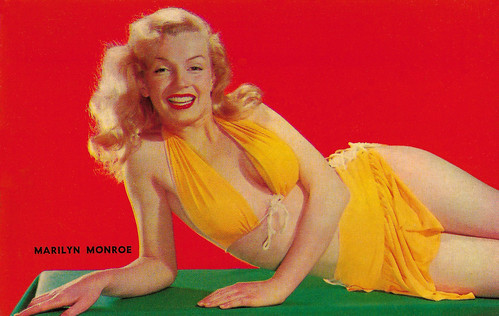
American postcard by Tichnor Bros, Boston, Mass., no. L-39. Photo: Richard Miller, 1945. Caption: Thinking of You.
By 1953, Marilyn Monroe (1926-1962) was one of the most marketable Hollywood stars, with leading roles in three films: the noir Niagara, which focused on her sex appeal, and the comedies Gentlemen Prefer Blondes and How to Marry a Millionaire, which established her star image as a "dumb blonde". Although she played a significant role in the creation and management of her public image throughout her career, she was disappointed at being typecast and underpaid by the studio. She was briefly suspended in early 1954 for refusing a film project but returned to star in one of the biggest box office successes of her career, The Seven Year Itch (1955).
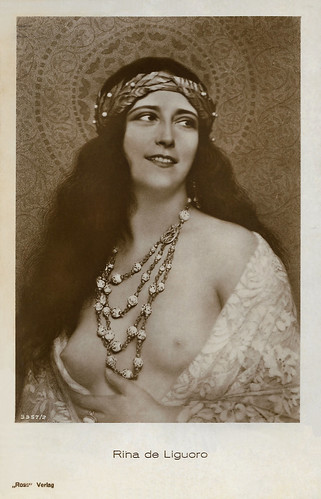
German postcard by Ross Verlag, no. 3357/2, 1928-1929.
Rina De Liguoro (1892-1966) was the last diva of the Italian silent cinema of the 1920s. She had her breakthrough in 1924 as the sensual, untamed Roman empress Messalina, and the beautiful countess continued her glittering career in such epics as Quo Vadis (1924), Casanova (1927), and Cecil B. De Mille's notorious flop Madam Satan (1930).
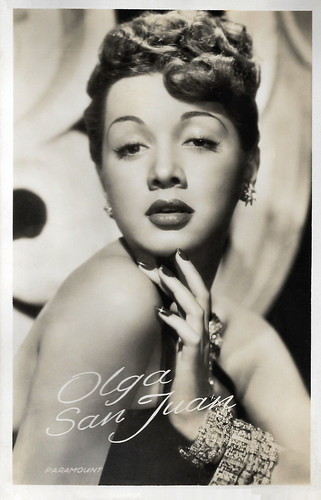
Dutch postcard, no. 3395. Photo: Paramount.
American actress, dancer, and comedian Olga San Juan (1927-2009) was mainly active in films during the 1940s. San Juan was dubbed the 'Puerto Rican Pepperpot' or 'Beauty Siren' for singing and dancing roles alongside Bing Crosby, Fred Astaire, and many others.

French postcard by Cinémagazine Edition, Paris, no. 328. On the card is his name written as Harrisson Ford (sic).
Harrison Ford (1884-1957) was an American stage and film actor. He was a leading Broadway theater performer and a star of the silent film era.
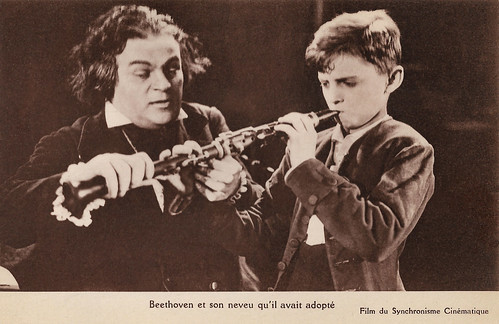
French postcard. Photo: Film du Synchronisme Cinématique. Fritz Kortner in Das Leben des Beethoven/The Life of the Beethoven (Hans Otto, 1927). Caption: Beethoven and his adopted nephew.
Austrian-born stage and film actor and theatre director Fritz Kortner (1892-1970) was one of the best-known character actors of the German silent cinema. His specialty was playing sinister and threatening roles.
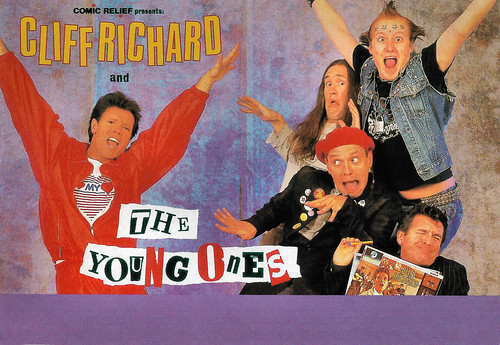
British postcard by Poppictures, London, bi. C 615. Photo: Cliff Richard and the cast of the TV Series The Young Ones (1982-1984) with Rik Mayall, Adrian Edmondson, Nigel Planer, and Christopher Ryan.
In the late 1950s, British singer, actor, and Sir Cliff Richard (1940) was known as Britain's answer to Elvis Presley. The ‘Cliff Richard musical’ became the number one cinema box office attraction in Britain for both 1962 and 1963.
The Young Ones (1982-1984) is a comedy series about the crazy and sometimes surreal adventures of four very different students in Thatcher's Britain. Ben Elton, Rik Mayall, Lise Mayer, and Alexei Sayle wrote the twelve episodes of the show. Rik Mayall, Adrian Edmondson, Nigel Planer, and Christopher Ryan play the four mismatched university students, who share a house in North London: Neil, the hippy; Mike, the cool person; Rick, a would-be anarchist studying sociology; and Vyvyan, the punk medical student who is prone to extreme violence. Together with their bastard Russian landlord (Alexei Sayle), the world of these 'bachelor boys' is surreal and violent, but ultimately hilarious.
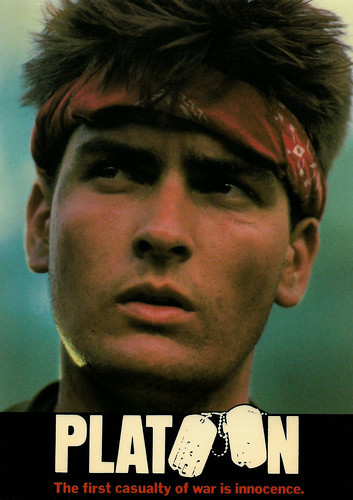
British postcard by Reflex Marketing LTD., Wellingborough, England, no. PC 243. Photo: Hemsdale Film Corporation, 1986. Charlie Sheen in Platoon (Oliver Stone, 1986). Caption: The first casualty of war is innocence.
American actor Charlie Sheen (1965) had his breakthrough with Oliver Stone's Oscar-winning epic Platoon (1986). Other hits were Wall Street (1987), Young Guns (1988), Major League (1989), Navy SEALs (1990), The Three Musketeers (1993), and Terminal Velocity (1994). He made a come-back with the sitcom Two and a Half Men (2003).

French postcard by A.N. (A. Noyer), Paris, no. 444. Photo: Aubert Franco Film. Jane Aubert in La Possession/The ownership (Léonce Perret, 1929).
Jeanne Aubert a.k.a. Jane Aubert (1900-1988) was a French singer and actress, who was successful in Paris but also on Broadway and the West End.
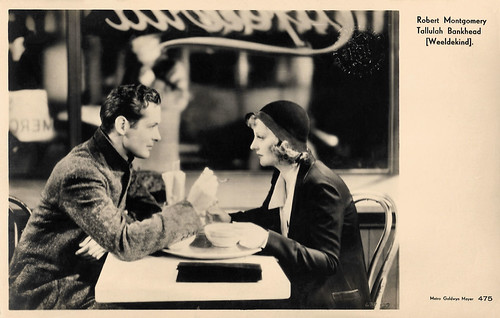
Dutch postcard, no. 475. Photo: M.G.M. (Metro Goldwyn Mayer). Robert Montgomery and Tallulah Bankhead in Faithless (Harry Beaumont, 1932).
Robert Montgomery, who was born in 1904, was left penniless at the age of sixteen and became a mechanic's mate on a railway, a deckhand, and finally property man to a touring company, which resulted in a stage career. Played in stock for some time, mostly old man characters, and eventually reached New York. Film debut in So This is College. Among his later pictures were Nor More Ladies, Mutiny on the Bounty, and Piccadilly Jim.
American actress Tallulah Bankhead (1902-1968) was the most popular star of London's famed West End in the 1920s. After starring in several well-received plays, she gained the attention of Paramount Pictures executives and returned to the United States to try her hand at the film world. Tallulah's personality did not shine on film as Paramount executives had hoped. She appeared in such films as Devil and the Deep (1932) with Gary Cooper, Charles Laughton and newcomer Cary Grant, and Lifeboat (1944). While she made most of her fame on the stages of the world, the film industry and its history became richer because of her talent and her very colorful personality. Today her phrase, "Hello, Dahling" is known throughout the entertainment world.
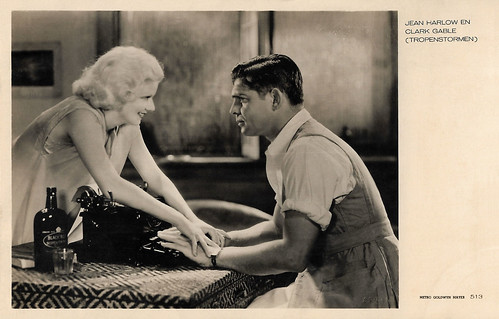
Dutch postcard, no. 513. Photo: M.G.M. Jean Harlow and Clark Gable in Red Dust (Victor Fleming, 1932). Sent by mail in 1935.
American film actress Jean Harlow (1911–1937) was one of the sex symbols of the 1930s. With her come-hither body, platinum blonde hair, and a keen sense of humour, she had her breakthrough in Howard Hughes' World War I epic Hell's Angels (1930). Frank Capra's Platinum Blonde (1931) cemented her role as America's new sex symbol. In 1932, she signed with Metro-Goldwyn-Mayer and became the leading lady in a string of hit films. These included Red Dust (1932), Dinner at Eight (1933), Reckless (1935), and Suzy (1936). Among her frequent co-stars were William Powell, Spencer Tracy, and, in six films, Clark Gable.
With his natural charm and knowing smile, Clark Gable (1901-1959) was 'The King of Hollywood' during the 1930s. He often portrayed down-to-earth, bravado characters with a carefree attitude, and was seen as the epitome of masculinity. Gable won an Academy Award for Best Actor for It Happened One Night (1934), and was nominated for leading roles in Mutiny on the Bounty (1935) and for his best-known role as Rhett Butler in Gone with the Wind (1939).
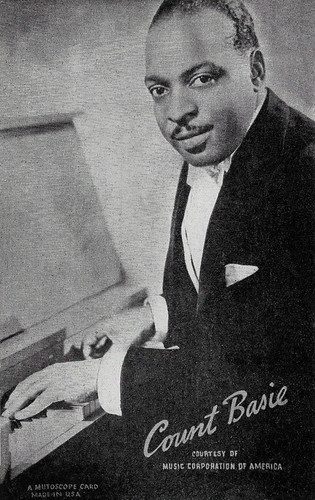
American Arcade postcard by Mutoscope. Photo: Music Corporation of America (MCA).
Count Basie (1904-1984) was an American jazz pianist, organist, bandleader, and composer. In 1935, Basie formed his own jazz orchestra, the Count Basie Orchestra, and in 1936 took them to Chicago for a long engagement and their first recording. He led the group for almost 50 years, creating innovations like the use of two "split" tenor saxophones, emphasizing the rhythm section, riffing with a big band, using arrangers to broaden their sound, and others.
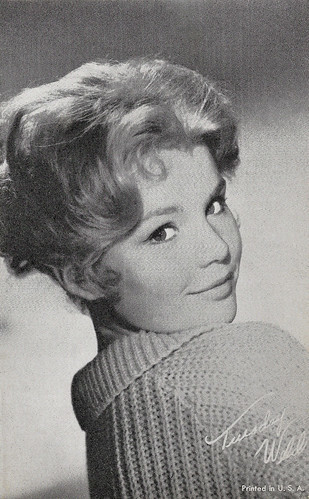
American Arcade card.
Tuesday Weld (1943) began acting as a child and progressed to mature roles in the late 1950s. She won a Golden Globe Award for Most Promising Female Newcomer in 1960. Over the following decades, she played reckless, sexually acting-out women in such films as Play It as It Lays (1972), Looking for Mr. Goodbar (1977), The Winter of Our Discontent (1983), and Once Upon a Time in America (1984). Since the late 1980s, her acting appearances have been infrequent, but her most successful film was Falling Down (1993).
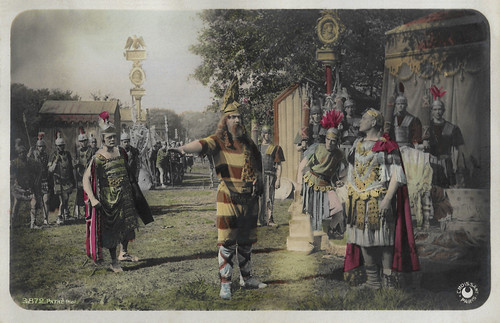
French postcard by Croissant, Paris, no. 3872. Photo: Pathé Frères. Publicity still for Vercingétorix/Gaul's Hero (N.N., 1909).
The subject of this beautifully colored picture is the great Gaulish chieftain, Vercingetorix, of the tribe of Arverni. He was a powerful adversary of Caesar and was continually perpetrating hostilities against the mighty monarch. In the first view, Gaul's hero is seen among his own people, who honor and respect him for his valiant deeds. Many times has he led them in the battle against the Romans, and each time has he come out victorious. Now, however, after a long siege, we see the brave Gaul shut up in Alesia where Caesar's army, after a prolonged battle, eventually capture the powerful fortress and take Vercingetorix a prisoner. The latter is led before his hated enemy, Caesar, where he surrenders and instead of being extended the usual courtesy that is due to the vanquished, Caesar has his prisoner bound in chains and keeps him captive in the camp, where Vercingetorix is compelled to witness many ghastly deeds perpetrated against his own people.
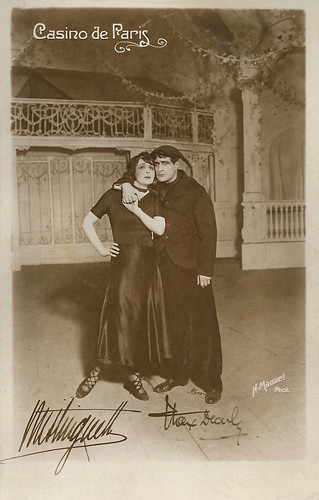
French postcard by Etablissements photographiques de Boulogne-sur-Seine. Photo: H. Manuel. Caption: Casino de Paris.
French actress and singer Mistinguett (1875-1956) captivated Paris with her risqué routines. She went on to become the most popular French entertainer of her time and the highest-paid female entertainer in the world. She appeared more than 60 times in the cinema.
Max Dearly (1874-1943) was a French actor, famous for his parts in 1930s French sound film but also for his previous career in Parisian vaudeville.
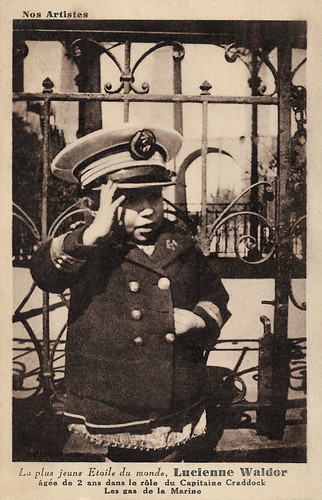
French postcard in the Nos Artistes series. Lucienne Waldor in Les gars de la Marine. Caption: the youngest star in the world, Lucienne Waldor, aged 2, in the role of Captain Craddock, singing Les gars de Marine. The -r has been forgotten on this card.
In 1933 Lucienne Waldor aka Lulu, real name Lucienne Sangan, born Lambec, was promoted as the French Shirley Temple. With her parents Lucien Waldor and his wife, her elder brother Jackie Waldor and other family members (brothers Lucky and Robert and cousin Jackson), she performed as the 'Troupe Waldor", e.g. as live intermezzo in cinemas, singing, dancing, and playing instruments, and touring all of France.
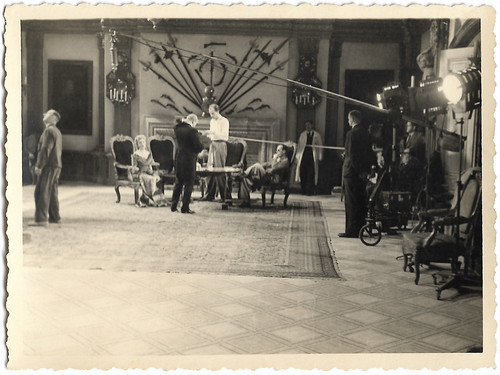
German set photo by Burghardt. Erika von Thellmann and Paul Bild at the set of Mit den Augen einer Frau/With the eyes of a woman (Karl Georg Külb, 1942).
Mit den Augen einer Frau/With the eyes of a woman (Karl Georg Külb, 1942) was a German drama, produced during the Second World War by the German studio Aco-Film. The film's sets were designed by the art director Willy Schiller. It was shot at the Althoff Studios in Berlin. The famous Russian diva Olga Tschechowa starred as Marie-Louise Von Ditmar, Baroness von Stein. Her daughter, Ada Tschechowa, played Marie-Louise as an 18-years old. Actress Erika von Thellmann, on this rare set photo, played Marie-Luise's mother, Mrs. von Ditmar. Paul Bildt, also pictured, played her father, landowner von Ditmar. IMDb writes that the film was banned by the German censors on 4 November 1942, shortly after the premiere. After the war, the film was re-issued.
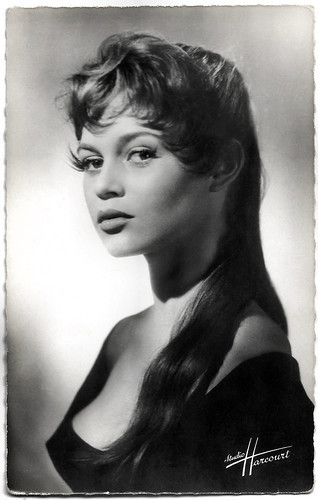
French postcard by Editions du Globe, Paris, no. 748. Photo: Studio Harcourt.
Beautiful French actress Brigitte Bardot (1934) was the sex kitten of the European film industry. BB starred in 48 films, performed in numerous musical shows, and recorded 80 songs. After her retirement in 1973, she established herself as an animal rights activist and made vegetarianism sexy.
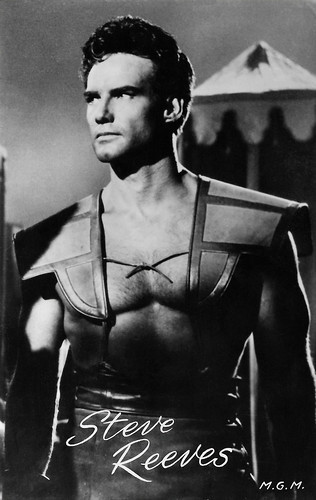
Dutch postcard by Uitg. Takken, Utrecht, no. AX 4608. Photo: M.G.M. Steve Reeves in La battaglia di Maratona/The Giant of Marathon (Jacques Tourneur, Bruno Vailati, 1959).
Handsome, musclebound Steve Reeves (1926-2000) was an American bodybuilder and actor, who was a huge success in Hercules (1958) and other Peplum films, the Italian sword-and-sandal epics. At the peak of his career, around 1960, he was reputedly the highest-paid actor in Europe.
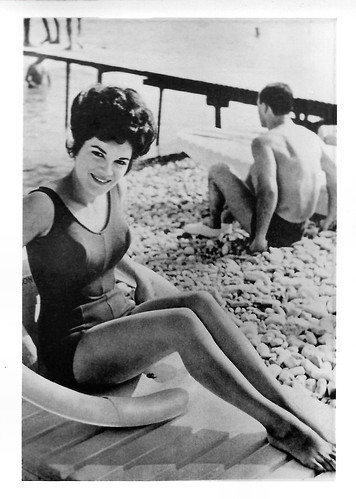
Small Dutch collectors card.
A few months ago, we bought a load of these small black and white photos from a seller at Marktplaats, who did not know where they came from. He thought that the photos were taken of pictures that had been published in Dutch Oh-la-la magazines like De Lach, in English 'The Smile'. As young kids in the 1960s, Truus and I read 'De Lach' at home. My parents received these magazines from our grandmother. Grandma never read them, but out of pity for the man who sold the magazines, she refused to cancel the subscription and gave the magazines to my father. As young kids, Truus and I loved the magazines too, and like serious beauty-contestant judges, we gave all the models numbers for who we liked best. At Flickr, we asked our followers to guess who the starlet of the card is. This is the American singer and incidental actress Conny Francis. In the near future, we hope to make a Guess Who post at EFSP with our favourite cards from this collection.

American postcard by Tichnor Bros, Boston, Mass., no. L-39. Photo: Richard Miller, 1945. Caption: Thinking of You.
By 1953, Marilyn Monroe (1926-1962) was one of the most marketable Hollywood stars, with leading roles in three films: the noir Niagara, which focused on her sex appeal, and the comedies Gentlemen Prefer Blondes and How to Marry a Millionaire, which established her star image as a "dumb blonde". Although she played a significant role in the creation and management of her public image throughout her career, she was disappointed at being typecast and underpaid by the studio. She was briefly suspended in early 1954 for refusing a film project but returned to star in one of the biggest box office successes of her career, The Seven Year Itch (1955).

German postcard by Ross Verlag, no. 3357/2, 1928-1929.
Rina De Liguoro (1892-1966) was the last diva of the Italian silent cinema of the 1920s. She had her breakthrough in 1924 as the sensual, untamed Roman empress Messalina, and the beautiful countess continued her glittering career in such epics as Quo Vadis (1924), Casanova (1927), and Cecil B. De Mille's notorious flop Madam Satan (1930).

Dutch postcard, no. 3395. Photo: Paramount.
American actress, dancer, and comedian Olga San Juan (1927-2009) was mainly active in films during the 1940s. San Juan was dubbed the 'Puerto Rican Pepperpot' or 'Beauty Siren' for singing and dancing roles alongside Bing Crosby, Fred Astaire, and many others.

French postcard by Cinémagazine Edition, Paris, no. 328. On the card is his name written as Harrisson Ford (sic).
Harrison Ford (1884-1957) was an American stage and film actor. He was a leading Broadway theater performer and a star of the silent film era.

French postcard. Photo: Film du Synchronisme Cinématique. Fritz Kortner in Das Leben des Beethoven/The Life of the Beethoven (Hans Otto, 1927). Caption: Beethoven and his adopted nephew.
Austrian-born stage and film actor and theatre director Fritz Kortner (1892-1970) was one of the best-known character actors of the German silent cinema. His specialty was playing sinister and threatening roles.

British postcard by Poppictures, London, bi. C 615. Photo: Cliff Richard and the cast of the TV Series The Young Ones (1982-1984) with Rik Mayall, Adrian Edmondson, Nigel Planer, and Christopher Ryan.
In the late 1950s, British singer, actor, and Sir Cliff Richard (1940) was known as Britain's answer to Elvis Presley. The ‘Cliff Richard musical’ became the number one cinema box office attraction in Britain for both 1962 and 1963.
The Young Ones (1982-1984) is a comedy series about the crazy and sometimes surreal adventures of four very different students in Thatcher's Britain. Ben Elton, Rik Mayall, Lise Mayer, and Alexei Sayle wrote the twelve episodes of the show. Rik Mayall, Adrian Edmondson, Nigel Planer, and Christopher Ryan play the four mismatched university students, who share a house in North London: Neil, the hippy; Mike, the cool person; Rick, a would-be anarchist studying sociology; and Vyvyan, the punk medical student who is prone to extreme violence. Together with their bastard Russian landlord (Alexei Sayle), the world of these 'bachelor boys' is surreal and violent, but ultimately hilarious.

British postcard by Reflex Marketing LTD., Wellingborough, England, no. PC 243. Photo: Hemsdale Film Corporation, 1986. Charlie Sheen in Platoon (Oliver Stone, 1986). Caption: The first casualty of war is innocence.
American actor Charlie Sheen (1965) had his breakthrough with Oliver Stone's Oscar-winning epic Platoon (1986). Other hits were Wall Street (1987), Young Guns (1988), Major League (1989), Navy SEALs (1990), The Three Musketeers (1993), and Terminal Velocity (1994). He made a come-back with the sitcom Two and a Half Men (2003).

French postcard by A.N. (A. Noyer), Paris, no. 444. Photo: Aubert Franco Film. Jane Aubert in La Possession/The ownership (Léonce Perret, 1929).
Jeanne Aubert a.k.a. Jane Aubert (1900-1988) was a French singer and actress, who was successful in Paris but also on Broadway and the West End.

Dutch postcard, no. 475. Photo: M.G.M. (Metro Goldwyn Mayer). Robert Montgomery and Tallulah Bankhead in Faithless (Harry Beaumont, 1932).
Robert Montgomery, who was born in 1904, was left penniless at the age of sixteen and became a mechanic's mate on a railway, a deckhand, and finally property man to a touring company, which resulted in a stage career. Played in stock for some time, mostly old man characters, and eventually reached New York. Film debut in So This is College. Among his later pictures were Nor More Ladies, Mutiny on the Bounty, and Piccadilly Jim.
American actress Tallulah Bankhead (1902-1968) was the most popular star of London's famed West End in the 1920s. After starring in several well-received plays, she gained the attention of Paramount Pictures executives and returned to the United States to try her hand at the film world. Tallulah's personality did not shine on film as Paramount executives had hoped. She appeared in such films as Devil and the Deep (1932) with Gary Cooper, Charles Laughton and newcomer Cary Grant, and Lifeboat (1944). While she made most of her fame on the stages of the world, the film industry and its history became richer because of her talent and her very colorful personality. Today her phrase, "Hello, Dahling" is known throughout the entertainment world.

Dutch postcard, no. 513. Photo: M.G.M. Jean Harlow and Clark Gable in Red Dust (Victor Fleming, 1932). Sent by mail in 1935.
American film actress Jean Harlow (1911–1937) was one of the sex symbols of the 1930s. With her come-hither body, platinum blonde hair, and a keen sense of humour, she had her breakthrough in Howard Hughes' World War I epic Hell's Angels (1930). Frank Capra's Platinum Blonde (1931) cemented her role as America's new sex symbol. In 1932, she signed with Metro-Goldwyn-Mayer and became the leading lady in a string of hit films. These included Red Dust (1932), Dinner at Eight (1933), Reckless (1935), and Suzy (1936). Among her frequent co-stars were William Powell, Spencer Tracy, and, in six films, Clark Gable.
With his natural charm and knowing smile, Clark Gable (1901-1959) was 'The King of Hollywood' during the 1930s. He often portrayed down-to-earth, bravado characters with a carefree attitude, and was seen as the epitome of masculinity. Gable won an Academy Award for Best Actor for It Happened One Night (1934), and was nominated for leading roles in Mutiny on the Bounty (1935) and for his best-known role as Rhett Butler in Gone with the Wind (1939).

American Arcade postcard by Mutoscope. Photo: Music Corporation of America (MCA).
Count Basie (1904-1984) was an American jazz pianist, organist, bandleader, and composer. In 1935, Basie formed his own jazz orchestra, the Count Basie Orchestra, and in 1936 took them to Chicago for a long engagement and their first recording. He led the group for almost 50 years, creating innovations like the use of two "split" tenor saxophones, emphasizing the rhythm section, riffing with a big band, using arrangers to broaden their sound, and others.

American Arcade card.
Tuesday Weld (1943) began acting as a child and progressed to mature roles in the late 1950s. She won a Golden Globe Award for Most Promising Female Newcomer in 1960. Over the following decades, she played reckless, sexually acting-out women in such films as Play It as It Lays (1972), Looking for Mr. Goodbar (1977), The Winter of Our Discontent (1983), and Once Upon a Time in America (1984). Since the late 1980s, her acting appearances have been infrequent, but her most successful film was Falling Down (1993).

French postcard by Croissant, Paris, no. 3872. Photo: Pathé Frères. Publicity still for Vercingétorix/Gaul's Hero (N.N., 1909).
The subject of this beautifully colored picture is the great Gaulish chieftain, Vercingetorix, of the tribe of Arverni. He was a powerful adversary of Caesar and was continually perpetrating hostilities against the mighty monarch. In the first view, Gaul's hero is seen among his own people, who honor and respect him for his valiant deeds. Many times has he led them in the battle against the Romans, and each time has he come out victorious. Now, however, after a long siege, we see the brave Gaul shut up in Alesia where Caesar's army, after a prolonged battle, eventually capture the powerful fortress and take Vercingetorix a prisoner. The latter is led before his hated enemy, Caesar, where he surrenders and instead of being extended the usual courtesy that is due to the vanquished, Caesar has his prisoner bound in chains and keeps him captive in the camp, where Vercingetorix is compelled to witness many ghastly deeds perpetrated against his own people.

French postcard by Etablissements photographiques de Boulogne-sur-Seine. Photo: H. Manuel. Caption: Casino de Paris.
French actress and singer Mistinguett (1875-1956) captivated Paris with her risqué routines. She went on to become the most popular French entertainer of her time and the highest-paid female entertainer in the world. She appeared more than 60 times in the cinema.
Max Dearly (1874-1943) was a French actor, famous for his parts in 1930s French sound film but also for his previous career in Parisian vaudeville.

French postcard in the Nos Artistes series. Lucienne Waldor in Les gars de la Marine. Caption: the youngest star in the world, Lucienne Waldor, aged 2, in the role of Captain Craddock, singing Les gars de Marine. The -r has been forgotten on this card.
In 1933 Lucienne Waldor aka Lulu, real name Lucienne Sangan, born Lambec, was promoted as the French Shirley Temple. With her parents Lucien Waldor and his wife, her elder brother Jackie Waldor and other family members (brothers Lucky and Robert and cousin Jackson), she performed as the 'Troupe Waldor", e.g. as live intermezzo in cinemas, singing, dancing, and playing instruments, and touring all of France.

German set photo by Burghardt. Erika von Thellmann and Paul Bild at the set of Mit den Augen einer Frau/With the eyes of a woman (Karl Georg Külb, 1942).
Mit den Augen einer Frau/With the eyes of a woman (Karl Georg Külb, 1942) was a German drama, produced during the Second World War by the German studio Aco-Film. The film's sets were designed by the art director Willy Schiller. It was shot at the Althoff Studios in Berlin. The famous Russian diva Olga Tschechowa starred as Marie-Louise Von Ditmar, Baroness von Stein. Her daughter, Ada Tschechowa, played Marie-Louise as an 18-years old. Actress Erika von Thellmann, on this rare set photo, played Marie-Luise's mother, Mrs. von Ditmar. Paul Bildt, also pictured, played her father, landowner von Ditmar. IMDb writes that the film was banned by the German censors on 4 November 1942, shortly after the premiere. After the war, the film was re-issued.

French postcard by Editions du Globe, Paris, no. 748. Photo: Studio Harcourt.
Beautiful French actress Brigitte Bardot (1934) was the sex kitten of the European film industry. BB starred in 48 films, performed in numerous musical shows, and recorded 80 songs. After her retirement in 1973, she established herself as an animal rights activist and made vegetarianism sexy.

Dutch postcard by Uitg. Takken, Utrecht, no. AX 4608. Photo: M.G.M. Steve Reeves in La battaglia di Maratona/The Giant of Marathon (Jacques Tourneur, Bruno Vailati, 1959).
Handsome, musclebound Steve Reeves (1926-2000) was an American bodybuilder and actor, who was a huge success in Hercules (1958) and other Peplum films, the Italian sword-and-sandal epics. At the peak of his career, around 1960, he was reputedly the highest-paid actor in Europe.

Small Dutch collectors card.
A few months ago, we bought a load of these small black and white photos from a seller at Marktplaats, who did not know where they came from. He thought that the photos were taken of pictures that had been published in Dutch Oh-la-la magazines like De Lach, in English 'The Smile'. As young kids in the 1960s, Truus and I read 'De Lach' at home. My parents received these magazines from our grandmother. Grandma never read them, but out of pity for the man who sold the magazines, she refused to cancel the subscription and gave the magazines to my father. As young kids, Truus and I loved the magazines too, and like serious beauty-contestant judges, we gave all the models numbers for who we liked best. At Flickr, we asked our followers to guess who the starlet of the card is. This is the American singer and incidental actress Conny Francis. In the near future, we hope to make a Guess Who post at EFSP with our favourite cards from this collection.
Published on April 09, 2021 22:00
April 8, 2021
Sylvester Stallone
Sylvester Stallone (1946) is an athletically built, dark-haired American actor, screenwriter, and director. Film fans worldwide have been flocking to see Stallone's films for over 30 years, making 'Sly' one of Hollywood's biggest-ever box office draws.
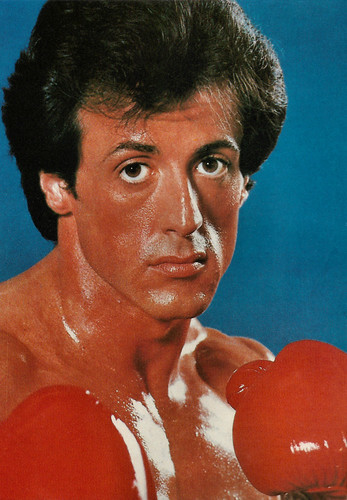
English postcard by Star-Graphics, no. S 140. Photo: Sylvester Stallone as Rocky.

English postcard by Superior, no. PC 92. Photo: Illuminations 3 + Ltd. Sylvester Stallone in Rambo - First Blood Part II (George P. Cosmatos, 1985).
The stuff of cinematic legends
Sylvester Gardenzio Stallone was born in 1946, in New York's gritty Hell's Kitchen. His parents were Jackie Stallone (née Labofish), an astrologer, and Frank Stallone, an Italian immigrant who worked as a beautician, and hairdresser.
After his parents divorced, he moved with his mother and her new husband, a pizza manufacturer, Anthony 'Tony' Filiti, to Philadelphia. His siblings are actor Frank Stallone, half-sister Toni D'Alto, and Dante Stallone. The young Stallone attended the American College of Switzerland and the University of Miami, eventually obtaining a B.A. degree.
He was 23 years old when he got his first starring role in the softcore sex film The Party at Kitty and Stud's (Morton M. Lewis, 1970) in which he played the role of Stud 'The Italian Stallion'. He was paid $200 to play the sex-craved gigolo and appeared nude. In 1976, the film was re-released as The Italian Stallion after Sly's success with Rocky (John G. Avildsen, 1976).
In between, he first struggled in small parts in films such as the thriller Klute (Alan J. Pakula, 1971) starring Jane Fonda , and the comedy Bananas (Woody Allen, 1971). He got a crucial career break alongside fellow young actors Henry Winkler and Perry King, sharing lead billing in the effectively written teen gang film The Lords of Flatbush (Martin Davidson, Stephen Verona, 1974). He also wrote the screenplay for the modestly successful film.
Further film and television roles followed, most of them in uninspiring productions except for the opportunity to play a megalomaniac, bloodthirsty race driver named "Machine Gun Joe Viterbo" opposite David Carradine in the Roger Corman-produced Death Race 2000 (Paul Bartel, 1975).
However, Stallone was also keen to be recognised as a screenwriter, not just an actor, and, inspired by the 1975 Muhammad Ali-Chuck Wepner fight in Cleveland, Stallone wrote a film script about a nobody fighter given the "million to one opportunity" to challenge for the heavyweight title. Rocky (John G. Avildsen, 1976) became the stuff of cinematic legends, scoring ten Academy Award nominations, winning the Best Picture Award of 1976, and triggering one of the most financially successful film series in history.
Whilst full credit is wholly deserved by Stallone, he was duly supported by tremendous acting from fellow cast members Talia Shire, Burgess Meredith, and Burt Young, and director John G. Avildsen gave the film an emotive, earthy appeal from start to finish. Stallone had truly arrived on his terms and offers poured in from various studios eager to secure Hollywood's hottest new star.
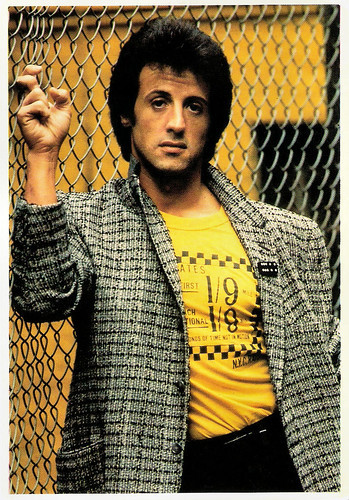
British postcard by Santoro Graphics, London, no. C201. Photo: Twentieth Century Fox. Sylvester Stallone in Rhinestone (Bob Clark, 1984).

French postcard by Editions F. Nugeron, no. Star 105. Photo: Carolco / Anabasis Investments BV. Sylvester Stallone in Rambo - First Blood Part II (George P. Cosmatos, 1985).
Green Beret John Rambo
Sylvester Stallone followed Rocky (John G. Avildsen, 1976) with F.I.S.T. (Norman Jewison, 1978), loosely based on the life of Teamsters boss Jimmy Hoffa, and Paradise Alley (Sylvester Stallone, 1978) before pulling on the boxing gloves again to resurrect Rocky Balboa in the sequel Rocky II (Sylvester Stallone, 1979). The second outing for the "Italian Stallion" wasn't as powerful or successful as the first Rocky, however, it still produced a strong box office.
Subsequent films Nighthawks (Bruce Malmuth, 1981) with Rutger Hauer , and Escape to Victory (John Huston, 1981) with Michael Caine and Pelé failed to ignite with audiences, so Stallone was once again lured back to familiar territory with Rocky III (Sylvester Stallone, 1982) and a fearsome opponent in "Clubber Lang" played by muscular ex-bodyguard, Mr. T. The third "Rocky" installment far outperformed the first sequel in box office takings, but Stallone retired his prizefighter for a couple of years as another series was about to commence for the busy actor.
The character of Green Beret "John Rambo" was the creation of Canadian-born writer David Morrell, and his novel was adapted to the screen with Stallone in the lead role in First Blood (Ted Kotcheff, 1982), also starring Richard Crenna and Brian Dennehy. The film was a surprise hit that polarised audiences because of its commentary about the Vietnam war, which was still relatively fresh in the American public's psyche.
Political viewpoints aside, the film was a worldwide smash, and a sequel soon followed with Rambo: First Blood Part II (George P. Cosmatos, 1985), which drew even stronger criticism from several quarters owing to the film's plotline about American MIAs allegedly being held in Vietnam. But they say there is no such thing as bad publicity, and "John Rambo's" second adventure was a major money-spinner for Stallone and cemented him as one of the top male stars of the 1980s.
In between, he did his own singing in Rhinestone (Bob Clark, 1984) with Dolly Parton. Riding a wave of amazing popularity, Stallone called on old sparring partner Rocky Balboa to climb back into the ring to defend American pride against a Soviet threat in the form of a towering Russian boxer named "Ivan Drago" played by curt Dolph Lundgren in Rocky IV (Sylvester Stallone, 1985). The fourth outing was somewhat controversial with "Rocky" fans, as violence levels seemed excessive compared to previous "Rocky" films, especially with the savage beating suffered by Apollo Creed, played by Carl Weathers, at the hands of the unstoppable "Siberian Express".
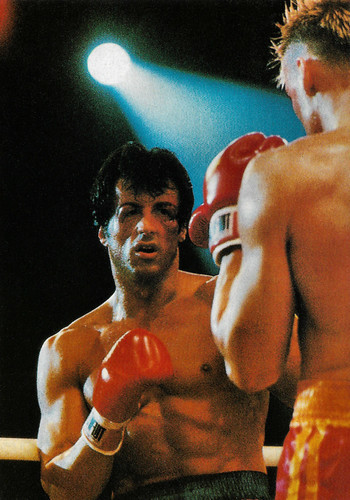
Italian postcard by Vittorius, Roma (Rome), no. VR 510. Sylvester Stallone and Dolph Lundgren in Rocky IV (Sylvester Stallone, 1985).
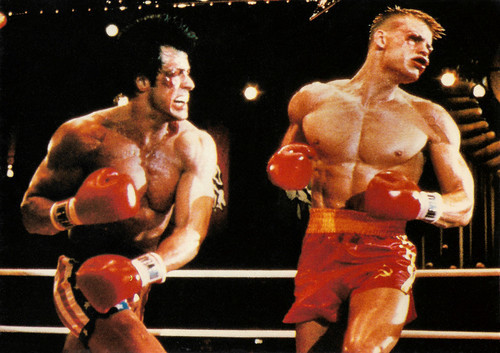
English postcard by Star-Graphics, London, no. S 133. Sylvester Stallone and Dolph Lundgren in Rocky IV (Sylvester Stallone, 1985).
Worst Actor of the Century award
Sylvester Stallone continued forward with a slew of macho character-themed films that met with a mixed reception from his fans. Cobra (George P. Cosmatos, 1986) with his wife Brigitte Nielsen was a clumsy mess, Over the Top (Menahem Golan, 1987) was equally mediocre, Rambo III (Peter MacDonald, 1988) saw Rambo take on the Russians in Afghanistan, and cop buddy film Tango & Cash (Andrey Konchalovskiy, 1989) just did not quite hit the mark, although it did feature a top-notch cast and there was chemistry between Stallone and co-star Kurt Russell.
Philadelphia's favourite mythical boxer moved out of the shadows for his fifth screen outing in Rocky V (John G. Avildsen, 1990) tackling Tommy "Machine" Gunn played by real-life heavyweight fighter Tommy Morrison, the great-nephew of screen legend John Wayne .
Sly quickly followed with the lukewarm comedy Oscar (John Landis, 1991) with Ornella Muti , the painfully unfunny Stop! Or My Mom Will Shoot (Roger Spottiswoode, 1992) with "Golden Girl" Estelle Getty, the futuristic action film Demolition Man (Marco Brambilla, 1993) with Wesley Snipes and Sandra Bullock, and the comic book-inspired Judge Dredd (Danny Cannon, 1995).
Interestingly, Stallone then took a departure from the gung-ho steely characters he had been portraying to stack on a few extra pounds and tackle a more dramatically challenging role in the intriguing Cop Land (James Mangold, 1997), also starring Harvey Keitel, Robert De Niro , and Ray Liotta. It isn't a classic of the genre, but Cop Land (1997) certainly surprised many critics with Stallone's understated performance.
He has been nominated a record 30 times for the Golden Raspberry Awards, usually in the "Worst Actor" category, and has won 10 times. The Golden Raspberry Award Foundation awarded him a special "Worst Actor of the Century" award in 2000.
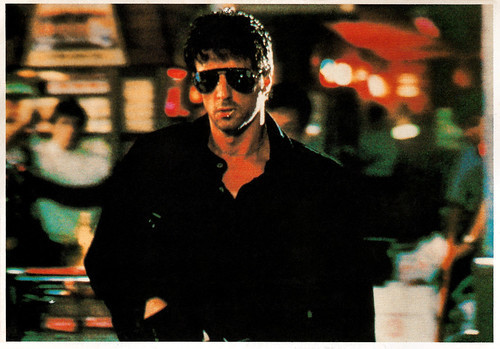
English postcard, no. FA 220. Sent by mail in 1991. Sylvester Stallone in Cobra (George P. Cosmatos, 1986).
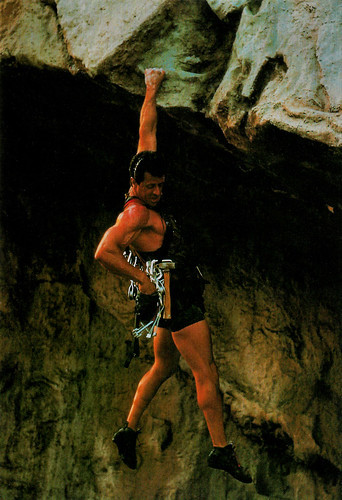
French postcard, no. C 451. Sylvester Stallone in Cliffhanger (Renny Harlin, 1993).
An enviable and highly respected career in Hollywood
Sylvester Stallone lent his voice to the animated adventure story Antz (Eric Darnell, Tim Johnson, 1998), reprised the role made famous by Michael Caine in a terrible remake of Get Carter (Stephen Kay, 2000), climbed back into a race car for Driven (Renny Harlin, 2001), and guest-starred as the 'Toymaker' in the third chapter of the popular 'Spy Kids' film series, Spy Kids 3: Game Over (Robert Rodriguez, 2003).
In 2005 he published his book 'Sly Moves: My Proven Program to Lose Weight, Build Strength, Gain Will Power, and Live Your Dream'. Showing that age had not wearied his two most popular series, Sylvester Stallone brought back never-say-die boxer Rocky Balboa to star in Rocky Balboa (Sylvester Stallone, 2006), and Vietnam veteran Rambo reappeared after a 20-year hiatus to once again right wrongs in the jungles of Thailand in Rambo (Sylvester Stallone, 2008).
Another success was The Expendables (Sylvester Stallone, 2010), abound a band of highly skilled mercenaries played by Bruce Willis, Arnold Schwarzenegger , and other 'dinosaurs' from the 1980s action film teamed up with each other. The action film opened at number one at the U.S. box office with a first weekend gross of $35 million.
This makes Sylvester Stallone the only person in Hollywood history to have starred in films that have opened atop the box office charts over five consecutive decades. Soon followed the less successful sequels The Expendables 2 (Simon West, 2012) and The Expendables 3 (Patrick Hughes, 2014).
In between, he also appeared with Schwarzenegger in Escape Plan (Mikael Håfström, 2013). Stallone got rave reviews, his first Golden Globe, and an Oscar nomination for his role in the sports film Creed (Ryan Coogler, 2015) opposite Michael B. Jordan. Once again he played Rocky Balboa who serves as a trainer and mentor to Adonis Johnson, the son of his late friend and former rival Apollo Creed.
In 2017, Stallone appeared in Guardians of the Galaxy Vol. 2 (James Gunn, 2017) as Stakar Ogord / Starhawk, the leader of a Ravagers faction. Then followed Creed II (Steven Caple Jr., 2018) and Rambo: Last Blood (Adrian Grunberg, 2019). The latter film grossed $91 million worldwide against a production budget of $50 million.
Sylvester Stallone married three times. His first wife was Sasha Czack (1974-1985) with whom he has two children: Sage and Seargeoh Stallone. Sage acted with Sylvester in Rocky V (1990) and Daylight (1996) and was found dead in 2012 in Los Angeles. From 1985 till 1987, Sly was married to Danish actress Brigitte Nielsen. Since 1997, he is married to Jennifer Flavin, with whom he has three children: Sophia Rose, Sistine Rose, and Scarlet Rose Stallone.
Firehouse at IMDb : "Love him or loathe him, Sylvester Stallone has built an enviable and highly respected career in Hollywood, plus, he has considerably influenced modern popular culture through several of his iconic film characters."
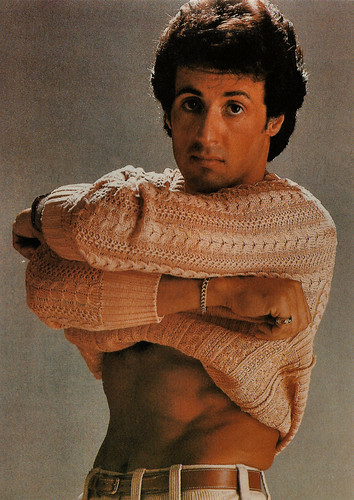
English postcard.
Sources: Wikipedia and .

English postcard by Star-Graphics, no. S 140. Photo: Sylvester Stallone as Rocky.

English postcard by Superior, no. PC 92. Photo: Illuminations 3 + Ltd. Sylvester Stallone in Rambo - First Blood Part II (George P. Cosmatos, 1985).
The stuff of cinematic legends
Sylvester Gardenzio Stallone was born in 1946, in New York's gritty Hell's Kitchen. His parents were Jackie Stallone (née Labofish), an astrologer, and Frank Stallone, an Italian immigrant who worked as a beautician, and hairdresser.
After his parents divorced, he moved with his mother and her new husband, a pizza manufacturer, Anthony 'Tony' Filiti, to Philadelphia. His siblings are actor Frank Stallone, half-sister Toni D'Alto, and Dante Stallone. The young Stallone attended the American College of Switzerland and the University of Miami, eventually obtaining a B.A. degree.
He was 23 years old when he got his first starring role in the softcore sex film The Party at Kitty and Stud's (Morton M. Lewis, 1970) in which he played the role of Stud 'The Italian Stallion'. He was paid $200 to play the sex-craved gigolo and appeared nude. In 1976, the film was re-released as The Italian Stallion after Sly's success with Rocky (John G. Avildsen, 1976).
In between, he first struggled in small parts in films such as the thriller Klute (Alan J. Pakula, 1971) starring Jane Fonda , and the comedy Bananas (Woody Allen, 1971). He got a crucial career break alongside fellow young actors Henry Winkler and Perry King, sharing lead billing in the effectively written teen gang film The Lords of Flatbush (Martin Davidson, Stephen Verona, 1974). He also wrote the screenplay for the modestly successful film.
Further film and television roles followed, most of them in uninspiring productions except for the opportunity to play a megalomaniac, bloodthirsty race driver named "Machine Gun Joe Viterbo" opposite David Carradine in the Roger Corman-produced Death Race 2000 (Paul Bartel, 1975).
However, Stallone was also keen to be recognised as a screenwriter, not just an actor, and, inspired by the 1975 Muhammad Ali-Chuck Wepner fight in Cleveland, Stallone wrote a film script about a nobody fighter given the "million to one opportunity" to challenge for the heavyweight title. Rocky (John G. Avildsen, 1976) became the stuff of cinematic legends, scoring ten Academy Award nominations, winning the Best Picture Award of 1976, and triggering one of the most financially successful film series in history.
Whilst full credit is wholly deserved by Stallone, he was duly supported by tremendous acting from fellow cast members Talia Shire, Burgess Meredith, and Burt Young, and director John G. Avildsen gave the film an emotive, earthy appeal from start to finish. Stallone had truly arrived on his terms and offers poured in from various studios eager to secure Hollywood's hottest new star.

British postcard by Santoro Graphics, London, no. C201. Photo: Twentieth Century Fox. Sylvester Stallone in Rhinestone (Bob Clark, 1984).

French postcard by Editions F. Nugeron, no. Star 105. Photo: Carolco / Anabasis Investments BV. Sylvester Stallone in Rambo - First Blood Part II (George P. Cosmatos, 1985).
Green Beret John Rambo
Sylvester Stallone followed Rocky (John G. Avildsen, 1976) with F.I.S.T. (Norman Jewison, 1978), loosely based on the life of Teamsters boss Jimmy Hoffa, and Paradise Alley (Sylvester Stallone, 1978) before pulling on the boxing gloves again to resurrect Rocky Balboa in the sequel Rocky II (Sylvester Stallone, 1979). The second outing for the "Italian Stallion" wasn't as powerful or successful as the first Rocky, however, it still produced a strong box office.
Subsequent films Nighthawks (Bruce Malmuth, 1981) with Rutger Hauer , and Escape to Victory (John Huston, 1981) with Michael Caine and Pelé failed to ignite with audiences, so Stallone was once again lured back to familiar territory with Rocky III (Sylvester Stallone, 1982) and a fearsome opponent in "Clubber Lang" played by muscular ex-bodyguard, Mr. T. The third "Rocky" installment far outperformed the first sequel in box office takings, but Stallone retired his prizefighter for a couple of years as another series was about to commence for the busy actor.
The character of Green Beret "John Rambo" was the creation of Canadian-born writer David Morrell, and his novel was adapted to the screen with Stallone in the lead role in First Blood (Ted Kotcheff, 1982), also starring Richard Crenna and Brian Dennehy. The film was a surprise hit that polarised audiences because of its commentary about the Vietnam war, which was still relatively fresh in the American public's psyche.
Political viewpoints aside, the film was a worldwide smash, and a sequel soon followed with Rambo: First Blood Part II (George P. Cosmatos, 1985), which drew even stronger criticism from several quarters owing to the film's plotline about American MIAs allegedly being held in Vietnam. But they say there is no such thing as bad publicity, and "John Rambo's" second adventure was a major money-spinner for Stallone and cemented him as one of the top male stars of the 1980s.
In between, he did his own singing in Rhinestone (Bob Clark, 1984) with Dolly Parton. Riding a wave of amazing popularity, Stallone called on old sparring partner Rocky Balboa to climb back into the ring to defend American pride against a Soviet threat in the form of a towering Russian boxer named "Ivan Drago" played by curt Dolph Lundgren in Rocky IV (Sylvester Stallone, 1985). The fourth outing was somewhat controversial with "Rocky" fans, as violence levels seemed excessive compared to previous "Rocky" films, especially with the savage beating suffered by Apollo Creed, played by Carl Weathers, at the hands of the unstoppable "Siberian Express".

Italian postcard by Vittorius, Roma (Rome), no. VR 510. Sylvester Stallone and Dolph Lundgren in Rocky IV (Sylvester Stallone, 1985).

English postcard by Star-Graphics, London, no. S 133. Sylvester Stallone and Dolph Lundgren in Rocky IV (Sylvester Stallone, 1985).
Worst Actor of the Century award
Sylvester Stallone continued forward with a slew of macho character-themed films that met with a mixed reception from his fans. Cobra (George P. Cosmatos, 1986) with his wife Brigitte Nielsen was a clumsy mess, Over the Top (Menahem Golan, 1987) was equally mediocre, Rambo III (Peter MacDonald, 1988) saw Rambo take on the Russians in Afghanistan, and cop buddy film Tango & Cash (Andrey Konchalovskiy, 1989) just did not quite hit the mark, although it did feature a top-notch cast and there was chemistry between Stallone and co-star Kurt Russell.
Philadelphia's favourite mythical boxer moved out of the shadows for his fifth screen outing in Rocky V (John G. Avildsen, 1990) tackling Tommy "Machine" Gunn played by real-life heavyweight fighter Tommy Morrison, the great-nephew of screen legend John Wayne .
Sly quickly followed with the lukewarm comedy Oscar (John Landis, 1991) with Ornella Muti , the painfully unfunny Stop! Or My Mom Will Shoot (Roger Spottiswoode, 1992) with "Golden Girl" Estelle Getty, the futuristic action film Demolition Man (Marco Brambilla, 1993) with Wesley Snipes and Sandra Bullock, and the comic book-inspired Judge Dredd (Danny Cannon, 1995).
Interestingly, Stallone then took a departure from the gung-ho steely characters he had been portraying to stack on a few extra pounds and tackle a more dramatically challenging role in the intriguing Cop Land (James Mangold, 1997), also starring Harvey Keitel, Robert De Niro , and Ray Liotta. It isn't a classic of the genre, but Cop Land (1997) certainly surprised many critics with Stallone's understated performance.
He has been nominated a record 30 times for the Golden Raspberry Awards, usually in the "Worst Actor" category, and has won 10 times. The Golden Raspberry Award Foundation awarded him a special "Worst Actor of the Century" award in 2000.

English postcard, no. FA 220. Sent by mail in 1991. Sylvester Stallone in Cobra (George P. Cosmatos, 1986).

French postcard, no. C 451. Sylvester Stallone in Cliffhanger (Renny Harlin, 1993).
An enviable and highly respected career in Hollywood
Sylvester Stallone lent his voice to the animated adventure story Antz (Eric Darnell, Tim Johnson, 1998), reprised the role made famous by Michael Caine in a terrible remake of Get Carter (Stephen Kay, 2000), climbed back into a race car for Driven (Renny Harlin, 2001), and guest-starred as the 'Toymaker' in the third chapter of the popular 'Spy Kids' film series, Spy Kids 3: Game Over (Robert Rodriguez, 2003).
In 2005 he published his book 'Sly Moves: My Proven Program to Lose Weight, Build Strength, Gain Will Power, and Live Your Dream'. Showing that age had not wearied his two most popular series, Sylvester Stallone brought back never-say-die boxer Rocky Balboa to star in Rocky Balboa (Sylvester Stallone, 2006), and Vietnam veteran Rambo reappeared after a 20-year hiatus to once again right wrongs in the jungles of Thailand in Rambo (Sylvester Stallone, 2008).
Another success was The Expendables (Sylvester Stallone, 2010), abound a band of highly skilled mercenaries played by Bruce Willis, Arnold Schwarzenegger , and other 'dinosaurs' from the 1980s action film teamed up with each other. The action film opened at number one at the U.S. box office with a first weekend gross of $35 million.
This makes Sylvester Stallone the only person in Hollywood history to have starred in films that have opened atop the box office charts over five consecutive decades. Soon followed the less successful sequels The Expendables 2 (Simon West, 2012) and The Expendables 3 (Patrick Hughes, 2014).
In between, he also appeared with Schwarzenegger in Escape Plan (Mikael Håfström, 2013). Stallone got rave reviews, his first Golden Globe, and an Oscar nomination for his role in the sports film Creed (Ryan Coogler, 2015) opposite Michael B. Jordan. Once again he played Rocky Balboa who serves as a trainer and mentor to Adonis Johnson, the son of his late friend and former rival Apollo Creed.
In 2017, Stallone appeared in Guardians of the Galaxy Vol. 2 (James Gunn, 2017) as Stakar Ogord / Starhawk, the leader of a Ravagers faction. Then followed Creed II (Steven Caple Jr., 2018) and Rambo: Last Blood (Adrian Grunberg, 2019). The latter film grossed $91 million worldwide against a production budget of $50 million.
Sylvester Stallone married three times. His first wife was Sasha Czack (1974-1985) with whom he has two children: Sage and Seargeoh Stallone. Sage acted with Sylvester in Rocky V (1990) and Daylight (1996) and was found dead in 2012 in Los Angeles. From 1985 till 1987, Sly was married to Danish actress Brigitte Nielsen. Since 1997, he is married to Jennifer Flavin, with whom he has three children: Sophia Rose, Sistine Rose, and Scarlet Rose Stallone.
Firehouse at IMDb : "Love him or loathe him, Sylvester Stallone has built an enviable and highly respected career in Hollywood, plus, he has considerably influenced modern popular culture through several of his iconic film characters."

English postcard.
Sources: Wikipedia and .
Published on April 08, 2021 22:00
April 7, 2021
Cinema-Illustrazione, Part 2
The popular Italian magazine Cinema-Illustrazione, founded in 1930, published a great series of postcards with female Hollywood film stars during the early 1930s. Last Thursday, EFSP did a post with glamorous postcards of the first Cinema-Illustrazione series. Today we continue with a second post with more cards from the first series and next week we'll present the second series.
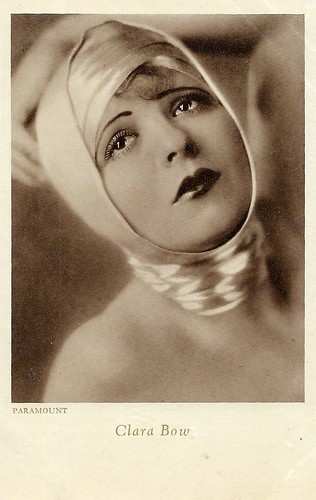
Italian postcard by Cinema-Illustrazione, Milano, series 1, no. 16. Photo: Paramount.
American actress Clara Bow (1905-1965) rose to stardom in silent films during the 1920s. It was her appearance as a plucky shopgirl in the film It (Clarence G. Badger, 1927) that brought her global fame and the nickname 'The It Girl'. Bow came to personify the Roaring Twenties and is described as its leading sex symbol.
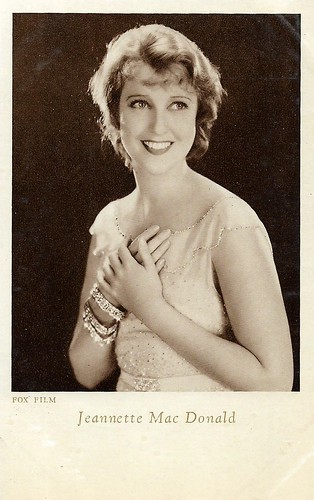
Italian postcard by Cinema-Illustrazione, series 1, no. 19. Photo: Fox Film.
Red-headed and blue-green-eyed operatic singer Jeanette MacDonald (1903-1965) was discovered for the cinema by Ernst Lubitsch, who cast her opposite Maurice Chevalier in The Love Parade (1929). Later 'the Iron Butterfly' co-starred with Nelson Eddy in a string of successful musicals and played opposite Clark Gable in San Francisco (1936).
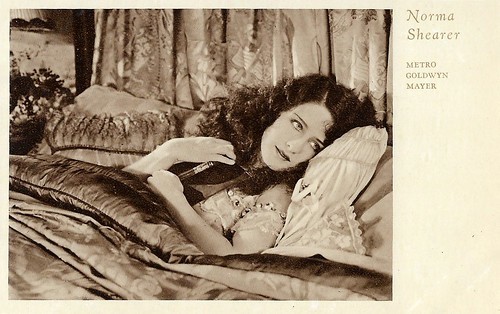
Italian postcard by Cinema-Illustrazione, series 1, no. 20. Photo: Metro-Goldwyn-Mayer.
American actress Norma Shearer (1902-1983) was the 'First Lady of MGM'. She often played spunky, sexually liberated ingenues, and was the first person to be nominated five times for an Academy Award for acting. Shearer won the Best Actress Oscar for The Divorcee (1930).
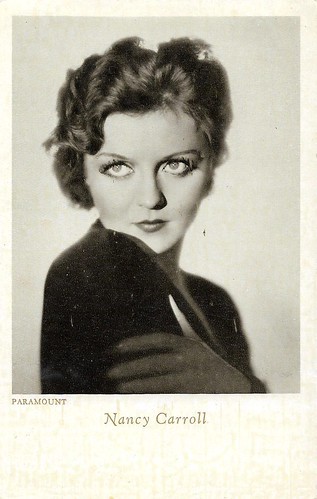
Italian postcard by Cinema-Illustrazione, Milano, series 1, no. 26. Photo: Paramount.
Red-haired, cupid-bow-mouthed Nancy Carroll (1903-1965) became a very popular Hollywood star upon the advent of sound film because of her singing and dancing abilities. She was reported to have received more fan mail than any of her Hollywood peers of the same era. As she expanded her acting range from flaming flapper to ditzy comedienne to sensitive heroine, she was nominated for an Oscar for The Devil's Holiday (1930).
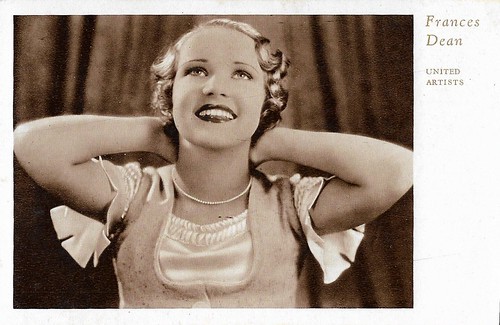
Italian postcard by Cinema-Illustrazione, Milano, series 1, no. 27. Photo: United Artists.
Betty Grable (1916-1973) was between 1931 and 1932 credited in American films as Frances Dean, and hence as Betty Grable. Grable was known as 'The Girl With the Million Dollar Legs'. During World War II, the quicksilver blonde's famous pin-up pose - in a bathing suit, back to the camera, smiling over her right shoulder - adorned barracks all around the world. Her 42 films during the 1930s, 1940s, and 1950s grossed more than $100 million. One of her biggest successes was the comedy How to Marry a Millionaire (1953), which was also one of her last films.
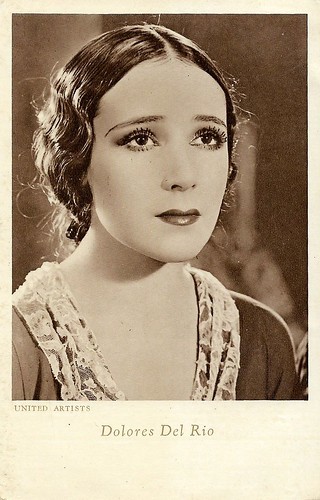
Italian postcard by Cinema-Illustrazione, Milano, series 1, no. 29. Photo: United Artists.
Mexican and American actress Dolores del Río (1905–1983) was a Hollywood star in the 1920s and 1930s, and one of the most important female actresses of the Golden Age of Mexican cinema in the 1940s and 1950s. Del Río was the first major Latin cross-over star in Hollywood and was considered one of the most beautiful faces that have emerged in Hollywood cinema. She also appeared in several European films.
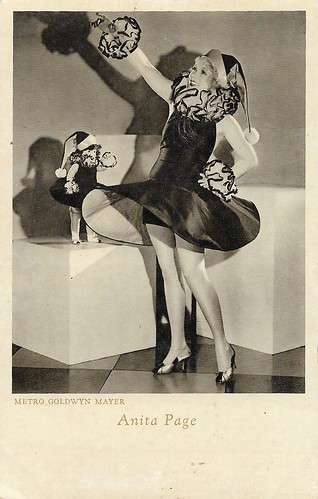
Italian postcard by Cinema-Illustrazione, Milano, series 1, no. 30. Photo: Metro-Goldwyn-Mayer.
Beautiful Anita Page (1910–2008) was one of the most popular leading ladies of Hollywood during the last years of the silent screen and the first years of the sound era.
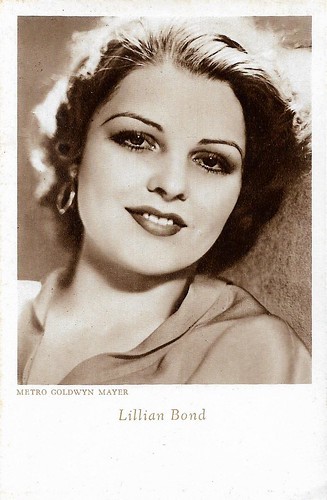
Italian postcard nu Cinema-Illustrazione, Milano, series 1, no. 31. Photo: Metro-Goldwyn-Mayer.
Lovely British actress Lilian Bond (1908-1991) made over 50 films in Hollywood from the late 1920s through the 1940s. One of her first roles was in James Whale’s classic horror-comedy The Old Dark House (1932), but in later years she mostly appeared in B-movies, both in leading parts and in bit roles. Possibly her best-known film role was in the Western The Westerner (1940) starring Gary Cooper and Walter Brennan, in which she played Lillie Langtry.
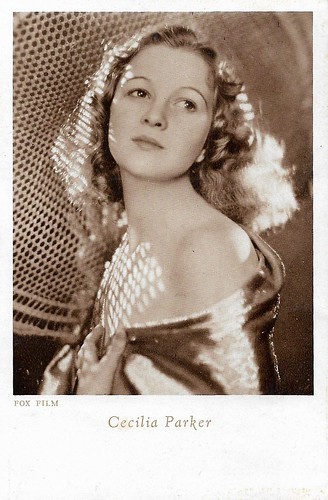
Italian postcard by Cinema-Illustrazione, Milano, series 1, no. 32. Photo: Fox Film.
Canadian-born Cecilia Parker (1914-1993) moved with her family to Hollywood when she was a child. She did extra work for about a year before she was noticed by Fox executives, who signed her to a contract in 1931. After several uncredited parts such as the maid in James Whale's Frankenstein (1931), Parker had her first major supporting role in the George O'Brien Western The Rainbow Trail (1932). Several Westerns and action movies with heroes such as O'Brien, Tom Tyler, Ken Maynard, Buck Jones, and others would follow. In 1937 Parker had a breakthrough when she was signed by MGM to play Marian Hardy, the older sister of Mickey Rooney in the Andy Hardy series. It's this part that people remember her for.
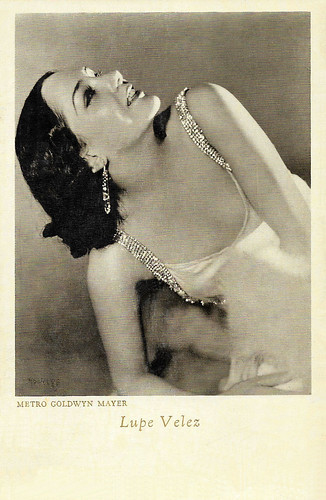
Italian postcard by Cinema-Illustrazione, Milano, series 1, no. 36. Photo: Metro-Goldwyn-Mayer.
Lupe Velez (1908-1944), was one of the first Mexican actresses to succeed in Hollywood. Her nicknames were 'The Mexican Spitfire' and 'Hot Pepper'. She was the leading lady in such silent films as The Gaucho (1927), Lady of the Pavements (1928), and Wolf Song (1929). During the 1930s, her well-known explosive screen persona was exploited in a series of successful films like Hot Pepper (1933), Strictly Dynamite (1934), and Hollywood Party (1934). In the 1940s, Vélez's popularity peaked after appearing in the Mexican Spitfire films. In 1944, Vélez died of an intentional overdose of the barbiturate drug Seconal.
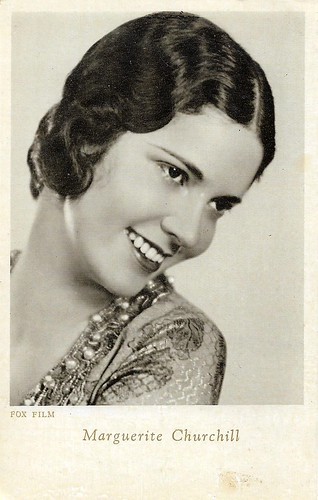
Italian postcard by Cinema-Illustrazione, Milano, series 1, no. 37. Photo: Fox Film.
Marguerite Churchill (1910-2000) was an American film actress with a film career spanning from 1929 to 1952. She is best known today as John Wayne's first leading lady, in The Big Trail (1930).
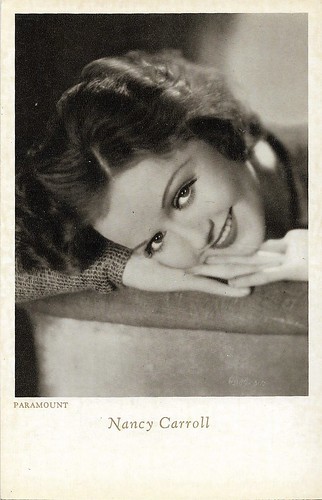
Italian postcard by Cinema-Illustrazione, Milano, series 1, no. 38. Photo: Paramount.
Red-haired, cupid-bow-mouthed Nancy Carroll (1903-1965) became a very popular Hollywood star upon the advent of sound film because of her singing and dancing abilities. She was reported to have received more fan mail than any of her Hollywood peers of the same era. As she expanded her acting range from flaming flapper to ditzy comedienne to sensitive heroine, she was nominated for an Oscar for The Devil's Holiday (1930).
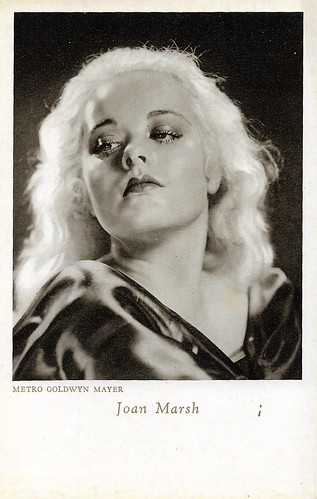
Italian postcard by Cinema-Illustrazione, Milano, series 1, no. 39. Photo: Metro-Goldwyn-Mayer.
Joan Marsh (1913-2000) was a brassy, blue-eyed platinum blonde of the 1930s in the Jean Harlow tradition. As a child, she appeared between 1915 and 1921 in silent films starring Mary Pickford on which her father worked as a cameraman. Later, during the sound era, she resumed her acting career and performed in a variety of films during the 1930s and 1940s.
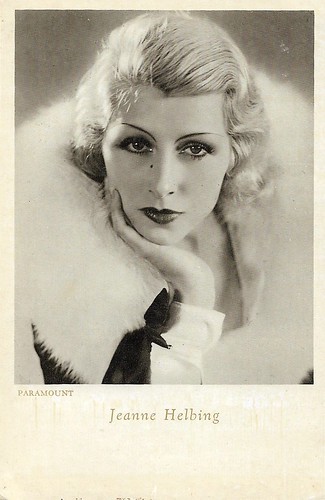
Italian postcard by Cinema-Illustrazione, Milano, series 1, no. 40. Photo: Paramount.
Jeanne Helbling was an actress of the French cinema of the 1920s and 1930s, who was extremely active in early French sound film. She was also a Resistance heroine.
To be continued next week, Thursday 15 April.
For the editions of the magazine Cinema-Illustrazione between 1930 and 1939, see the website of the Centro Sperimentale.

Italian postcard by Cinema-Illustrazione, Milano, series 1, no. 16. Photo: Paramount.
American actress Clara Bow (1905-1965) rose to stardom in silent films during the 1920s. It was her appearance as a plucky shopgirl in the film It (Clarence G. Badger, 1927) that brought her global fame and the nickname 'The It Girl'. Bow came to personify the Roaring Twenties and is described as its leading sex symbol.

Italian postcard by Cinema-Illustrazione, series 1, no. 19. Photo: Fox Film.
Red-headed and blue-green-eyed operatic singer Jeanette MacDonald (1903-1965) was discovered for the cinema by Ernst Lubitsch, who cast her opposite Maurice Chevalier in The Love Parade (1929). Later 'the Iron Butterfly' co-starred with Nelson Eddy in a string of successful musicals and played opposite Clark Gable in San Francisco (1936).

Italian postcard by Cinema-Illustrazione, series 1, no. 20. Photo: Metro-Goldwyn-Mayer.
American actress Norma Shearer (1902-1983) was the 'First Lady of MGM'. She often played spunky, sexually liberated ingenues, and was the first person to be nominated five times for an Academy Award for acting. Shearer won the Best Actress Oscar for The Divorcee (1930).

Italian postcard by Cinema-Illustrazione, Milano, series 1, no. 26. Photo: Paramount.
Red-haired, cupid-bow-mouthed Nancy Carroll (1903-1965) became a very popular Hollywood star upon the advent of sound film because of her singing and dancing abilities. She was reported to have received more fan mail than any of her Hollywood peers of the same era. As she expanded her acting range from flaming flapper to ditzy comedienne to sensitive heroine, she was nominated for an Oscar for The Devil's Holiday (1930).

Italian postcard by Cinema-Illustrazione, Milano, series 1, no. 27. Photo: United Artists.
Betty Grable (1916-1973) was between 1931 and 1932 credited in American films as Frances Dean, and hence as Betty Grable. Grable was known as 'The Girl With the Million Dollar Legs'. During World War II, the quicksilver blonde's famous pin-up pose - in a bathing suit, back to the camera, smiling over her right shoulder - adorned barracks all around the world. Her 42 films during the 1930s, 1940s, and 1950s grossed more than $100 million. One of her biggest successes was the comedy How to Marry a Millionaire (1953), which was also one of her last films.

Italian postcard by Cinema-Illustrazione, Milano, series 1, no. 29. Photo: United Artists.
Mexican and American actress Dolores del Río (1905–1983) was a Hollywood star in the 1920s and 1930s, and one of the most important female actresses of the Golden Age of Mexican cinema in the 1940s and 1950s. Del Río was the first major Latin cross-over star in Hollywood and was considered one of the most beautiful faces that have emerged in Hollywood cinema. She also appeared in several European films.

Italian postcard by Cinema-Illustrazione, Milano, series 1, no. 30. Photo: Metro-Goldwyn-Mayer.
Beautiful Anita Page (1910–2008) was one of the most popular leading ladies of Hollywood during the last years of the silent screen and the first years of the sound era.

Italian postcard nu Cinema-Illustrazione, Milano, series 1, no. 31. Photo: Metro-Goldwyn-Mayer.
Lovely British actress Lilian Bond (1908-1991) made over 50 films in Hollywood from the late 1920s through the 1940s. One of her first roles was in James Whale’s classic horror-comedy The Old Dark House (1932), but in later years she mostly appeared in B-movies, both in leading parts and in bit roles. Possibly her best-known film role was in the Western The Westerner (1940) starring Gary Cooper and Walter Brennan, in which she played Lillie Langtry.

Italian postcard by Cinema-Illustrazione, Milano, series 1, no. 32. Photo: Fox Film.
Canadian-born Cecilia Parker (1914-1993) moved with her family to Hollywood when she was a child. She did extra work for about a year before she was noticed by Fox executives, who signed her to a contract in 1931. After several uncredited parts such as the maid in James Whale's Frankenstein (1931), Parker had her first major supporting role in the George O'Brien Western The Rainbow Trail (1932). Several Westerns and action movies with heroes such as O'Brien, Tom Tyler, Ken Maynard, Buck Jones, and others would follow. In 1937 Parker had a breakthrough when she was signed by MGM to play Marian Hardy, the older sister of Mickey Rooney in the Andy Hardy series. It's this part that people remember her for.

Italian postcard by Cinema-Illustrazione, Milano, series 1, no. 36. Photo: Metro-Goldwyn-Mayer.
Lupe Velez (1908-1944), was one of the first Mexican actresses to succeed in Hollywood. Her nicknames were 'The Mexican Spitfire' and 'Hot Pepper'. She was the leading lady in such silent films as The Gaucho (1927), Lady of the Pavements (1928), and Wolf Song (1929). During the 1930s, her well-known explosive screen persona was exploited in a series of successful films like Hot Pepper (1933), Strictly Dynamite (1934), and Hollywood Party (1934). In the 1940s, Vélez's popularity peaked after appearing in the Mexican Spitfire films. In 1944, Vélez died of an intentional overdose of the barbiturate drug Seconal.

Italian postcard by Cinema-Illustrazione, Milano, series 1, no. 37. Photo: Fox Film.
Marguerite Churchill (1910-2000) was an American film actress with a film career spanning from 1929 to 1952. She is best known today as John Wayne's first leading lady, in The Big Trail (1930).

Italian postcard by Cinema-Illustrazione, Milano, series 1, no. 38. Photo: Paramount.
Red-haired, cupid-bow-mouthed Nancy Carroll (1903-1965) became a very popular Hollywood star upon the advent of sound film because of her singing and dancing abilities. She was reported to have received more fan mail than any of her Hollywood peers of the same era. As she expanded her acting range from flaming flapper to ditzy comedienne to sensitive heroine, she was nominated for an Oscar for The Devil's Holiday (1930).

Italian postcard by Cinema-Illustrazione, Milano, series 1, no. 39. Photo: Metro-Goldwyn-Mayer.
Joan Marsh (1913-2000) was a brassy, blue-eyed platinum blonde of the 1930s in the Jean Harlow tradition. As a child, she appeared between 1915 and 1921 in silent films starring Mary Pickford on which her father worked as a cameraman. Later, during the sound era, she resumed her acting career and performed in a variety of films during the 1930s and 1940s.

Italian postcard by Cinema-Illustrazione, Milano, series 1, no. 40. Photo: Paramount.
Jeanne Helbling was an actress of the French cinema of the 1920s and 1930s, who was extremely active in early French sound film. She was also a Resistance heroine.
To be continued next week, Thursday 15 April.
For the editions of the magazine Cinema-Illustrazione between 1930 and 1939, see the website of the Centro Sperimentale.
Published on April 07, 2021 22:00
April 6, 2021
Michael Bohnen
Michael Bohnen (1887-1965) was a German bass-baritone opera singer who performed at Covent Garden, the Bayreuth Festival, and the Metropolitan Opera in New York. He was also popular as a stage and screen actor, but a false testimony against him caused that Bohnen died in poverty.
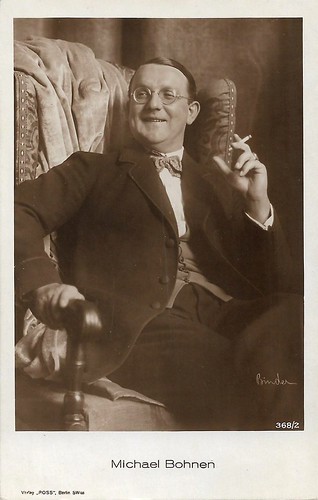
German postcard by Ross Verlag, no. 368/2. Photo: [Alex] Binder.
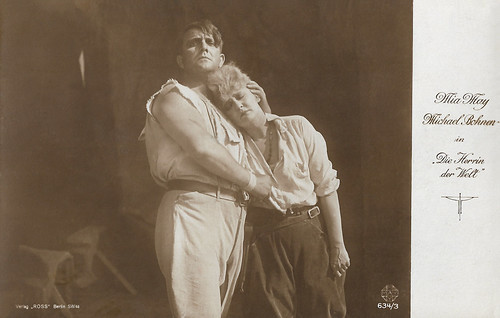
German postcard by Ross Verlag, no. 634/3. Photo: May Film. Mia May as Maud Gregaard and Michael Bohnen as Consul Madsen in Die Herrin der Welt/Mistress of the World (Joe May and others, 1919).
His massive voice and imposing stature
Franz Michael Bohnen was born in Cologne, Germany, in 1887. He trained as an opera singer (bass-baritone) at the Conservatory in Cologne and through private lessons.
He made his debut at the Stadttheater Düsseldorf in 1910 and performed at the Hoftheater Wiesbaden in 1912. Since 1912 he was a member of the Hofoper Berlin, where his star status as an opera singer was confirmed in 1914 when replacing a colleague as Gurnemanz in Wagner's 'Parsifal'.
In 1914 he also made an impression in Wagner operas at Covent Garden and the Bayreuth Festival. He was called to military service but after an illness in 1916, he could continue at the Berlin Hofoper.
When Richard Strauss, interim at the Hofoper, moved to Berlin, Bohnen joined him and successfully sang the part of Baron Ochs von Lerchenau in Strauss' 'Rosenkavalier', a part he would later repeat in the film version Der Rosenkavalier (Robert Wiene, 1925-1926), starring Huguette Duflos as the Marschallin.
Bohnen often performed at the Metropolitan Opera in New York from 1922 to 1933, and from 1933 to 1934 he made guest appearances in Buenos Aires. His massive voice and imposing stature impressed many.
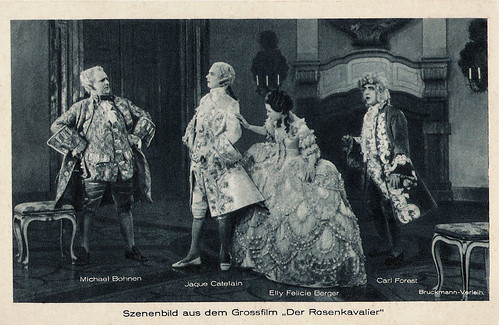
German postcard by Ross B.V.G., Berlin. Photo: Verleih Filmhaus Bruckmann & Co., A.G. Jaque Catelain , Michael Bohnen, Ellie Felicie Berger and Carl Forest in Der Rosenkavalier/The Knight of the Rose (Robert Wiene, 1925).
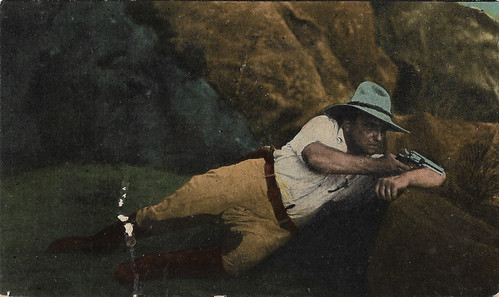
Spanish collectors card by Chocolat Imperiale, Barcelona. Photo; Distr. J. Gurgui, Barcelona / May Film. Michael Bohnen in the German silent film serial Die Herrin der Welt/The Mistress of the World (Joe May, a.o., 1919), starring Mia May . Day 4, No. 5. Spanish film title: La dueñá del mundo.
He-man and love interest
In Germany, Michael Bohnen meanwhile had also gained great popularity as a film actor. He debuted on-screen in Ernst Reicher 's biblical film Das Buch Esther (1919).
Then he had a major part as he-man and love interest of Mia May in the first five episodes of Die Herrin der Welt/Mistress of the World (Joe May and several others, 1919-1920), which gave him his breakthrough.
He temporarily owned his own film company, Bohnen-Film GmbH (1920–1922), although most titles are forgotten films now, such as Präsident Barrada/President Barrada (Erik Lund, 1920).
In 1922 he acted in the opera adaptation Tiefland/Lowlands (Adolf Licho, 1922) while in 1926 he acted opposite Ellen Richter in Kopf hoch, Charly/Heads Up, Charley (Ludwig Wolff, 1926).
Bohnen continued with operetta films such as Der Zigeunerbaron/The Gypsy Baron (Friedrich Zelnik, 1927) with Lya Mara and the German early sound film Viktoria und ihr Husar/Victoria and Her Hussar (Richard Oswald, 1931) with Ivan Petrovich and Friedel Schuster.
Bohnen also acted opposite Hans Albers and Brigitte Helm in Gold (Karl Hartl, 1934), while he was Louis XIV in Liselotte von der Pfalz. Frauen um den Sonnenkönig/The Private Life of Louis XIV (Carl Froehlich, 1935) and the Saxon King August the Strong in Der Gefangene des Königs/The King's Prisoner (Carl Boese, 1935) and in the homonymous August der Stärke/Augustus the Strong (Paul Wegener, 1935).
His muscle strength, which he already displayed as the bare-chested savior in Die Herrin der Welt, became legendary. His colleague Lil Dagover describes in her autobiography how, among other things, he fought a living bull and he held a boy out of the window with outstretched arms in August der Starke.
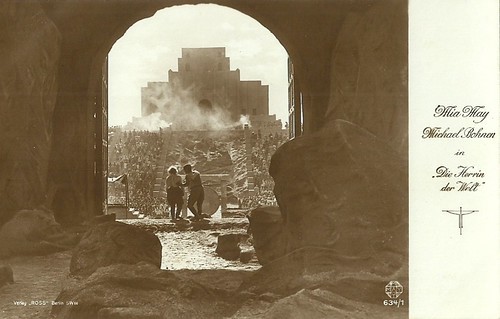
German postcard by Ross Verlag, no. 634/1. Photo: May Film. Mia May and Michael Bohnen in Die Herrin der Welt/Mistress of the World (Joe May and others, 1919). Maug Gregaard ( Mia May ) and Consul Madsen (Michael Bohnen) at Ophir, the City of the Past.

German postcard by Ross Verlag, no. 457/2. Photo: [Alex] Binder.
The German Chaliapin
In 1934, Michael Bohnen had returned to Berlin after his foreign tours, initially sang again at the State Opera, and from 1935 to 1945 at the Deutsche Oper.
During the war years, Bohnen also had major film parts e.g. as a factory manager suffering from foreign spies in Achtung! Feind hört mit! (Arthur Maria Rabenalt, 1940), as the Austrian Emperor in Der liebe Augustin/Beloved Augustin (E.W. Emo, 1940), and as Duke Karl von Braunschweig in Münchhausen (Josef von Baky, 1942/43) starring Hans Albers - even if the scene with him was cut on orders of Goebbels.
IMDb writes that when Bohnen refused to play in propaganda films he was confronted with a fateful consequence. His son Wolfgang, who was a priest, was called up as a front priest to put Michael Bohnen under pressure. Wolfgang Bohnen was killed in the Caucasus two years later; a bad blow for Michael Bohnen.
After the end of the Second World War he was director of the Deutsche Oper until 1947, and president of the Chamber of Artists. As a result of the denazification process, he had to give up the post at the Deutsche Oper because of a deliberate false testimony from his student, the tenor Hans Beirer. Bohnen, named the 'German Chaliapin, stopped singing in 1951.
The tenor's lie was soon proven, but Michael Bohnen's rehabilitation took place only hesitantly. He won the Goethe award in 1952 and the award of the 'Grosses Verdienstkreuz des Verdienstordens der Bundesrepublik Deutschland' in 1957. However, Bohnen was only provided with a small salary from the city of Berlin and lived in complete poverty at the time of his death.
Michael Bohnen was first married to Maria Greven (1913-1926), from which he had two sons. His second marriage was with American soprano and beauty queen Mary Lewis (1927-1933). They separated after three years, the divorce followed three years after. After that, Bohnen had a serious affair with La Jana , as the long correspondence between them proves, but by 1939/1940 they broke up. In 1953 he married for the third time, with draughtswoman and fan Ingeborg Behrend, but they separated in 1963.
In 1965 Michael Bohnen died in his home in Berlin, due to heart failure. He was 77. Bohnen is buried in the Friedhof Heerstraße in Berlin-Westend.
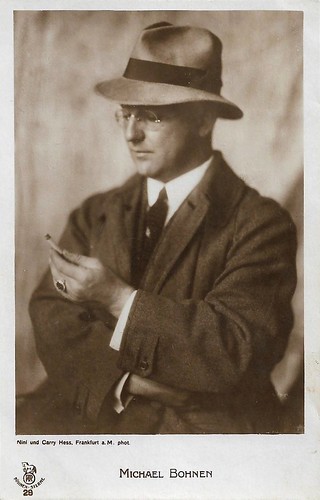
German postcard by Rotophot in the Bühnen-Sterne Series, no. 29. Photo: Nini and Carry Hess, Frankfurt am Main.
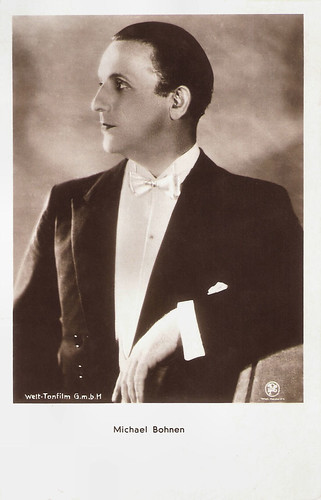
Austrian postcard by Iris Verlag, no. 6023. Photo: Welt-Tonfilm G.m.b.H. / IPC.
Sources: Stephanie D'heil (Steffi-line.de), Wikipedia (German and English), and .

German postcard by Ross Verlag, no. 368/2. Photo: [Alex] Binder.

German postcard by Ross Verlag, no. 634/3. Photo: May Film. Mia May as Maud Gregaard and Michael Bohnen as Consul Madsen in Die Herrin der Welt/Mistress of the World (Joe May and others, 1919).
His massive voice and imposing stature
Franz Michael Bohnen was born in Cologne, Germany, in 1887. He trained as an opera singer (bass-baritone) at the Conservatory in Cologne and through private lessons.
He made his debut at the Stadttheater Düsseldorf in 1910 and performed at the Hoftheater Wiesbaden in 1912. Since 1912 he was a member of the Hofoper Berlin, where his star status as an opera singer was confirmed in 1914 when replacing a colleague as Gurnemanz in Wagner's 'Parsifal'.
In 1914 he also made an impression in Wagner operas at Covent Garden and the Bayreuth Festival. He was called to military service but after an illness in 1916, he could continue at the Berlin Hofoper.
When Richard Strauss, interim at the Hofoper, moved to Berlin, Bohnen joined him and successfully sang the part of Baron Ochs von Lerchenau in Strauss' 'Rosenkavalier', a part he would later repeat in the film version Der Rosenkavalier (Robert Wiene, 1925-1926), starring Huguette Duflos as the Marschallin.
Bohnen often performed at the Metropolitan Opera in New York from 1922 to 1933, and from 1933 to 1934 he made guest appearances in Buenos Aires. His massive voice and imposing stature impressed many.

German postcard by Ross B.V.G., Berlin. Photo: Verleih Filmhaus Bruckmann & Co., A.G. Jaque Catelain , Michael Bohnen, Ellie Felicie Berger and Carl Forest in Der Rosenkavalier/The Knight of the Rose (Robert Wiene, 1925).

Spanish collectors card by Chocolat Imperiale, Barcelona. Photo; Distr. J. Gurgui, Barcelona / May Film. Michael Bohnen in the German silent film serial Die Herrin der Welt/The Mistress of the World (Joe May, a.o., 1919), starring Mia May . Day 4, No. 5. Spanish film title: La dueñá del mundo.
He-man and love interest
In Germany, Michael Bohnen meanwhile had also gained great popularity as a film actor. He debuted on-screen in Ernst Reicher 's biblical film Das Buch Esther (1919).
Then he had a major part as he-man and love interest of Mia May in the first five episodes of Die Herrin der Welt/Mistress of the World (Joe May and several others, 1919-1920), which gave him his breakthrough.
He temporarily owned his own film company, Bohnen-Film GmbH (1920–1922), although most titles are forgotten films now, such as Präsident Barrada/President Barrada (Erik Lund, 1920).
In 1922 he acted in the opera adaptation Tiefland/Lowlands (Adolf Licho, 1922) while in 1926 he acted opposite Ellen Richter in Kopf hoch, Charly/Heads Up, Charley (Ludwig Wolff, 1926).
Bohnen continued with operetta films such as Der Zigeunerbaron/The Gypsy Baron (Friedrich Zelnik, 1927) with Lya Mara and the German early sound film Viktoria und ihr Husar/Victoria and Her Hussar (Richard Oswald, 1931) with Ivan Petrovich and Friedel Schuster.
Bohnen also acted opposite Hans Albers and Brigitte Helm in Gold (Karl Hartl, 1934), while he was Louis XIV in Liselotte von der Pfalz. Frauen um den Sonnenkönig/The Private Life of Louis XIV (Carl Froehlich, 1935) and the Saxon King August the Strong in Der Gefangene des Königs/The King's Prisoner (Carl Boese, 1935) and in the homonymous August der Stärke/Augustus the Strong (Paul Wegener, 1935).
His muscle strength, which he already displayed as the bare-chested savior in Die Herrin der Welt, became legendary. His colleague Lil Dagover describes in her autobiography how, among other things, he fought a living bull and he held a boy out of the window with outstretched arms in August der Starke.

German postcard by Ross Verlag, no. 634/1. Photo: May Film. Mia May and Michael Bohnen in Die Herrin der Welt/Mistress of the World (Joe May and others, 1919). Maug Gregaard ( Mia May ) and Consul Madsen (Michael Bohnen) at Ophir, the City of the Past.

German postcard by Ross Verlag, no. 457/2. Photo: [Alex] Binder.
The German Chaliapin
In 1934, Michael Bohnen had returned to Berlin after his foreign tours, initially sang again at the State Opera, and from 1935 to 1945 at the Deutsche Oper.
During the war years, Bohnen also had major film parts e.g. as a factory manager suffering from foreign spies in Achtung! Feind hört mit! (Arthur Maria Rabenalt, 1940), as the Austrian Emperor in Der liebe Augustin/Beloved Augustin (E.W. Emo, 1940), and as Duke Karl von Braunschweig in Münchhausen (Josef von Baky, 1942/43) starring Hans Albers - even if the scene with him was cut on orders of Goebbels.
IMDb writes that when Bohnen refused to play in propaganda films he was confronted with a fateful consequence. His son Wolfgang, who was a priest, was called up as a front priest to put Michael Bohnen under pressure. Wolfgang Bohnen was killed in the Caucasus two years later; a bad blow for Michael Bohnen.
After the end of the Second World War he was director of the Deutsche Oper until 1947, and president of the Chamber of Artists. As a result of the denazification process, he had to give up the post at the Deutsche Oper because of a deliberate false testimony from his student, the tenor Hans Beirer. Bohnen, named the 'German Chaliapin, stopped singing in 1951.
The tenor's lie was soon proven, but Michael Bohnen's rehabilitation took place only hesitantly. He won the Goethe award in 1952 and the award of the 'Grosses Verdienstkreuz des Verdienstordens der Bundesrepublik Deutschland' in 1957. However, Bohnen was only provided with a small salary from the city of Berlin and lived in complete poverty at the time of his death.
Michael Bohnen was first married to Maria Greven (1913-1926), from which he had two sons. His second marriage was with American soprano and beauty queen Mary Lewis (1927-1933). They separated after three years, the divorce followed three years after. After that, Bohnen had a serious affair with La Jana , as the long correspondence between them proves, but by 1939/1940 they broke up. In 1953 he married for the third time, with draughtswoman and fan Ingeborg Behrend, but they separated in 1963.
In 1965 Michael Bohnen died in his home in Berlin, due to heart failure. He was 77. Bohnen is buried in the Friedhof Heerstraße in Berlin-Westend.

German postcard by Rotophot in the Bühnen-Sterne Series, no. 29. Photo: Nini and Carry Hess, Frankfurt am Main.

Austrian postcard by Iris Verlag, no. 6023. Photo: Welt-Tonfilm G.m.b.H. / IPC.
Sources: Stephanie D'heil (Steffi-line.de), Wikipedia (German and English), and .
Published on April 06, 2021 22:00
April 5, 2021
I Signori di Vettori
Three years ago, EFSP did a post on Ed. G. Vettori which published stage and film star postcards in Italy during the 1910s and 1920s. The Bologna-based publisher made thousands of black and white postcards which showed film stills and studio portraits, often made in their own photo studio. The subjects were well-known national actors but also international stars. Recently Ivo Blom acquired a series of Vettori postcards that offers a panorama of the now mostly forgotten male stars of the Italian stage and cinema in the 1910s and 1920s.
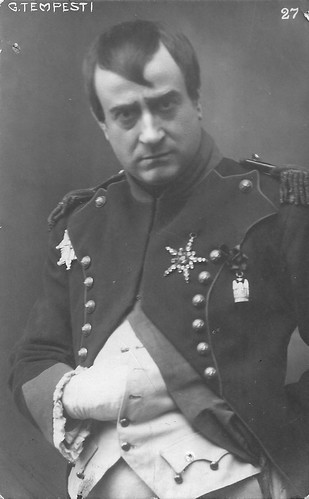
Italian postcard by Vettori, Bologna, no. 27. Photo: Vettori, Bologna. Giulio Tempesti as Napoleon.
Between 1934 and 1943, Italian stage and screen actor Giulio Tempesti (1875-?) acted in twenty Italian sound films, starting with La cieca di Sorrento (Nunzio Malasomma, 1934). In this film the son (Corrado Racca) of a man falsely executed for killing an aristocratic woman returns to Italy after studying medicine in England, and operates on the woman's daughter (Dria Paola) who had become blind after witnessing the crime. Tempesti played the girl's father. Afterward, he played mostly small supporting parts. Substantial were his parts as courtroom president in La grande luce - Montevergine (Carlo Campogaliani, 1939) and as Don Lorenzo in Giacomo l'idealista (Alberto Lattuada, 1943), an adaptation of Emilio De Marchi's novel on the resistance against the injustices of the aristocracy, starring Marina Berti, Massimo Serato, and Andrea Checchi.
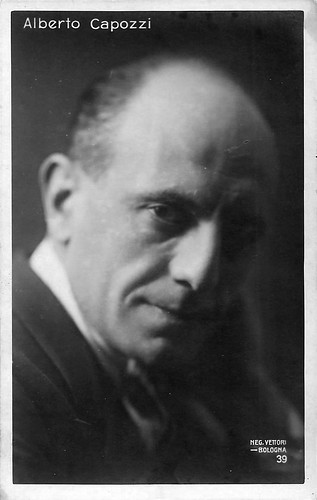
Italian postcard by Vettori, Bologna, no. 39. Photo: Vettori, Bologna.
Alberto Capozzi (1886-1945) was an Italian film and stage actor who had an enormous career in Italian cinema in the 1910s and early 1920s. Afterward, he pursued a career abroad in Austria and as a sound dubber in France. He returned to film acting in Italian cinema in the early 1940s.
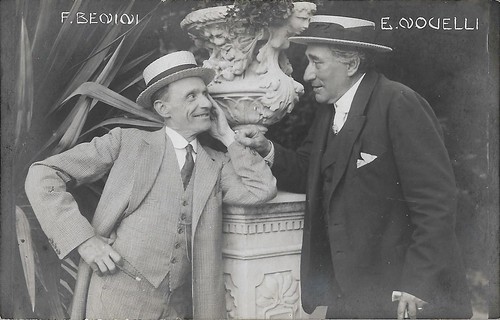
Italian postcard by Ed. Vettori, Bologna.
Ferruccio Benini and Ermete Novelli collaborated on the propaganda film project Per la patria! (Ugo Falena, 1915), which combined nonfiction footage of the battlefields with footage of stage actors filmed in their famous roles. It was Benini's sole film part. he died soon after the film was made. Ermete Novelli (1851-1919) was a legendary monstre sacré of the theatre. In the 1910s he appeared in films by Film d'Arte Italiana, Ambrosio and Raggio Film.
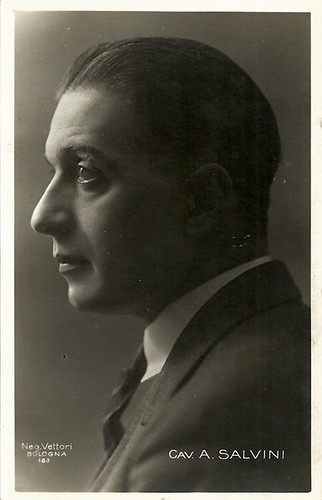
Italian postcard by Ed. Vettori, Bologna, no. 163. Photo Vettori, Bologna.
Sandro Salvini (1890-1955) was an actor and director of Italian dubbing. He made his film debut in 1917 in a Cines film with Lyda Borelli: La storia dei tredici (Carmine Gallone, 1917). After a few more Cines films Salvini shifted to Caesar Films, where he acted opposite Francesca Bertini in Anima allegra (1919), La contessa Sara (1919), La serpe (1920), and Lisa Fleuron (1920), all directed by Roberto Roberti. He then acted in two films by Herbert Brenon shot in Italy: Il colchico e la rosa/Little Sister (1921) and Beatrice/The Stronger Passion (1921). He also had leads in J. Gordon Edwards' films Nero (1922) and The Shepherd King (1923), shot for Fox in Italy. Apart from one film in 1927, Salvini's film career stagnated after 1923 and was only revived when sound cinema arrived in Italy.
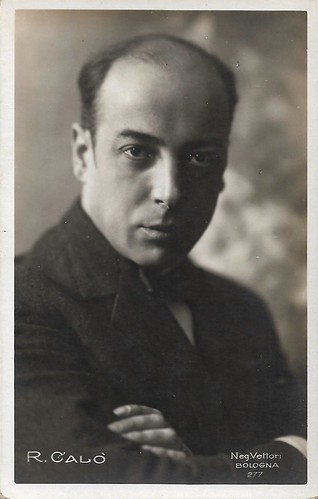
Italian postcard by Ed. Vettori, Bologna, no. 227. Photo Vettori, Bologna.
Romano Calò (1883-1952) was an Italian stage, screen, and radio actor and director, who was active in film since the silent film era. Calò's film debut was a minor part in Lucio D'Ambra's Napoleoncina (1918), starring Mary Corwin. With D'Ambra and Corwin, Calò did two more films in 1919, La valse bleue and Il girotondo degli undici lancieri, plus one without Corwin, L'arcolaio di Barberina. In 1919, he also played at Caesar Film Francesca Bertini's lover in Spiritismo by Camillo De Riso. Calò acted at Nova Film opposite Diana Karenne in such films as Miss Dorothy (Giulio Antamoro, 1920), La campana dello scandalo (Giulio Antamoro, 1920), and Smarrita! (Giulio Antamoro, 1921). At Nova Film, he also acted with Carmen Boni in the Pirandello adaptation Ma non è una cosa seria (Augusto Camerini, 1921). Then Calo was away from the film sets for years until sound cinema brought him back.
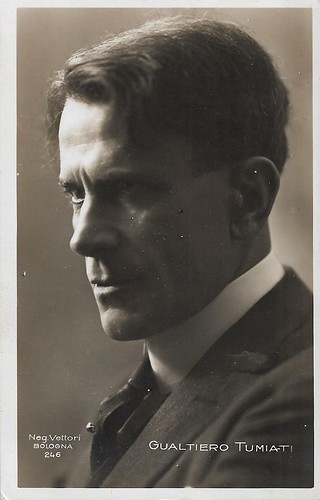
Italian postcard by Ed. Vettori, Bologna, no. 246. Photo Vettori, Bologna.
Gualtiero Tumiati (1876–1971) was an Italian stage and screen actor. In 1910 he was a big success on stage in 'Cyrano de Bergerac'. At the outbreak of the First World War, Tumiati devoted himself to shows to entertain the troops. In 1920 the period of his great theatrical works began including 'The Twelfth Night' by William Shakespeare and 'Liliom' by Ferenc Molnár. In 1924, he founded the Sala Azzurra in Milan, one of the first avant-garde theatres. From 1935 on, Tumiati also acted in numerous successful films.
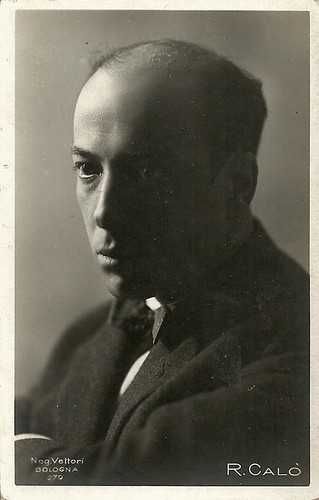
Italian postcard by Ed. Vettori, Bologna, no. 279. Photo Vettori, Bologna.
Romano Calò (1883-1952) was an Italian stage, screen, and radio actor and director, who was active in film since the silent film era. Calò's film debut was a minor part in Lucio D'Ambra's Napoleoncina (1918), starring Mary Corwin. With D'Ambra and Corwin, Calò did two more films in 1919, La valse bleue and Il girotondo degli undici lancieri, plus one without Corwin, L'arcolaio di Barberina. In 1919, he also played at Caesar Film Francesca Bertini's lover in Spiritismo by Camillo De Riso. Calò acted at Nova Film opposite Diana Karenne in such films as Miss Dorothy (Giulio Antamoro, 1920), La campana dello scandalo (Giulio Antamoro, 1920), and Smarrita! (Giulio Antamoro, 1921). At Nova Film, he also acted with Carmen Boni in the Pirandello adaptation Ma non è una cosa seria (Augusto Camerini, 1921). Then Calo was away from the film sets for years until sound cinema brought him back.
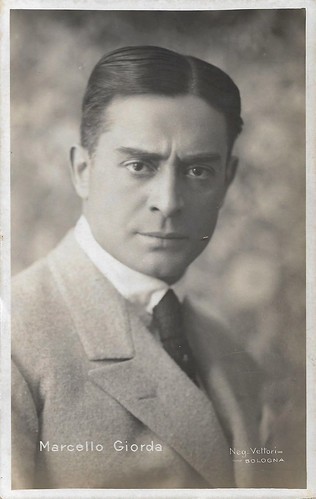
Italian postcard by Ed. Vettori, Bologna. Photo Vettori, Bologna.
Marcello Giorda (1890-1960) was an Italian stage, film, radio, and TV actor. He made his silent film debut in Turbine rosso (Oreste Gherardini, 1916), That same year, te was followed by Notte di tempesta (Guglielmo Zorzi, 1916) with Italia Almirante Manzini. In 1920 he did two more silent films: Mister Wu (director unknown, 1920), and Il principe idiota (Eugenio Perego, 1920), with Fernanda Fassi, Lamberto Picasso and Paola Borboni. After an absence of over a decade, Giorda returned to the sets in the sound film era.
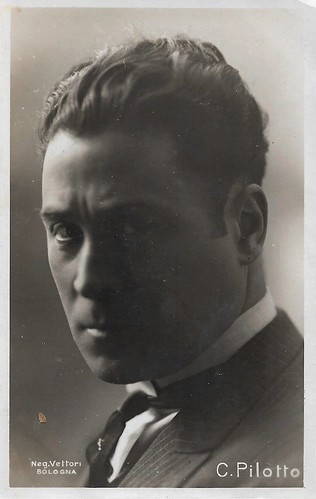
Italian postcard by Ed. Vettori, Bologna. Photo Vettori, Bologna.
Camillo Pilotto (1888-1963) was an Italian stage and screen actor. Pilotto made his film debut in Il sopravissuto (Augusto Genina, 1916) after which a handful of films followed, among which some directed by Eugenio Perego. In the 1920s Pilotto was hardly visible in the cinema, but his career as a film actor really set off in the 1930s, when the sound film set in.

Italian postcard by Vettori, Bologna, no. 310. Photo: Vettori, Bologna.
Italian stage and film actor Aristide Baghetti (1874-1955) made his debut in the cinema in 1916 when he was directed by Mario Caserini in L'ombra accanto, starring Vittoria Lepanto. He found his consecration on the screen from 1930 when he took part in Resurrectio by Alessandro Blasetti. Baghetti played posh gentlemen, aristocrats, and butlers in two dozens of films, both light comedies, and melodramas, such as Mille lire al mese (Max Neufeld, 1939), L'onorevole Angelina (Luigi Zampa, 1947) and I figli di nessuno (Raffaele Matarazzo, 1951). Baghetti's last substantial part was in Il sole negli occhi (Antonio Pietrangeli, 1953).
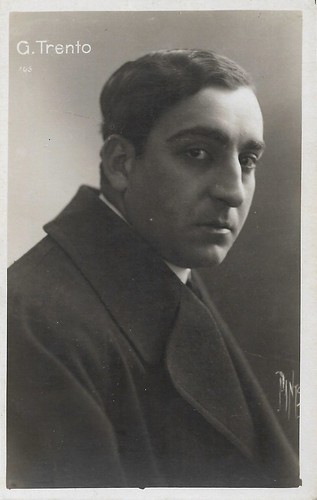
Italian postcard by Vettori, Bologna, no. 405. Photo: Pinto, Roma.
Guido Trento (1892–1957) was an Italian stage and screen actor. In 1919-1921 he acted for Gladiator Film in various films by Gian Paolo Rosmino, Alfredo Masi, Giuseppe De Liguoro etc. In the same years, he also worked at Tiber Film, Chimera Film, and Global. In 1922-1923 he acted at Medusa Film with Helena Makowska in such films as Idillio tragico and Rabagas by Gaston Ravel. Parallel, he acted in two international productions shot in Italy by J. Gordon Edwards, Nero (1922), and The Shepherd King (1923), produced by Fox. Trento's Italian film career ended in 1924 but he continued in the USA at Fox. Trento played thus Police Sergeant Neri in Frank Borzage's Street Angel (1928), starring Janet Gaynor.
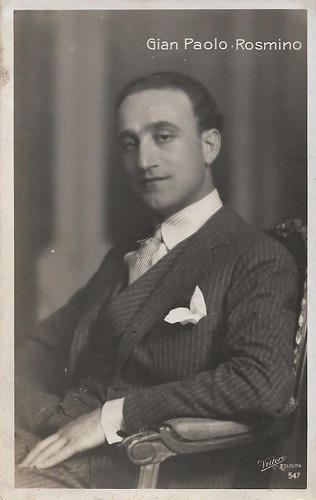
Italian postcard by Vettori, Bologna, no. 547. Photo: Pinto, Roma.
Gian Paolo Rosmino (1888-1982) was an Italian actor, director, and screenwriter. He started his film career first as an actor and shortly after also as a director, in the Turin studios. He was the slick spy in Lyda Borelli's film debut Ma l'amor mio non muore (Mario Caserini, 1913), for the Gloria Film company, and as Brittanicus in Gloria's Nerone e Agrippina (Mario Caserini, 1914). With Leda Gys, his later wife Suzanne Fabre and Maria Caserini, he became one of the Caserini regulars in the mid-1910s, when the latter started his own company and also made some films in Spain. Between 1918 and 1921 Rosmino would also direct a series of 10 films at Gladiator Films, with Helena Makowska and Suzanne Fabre, such as La dame en gris (1919). After 1922 he stipped with film acting for years, no doubt due to the collapse of the Italian film industry around 1922-1923.

Italian postcard by Vettori, Bologna, no. 562. Photo: Vettori, Bologna.
Antonio Gandusio (1873-1951) was an Italian stage and screen actor, who had a rich career in the 1930s and 1940s Italian cinema. He had a supporting part in the silent film Il romanzo di un giovane povero (Amleto Palermi, 1920) starring Pina Menichelli and Luigi Serventi, but Gandusio's film acting career really set off when the sound film had set in.
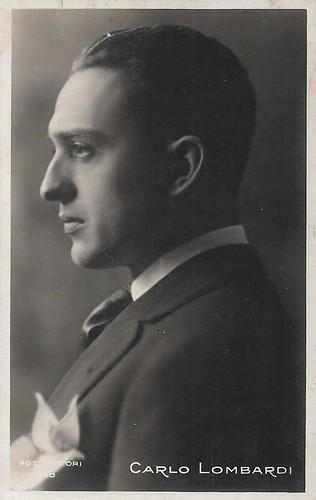
Italian postcard by Vettori, Bologna, no. 658. Photo: Vettori, Bologna.
Italian actor Carlo Lombardi (1900-1984) made his debut in theatrical prose as a young actor. In the early twenties, he moved to the stage company directed by Guglielmo Giannini, where he acted alongside Emma Gramatica. Subsequently, he entered as the first actor in the company of Luigi Carini and Antonella Petrucci, then worked with Camillo Pilotto and Kiki Palmer. In 1930 he was hired by Jack Salvatori for the versions of American films in Italian that were being shot at the Paramount studios in Joinville, near Paris. In 1932 Cines offered him a contract for supporting parts in a series of films to be shot in the Rome studios.
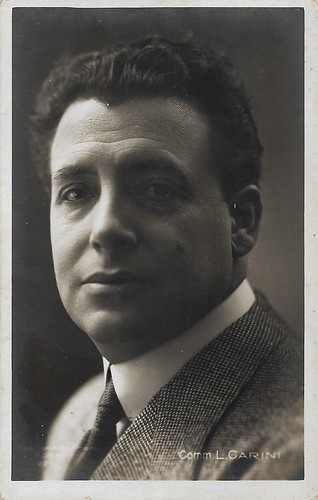
Italian postcard by Vettori, Bologna. Photo Vettori, Bologna.
Italian stage and screen actor and company manager Luigi Carini (1869-1943) played in several films since the silent era such as Mario Bonnard's L'amica (1920) with Vittoria Lepanto. In the sound era, Carini was the president of the court in the courtoom drama Corte d'Assise (Guido Brignone, 1931), the writer in Pierpin (Duilio Coletti, 1935), and the aristocratic father of Elisa Cegani in the romantic period piece Cavalleria (Goffredo Alessandrini, 1936). He also acted in two films by Gennaro Righelli, starring Vanna Vanni: Fuochi d'artificio (1938) and Le educande di Saint-Cyr (1939).
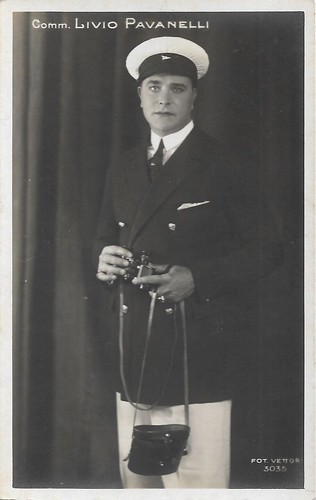
Italian postcard by Vettori, Bologna, no. 3035. Photo Vettori, Bologna.
Livio Pavanelli (1881-1958) was an Italian actor of the Italian and in particular German silent cinema. He also worked in Italian sound cinema as an actor and as a production manager. He directed four Italian films, both in the silent and the sound era.
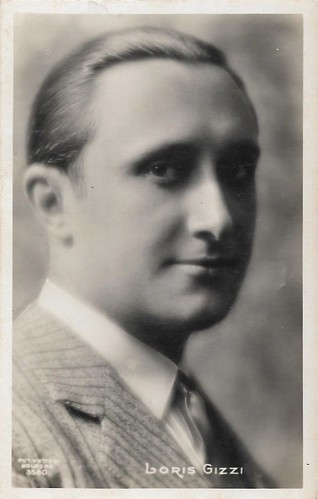
Italian postcard by Vettori, Bologna, no. 3580. Photo Vettori, Bologna.
Even if not tall in stature, burly, and certainly not handsome, Italian actor Loris Gizzi (1899-1986) worked a lot in the cinema as a character actor. He made his screen debut in T'amerò sempre (Mario Camerini, 1933) with Elsa De Giorgi, Nino Besozzi, and Mino Doro. Gizzi was immediately noticed for his peaceful and friendly air. Exceptionally, Camerini asked him again for the same role in the remake of ten years later, with Alida Valli, Gino Cervi and Antonio Centa. For Camerini he also played the lawyer in Darò un milione (1934), and the captain of the guard in I promessi sposi (1941).

Italian postcard by Vettori, Bologna, no. 27. Photo: Vettori, Bologna. Giulio Tempesti as Napoleon.
Between 1934 and 1943, Italian stage and screen actor Giulio Tempesti (1875-?) acted in twenty Italian sound films, starting with La cieca di Sorrento (Nunzio Malasomma, 1934). In this film the son (Corrado Racca) of a man falsely executed for killing an aristocratic woman returns to Italy after studying medicine in England, and operates on the woman's daughter (Dria Paola) who had become blind after witnessing the crime. Tempesti played the girl's father. Afterward, he played mostly small supporting parts. Substantial were his parts as courtroom president in La grande luce - Montevergine (Carlo Campogaliani, 1939) and as Don Lorenzo in Giacomo l'idealista (Alberto Lattuada, 1943), an adaptation of Emilio De Marchi's novel on the resistance against the injustices of the aristocracy, starring Marina Berti, Massimo Serato, and Andrea Checchi.

Italian postcard by Vettori, Bologna, no. 39. Photo: Vettori, Bologna.
Alberto Capozzi (1886-1945) was an Italian film and stage actor who had an enormous career in Italian cinema in the 1910s and early 1920s. Afterward, he pursued a career abroad in Austria and as a sound dubber in France. He returned to film acting in Italian cinema in the early 1940s.

Italian postcard by Ed. Vettori, Bologna.
Ferruccio Benini and Ermete Novelli collaborated on the propaganda film project Per la patria! (Ugo Falena, 1915), which combined nonfiction footage of the battlefields with footage of stage actors filmed in their famous roles. It was Benini's sole film part. he died soon after the film was made. Ermete Novelli (1851-1919) was a legendary monstre sacré of the theatre. In the 1910s he appeared in films by Film d'Arte Italiana, Ambrosio and Raggio Film.

Italian postcard by Ed. Vettori, Bologna, no. 163. Photo Vettori, Bologna.
Sandro Salvini (1890-1955) was an actor and director of Italian dubbing. He made his film debut in 1917 in a Cines film with Lyda Borelli: La storia dei tredici (Carmine Gallone, 1917). After a few more Cines films Salvini shifted to Caesar Films, where he acted opposite Francesca Bertini in Anima allegra (1919), La contessa Sara (1919), La serpe (1920), and Lisa Fleuron (1920), all directed by Roberto Roberti. He then acted in two films by Herbert Brenon shot in Italy: Il colchico e la rosa/Little Sister (1921) and Beatrice/The Stronger Passion (1921). He also had leads in J. Gordon Edwards' films Nero (1922) and The Shepherd King (1923), shot for Fox in Italy. Apart from one film in 1927, Salvini's film career stagnated after 1923 and was only revived when sound cinema arrived in Italy.

Italian postcard by Ed. Vettori, Bologna, no. 227. Photo Vettori, Bologna.
Romano Calò (1883-1952) was an Italian stage, screen, and radio actor and director, who was active in film since the silent film era. Calò's film debut was a minor part in Lucio D'Ambra's Napoleoncina (1918), starring Mary Corwin. With D'Ambra and Corwin, Calò did two more films in 1919, La valse bleue and Il girotondo degli undici lancieri, plus one without Corwin, L'arcolaio di Barberina. In 1919, he also played at Caesar Film Francesca Bertini's lover in Spiritismo by Camillo De Riso. Calò acted at Nova Film opposite Diana Karenne in such films as Miss Dorothy (Giulio Antamoro, 1920), La campana dello scandalo (Giulio Antamoro, 1920), and Smarrita! (Giulio Antamoro, 1921). At Nova Film, he also acted with Carmen Boni in the Pirandello adaptation Ma non è una cosa seria (Augusto Camerini, 1921). Then Calo was away from the film sets for years until sound cinema brought him back.

Italian postcard by Ed. Vettori, Bologna, no. 246. Photo Vettori, Bologna.
Gualtiero Tumiati (1876–1971) was an Italian stage and screen actor. In 1910 he was a big success on stage in 'Cyrano de Bergerac'. At the outbreak of the First World War, Tumiati devoted himself to shows to entertain the troops. In 1920 the period of his great theatrical works began including 'The Twelfth Night' by William Shakespeare and 'Liliom' by Ferenc Molnár. In 1924, he founded the Sala Azzurra in Milan, one of the first avant-garde theatres. From 1935 on, Tumiati also acted in numerous successful films.

Italian postcard by Ed. Vettori, Bologna, no. 279. Photo Vettori, Bologna.
Romano Calò (1883-1952) was an Italian stage, screen, and radio actor and director, who was active in film since the silent film era. Calò's film debut was a minor part in Lucio D'Ambra's Napoleoncina (1918), starring Mary Corwin. With D'Ambra and Corwin, Calò did two more films in 1919, La valse bleue and Il girotondo degli undici lancieri, plus one without Corwin, L'arcolaio di Barberina. In 1919, he also played at Caesar Film Francesca Bertini's lover in Spiritismo by Camillo De Riso. Calò acted at Nova Film opposite Diana Karenne in such films as Miss Dorothy (Giulio Antamoro, 1920), La campana dello scandalo (Giulio Antamoro, 1920), and Smarrita! (Giulio Antamoro, 1921). At Nova Film, he also acted with Carmen Boni in the Pirandello adaptation Ma non è una cosa seria (Augusto Camerini, 1921). Then Calo was away from the film sets for years until sound cinema brought him back.

Italian postcard by Ed. Vettori, Bologna. Photo Vettori, Bologna.
Marcello Giorda (1890-1960) was an Italian stage, film, radio, and TV actor. He made his silent film debut in Turbine rosso (Oreste Gherardini, 1916), That same year, te was followed by Notte di tempesta (Guglielmo Zorzi, 1916) with Italia Almirante Manzini. In 1920 he did two more silent films: Mister Wu (director unknown, 1920), and Il principe idiota (Eugenio Perego, 1920), with Fernanda Fassi, Lamberto Picasso and Paola Borboni. After an absence of over a decade, Giorda returned to the sets in the sound film era.

Italian postcard by Ed. Vettori, Bologna. Photo Vettori, Bologna.
Camillo Pilotto (1888-1963) was an Italian stage and screen actor. Pilotto made his film debut in Il sopravissuto (Augusto Genina, 1916) after which a handful of films followed, among which some directed by Eugenio Perego. In the 1920s Pilotto was hardly visible in the cinema, but his career as a film actor really set off in the 1930s, when the sound film set in.

Italian postcard by Vettori, Bologna, no. 310. Photo: Vettori, Bologna.
Italian stage and film actor Aristide Baghetti (1874-1955) made his debut in the cinema in 1916 when he was directed by Mario Caserini in L'ombra accanto, starring Vittoria Lepanto. He found his consecration on the screen from 1930 when he took part in Resurrectio by Alessandro Blasetti. Baghetti played posh gentlemen, aristocrats, and butlers in two dozens of films, both light comedies, and melodramas, such as Mille lire al mese (Max Neufeld, 1939), L'onorevole Angelina (Luigi Zampa, 1947) and I figli di nessuno (Raffaele Matarazzo, 1951). Baghetti's last substantial part was in Il sole negli occhi (Antonio Pietrangeli, 1953).

Italian postcard by Vettori, Bologna, no. 405. Photo: Pinto, Roma.
Guido Trento (1892–1957) was an Italian stage and screen actor. In 1919-1921 he acted for Gladiator Film in various films by Gian Paolo Rosmino, Alfredo Masi, Giuseppe De Liguoro etc. In the same years, he also worked at Tiber Film, Chimera Film, and Global. In 1922-1923 he acted at Medusa Film with Helena Makowska in such films as Idillio tragico and Rabagas by Gaston Ravel. Parallel, he acted in two international productions shot in Italy by J. Gordon Edwards, Nero (1922), and The Shepherd King (1923), produced by Fox. Trento's Italian film career ended in 1924 but he continued in the USA at Fox. Trento played thus Police Sergeant Neri in Frank Borzage's Street Angel (1928), starring Janet Gaynor.

Italian postcard by Vettori, Bologna, no. 547. Photo: Pinto, Roma.
Gian Paolo Rosmino (1888-1982) was an Italian actor, director, and screenwriter. He started his film career first as an actor and shortly after also as a director, in the Turin studios. He was the slick spy in Lyda Borelli's film debut Ma l'amor mio non muore (Mario Caserini, 1913), for the Gloria Film company, and as Brittanicus in Gloria's Nerone e Agrippina (Mario Caserini, 1914). With Leda Gys, his later wife Suzanne Fabre and Maria Caserini, he became one of the Caserini regulars in the mid-1910s, when the latter started his own company and also made some films in Spain. Between 1918 and 1921 Rosmino would also direct a series of 10 films at Gladiator Films, with Helena Makowska and Suzanne Fabre, such as La dame en gris (1919). After 1922 he stipped with film acting for years, no doubt due to the collapse of the Italian film industry around 1922-1923.

Italian postcard by Vettori, Bologna, no. 562. Photo: Vettori, Bologna.
Antonio Gandusio (1873-1951) was an Italian stage and screen actor, who had a rich career in the 1930s and 1940s Italian cinema. He had a supporting part in the silent film Il romanzo di un giovane povero (Amleto Palermi, 1920) starring Pina Menichelli and Luigi Serventi, but Gandusio's film acting career really set off when the sound film had set in.

Italian postcard by Vettori, Bologna, no. 658. Photo: Vettori, Bologna.
Italian actor Carlo Lombardi (1900-1984) made his debut in theatrical prose as a young actor. In the early twenties, he moved to the stage company directed by Guglielmo Giannini, where he acted alongside Emma Gramatica. Subsequently, he entered as the first actor in the company of Luigi Carini and Antonella Petrucci, then worked with Camillo Pilotto and Kiki Palmer. In 1930 he was hired by Jack Salvatori for the versions of American films in Italian that were being shot at the Paramount studios in Joinville, near Paris. In 1932 Cines offered him a contract for supporting parts in a series of films to be shot in the Rome studios.

Italian postcard by Vettori, Bologna. Photo Vettori, Bologna.
Italian stage and screen actor and company manager Luigi Carini (1869-1943) played in several films since the silent era such as Mario Bonnard's L'amica (1920) with Vittoria Lepanto. In the sound era, Carini was the president of the court in the courtoom drama Corte d'Assise (Guido Brignone, 1931), the writer in Pierpin (Duilio Coletti, 1935), and the aristocratic father of Elisa Cegani in the romantic period piece Cavalleria (Goffredo Alessandrini, 1936). He also acted in two films by Gennaro Righelli, starring Vanna Vanni: Fuochi d'artificio (1938) and Le educande di Saint-Cyr (1939).

Italian postcard by Vettori, Bologna, no. 3035. Photo Vettori, Bologna.
Livio Pavanelli (1881-1958) was an Italian actor of the Italian and in particular German silent cinema. He also worked in Italian sound cinema as an actor and as a production manager. He directed four Italian films, both in the silent and the sound era.

Italian postcard by Vettori, Bologna, no. 3580. Photo Vettori, Bologna.
Even if not tall in stature, burly, and certainly not handsome, Italian actor Loris Gizzi (1899-1986) worked a lot in the cinema as a character actor. He made his screen debut in T'amerò sempre (Mario Camerini, 1933) with Elsa De Giorgi, Nino Besozzi, and Mino Doro. Gizzi was immediately noticed for his peaceful and friendly air. Exceptionally, Camerini asked him again for the same role in the remake of ten years later, with Alida Valli, Gino Cervi and Antonio Centa. For Camerini he also played the lawyer in Darò un milione (1934), and the captain of the guard in I promessi sposi (1941).
Published on April 05, 2021 22:00
April 4, 2021
Carole Lombard
American film actress Carole Lombard (1908–1942) was the highest-paid star in Hollywood in the late 1930s. She was particularly noted for her energetic, ditzy, and often off-beat roles in screwball comedies of the 1930s.

French postcard by Editions P.I., no. 225. Photo: M.G.M.

British Art Photo postcard, no. 20. Photo: Paramount Pictures.

Italian postcard by Rizzoli & C., Milano, 1938-XVI. Photo: Metro-Goldwyn-Mayer (MGM). Carole Lombard in The Princess Comes Across (William K. Howard, 1936).
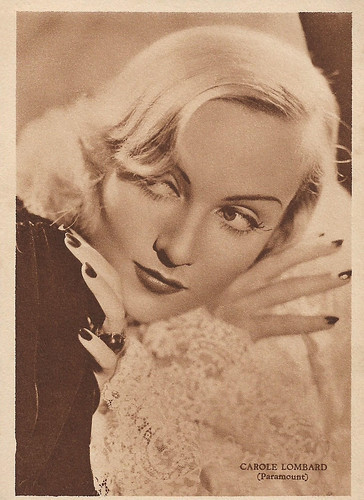
Italian postcard by Rizzoli & C., Milano, 1940. Photo: Paramount.
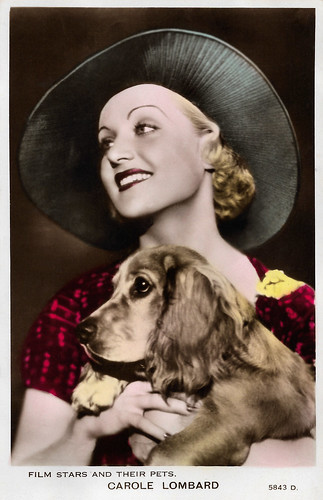
British postcard by Valentine's in the Film Stars and Their Pets series, no. 5843 D. Photo: Paramount.
A free-spirited tomboy
Carole Lombard was born as Jane Alice Peters into a wealthy family in Fort Wayne, Indiana, in 1908. In 1916 the family decided to settle down in the Los Angeles area.
She attended Virgil Junior High School. Described by her biographer Wes Gehring as 'a free-spirited tomboy', the young Lombard was passionately involved in sports and enjoyed watching films. While playing baseball in the street with the neighbourhood boys, she was spotted by film director Allan Dwan.
This led to her screen debut at 12, a small role in Dwan's A Perfect Crime (Allan Dwan, 1921), playing the sister of Monte Blue . Although she tried for other acting jobs, she would not be seen onscreen again for four years. She returned to a normal life, going to school and participating in athletics, excelling in track and field.
In 1924 or 1925 (the sources differ, she passed a screen test and was signed to a contract with Fox Films. Her first role as a Fox player was Hearts and Spurs (W.S. Van Dyke, 1925), in which she had the female lead opposite Buck Jones .
She got her first break the following year in another leading role opposite Edmund Lowe in the successful drama Marriage in Transit (Roy William Neill, 1925). She was credited now as 'Carol Lombard'. After a car accident in 1926 that left a scar on the left side of her face, she was dropped by Fox.
The 17-year-old had an early plastic surgery procedure to make it less visible. For the remainder of her career, Lombard learned to hide the mark with make-up and careful lighting. After a year without work, Lombard obtained a screen test for the 'King of Comedy' Mack Sennett. He offered her a contract, and although she initially had reservations about performing in slapstick comedies, the actress joined his company as one of the 'Bathing Beauties'.
Lombard appeared in 15 short Sennett productions between September 1927 and March 1929. When sound film was introduced, her light, breezy, sexy voice perfectly suited the talkies. Her first sound film was High Voltage (Howard Higgin, 1929), soon followed by another crime film The Racketeer (Howard Higgin, 1929).
After a successful one-off appearance opposite Warner Baxter in Fox's The Arizona Kid (Alfred Santell, 1930), she signed a contract with Paramount Pictures who cast her in the Buddy Rogers comedy Safety in Numbers (Victor Schertzinger, 1930). For her second assignment, the romantic comedy Fast and Loose (Fred C. Newmeyer, 1930) with Miriam Hopkins , Paramount mistakenly credited the actress as 'Carole Lombard'. She decided she liked this spelling and it became her permanent screen name.
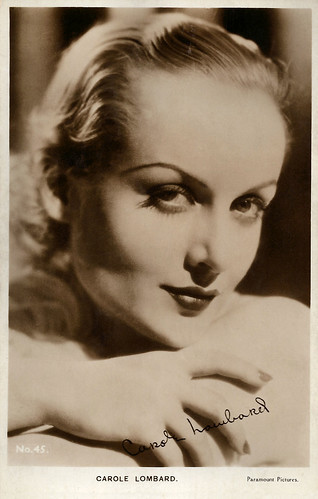
British postcard in the Film Kurier Series, London, no. 45. Photo: Paramount Pictures.
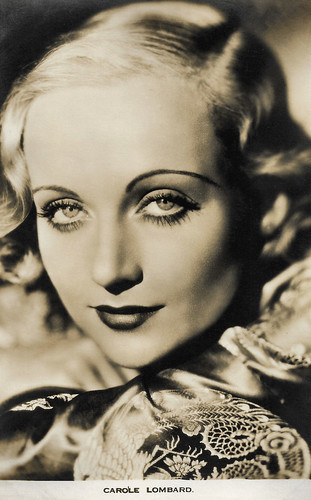
British postcard.
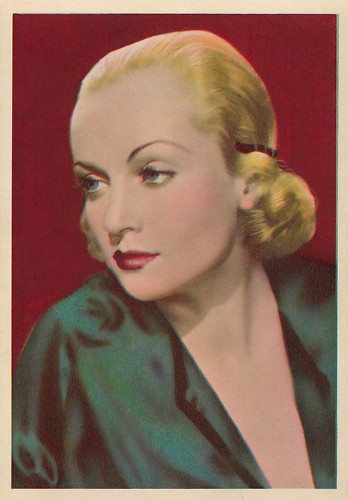
British postcard by De Reszke Cigarettes, no. 8. Photo: Paramount.
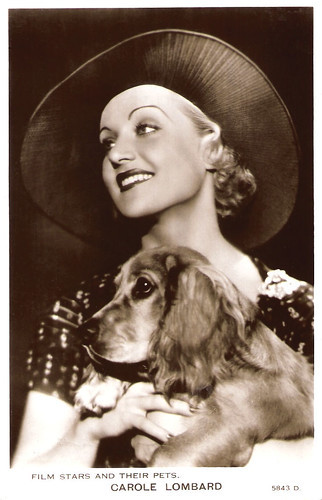
British postcard by Valentine's in the Film Stars and Their Pets series, no. 5843 D. Photo: Paramount.
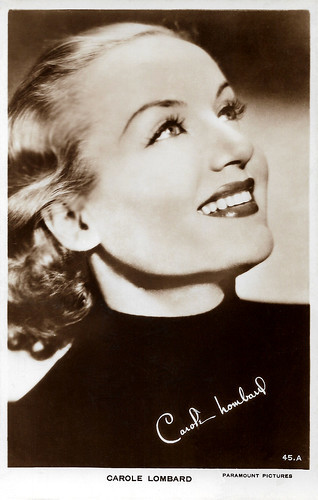
British Real Photograph postcard, no. 45.a. Photo: Paramount Pictures.
The highest-paid actress in Hollywood
Carole Lombard began appearing in comedies with William Powell such as Man of the World (Richard Wallace, 1931) and Ladies Man (Lothar Mendes, 1931) and married him in June 1931. The marriage to Powell, Paramount's top male star, increased Lombard's fame. Although they divorced in 1933, the two would continue to occasionally star together throughout the 1930s.
Lombard starred for the first and only time alongside Clark Gable (they married in 1939) in the romantic drama No Man of Her Own (Wesley Ruggles, 1932). The successful screwball comedy Twentieth Century (Howard Hawks, 1934) with John Barrymore, showed her true comedic talents and proved to the world what a fine actress she really was.
It was followed by the hit comedies Hands Across the Table (Mitchell Leisen, 1935) with Fred MacMurray, The Princess Comes Across (William K. Howard, 1936), My Man Godfrey (Gregory LaCava, 1936), which won her an Academy Award nomination opposite Powell, Swing High, Swing Low (Mitchell Leisen, 1937), and Nothing Sacred (William Wellman, 1937).
By then Lombard had become the highest-paid actress in Hollywood and one of its most popular stars. Eager to win an Oscar, by the end of the decade she began to move away from comedies towards more serious roles, appearing opposite James Stewart in the drama Made for Each Other (John Cromwell, 1939) and alongside Cary Grant in the romance In Name Only (John Cromwell, 1939).
Her role as a nurse in Vigil in the Night (George Stevens, 1940) was her most notable attempt to win an Oscar but didn't receive a nomination. Lombard returned to comedy in Alfred Hitchcock 's Mr. & Mrs. Smith in 1941. Lombard's career was cut short when she died at the age of 33 in an aircraft crash.
On January 16, 1942, Carole, her mother, and 20 other people were flying back to California when the plane went down outside of Las Vegas, Nevada. All aboard perished. Her final film, Ernst Lubitsch 's To Be or Not to Be (1942), a satire about Nazism and the war, was in post-production at the time of her death. Wikipedia : "Today she is remembered as one of the definitive actresses of the screwball comedy genre and American comedy and ranks among the American Film Institute's greatest stars of all time."
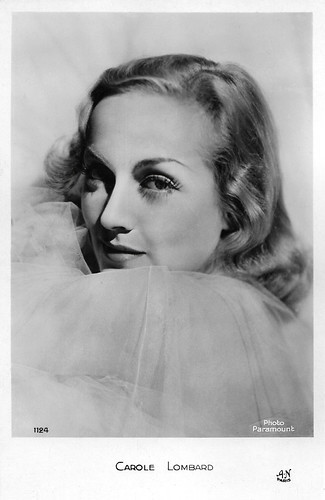
French postcard by A.N., Paris, no. 1124. Photo: Paramount.
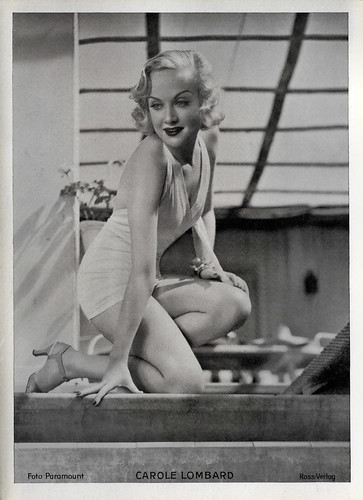
Big German card by Ross Verlag. Photo: Paramount.
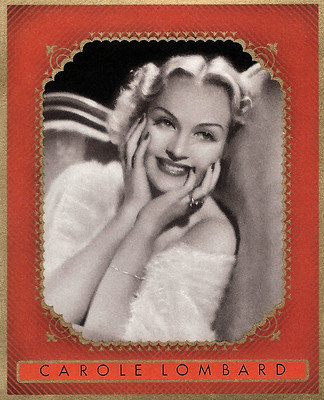
German collectors card in the Bunte Filmbilder series by Greilingen-Zigaretten, Series no. 2, no. 259. Photo: Paramount / Ross-Verlag.
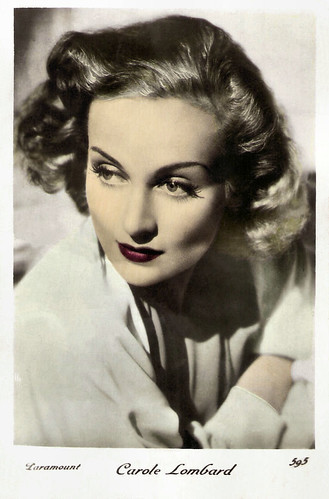
French postcard, no. 595. Photo: Paramount.
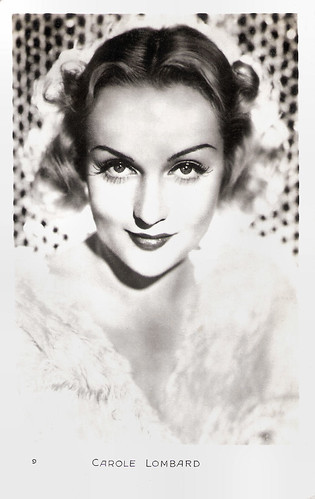
Vintage card, no. 9.
Sources: Wikipedia and .

French postcard by Editions P.I., no. 225. Photo: M.G.M.

British Art Photo postcard, no. 20. Photo: Paramount Pictures.

Italian postcard by Rizzoli & C., Milano, 1938-XVI. Photo: Metro-Goldwyn-Mayer (MGM). Carole Lombard in The Princess Comes Across (William K. Howard, 1936).

Italian postcard by Rizzoli & C., Milano, 1940. Photo: Paramount.

British postcard by Valentine's in the Film Stars and Their Pets series, no. 5843 D. Photo: Paramount.
A free-spirited tomboy
Carole Lombard was born as Jane Alice Peters into a wealthy family in Fort Wayne, Indiana, in 1908. In 1916 the family decided to settle down in the Los Angeles area.
She attended Virgil Junior High School. Described by her biographer Wes Gehring as 'a free-spirited tomboy', the young Lombard was passionately involved in sports and enjoyed watching films. While playing baseball in the street with the neighbourhood boys, she was spotted by film director Allan Dwan.
This led to her screen debut at 12, a small role in Dwan's A Perfect Crime (Allan Dwan, 1921), playing the sister of Monte Blue . Although she tried for other acting jobs, she would not be seen onscreen again for four years. She returned to a normal life, going to school and participating in athletics, excelling in track and field.
In 1924 or 1925 (the sources differ, she passed a screen test and was signed to a contract with Fox Films. Her first role as a Fox player was Hearts and Spurs (W.S. Van Dyke, 1925), in which she had the female lead opposite Buck Jones .
She got her first break the following year in another leading role opposite Edmund Lowe in the successful drama Marriage in Transit (Roy William Neill, 1925). She was credited now as 'Carol Lombard'. After a car accident in 1926 that left a scar on the left side of her face, she was dropped by Fox.
The 17-year-old had an early plastic surgery procedure to make it less visible. For the remainder of her career, Lombard learned to hide the mark with make-up and careful lighting. After a year without work, Lombard obtained a screen test for the 'King of Comedy' Mack Sennett. He offered her a contract, and although she initially had reservations about performing in slapstick comedies, the actress joined his company as one of the 'Bathing Beauties'.
Lombard appeared in 15 short Sennett productions between September 1927 and March 1929. When sound film was introduced, her light, breezy, sexy voice perfectly suited the talkies. Her first sound film was High Voltage (Howard Higgin, 1929), soon followed by another crime film The Racketeer (Howard Higgin, 1929).
After a successful one-off appearance opposite Warner Baxter in Fox's The Arizona Kid (Alfred Santell, 1930), she signed a contract with Paramount Pictures who cast her in the Buddy Rogers comedy Safety in Numbers (Victor Schertzinger, 1930). For her second assignment, the romantic comedy Fast and Loose (Fred C. Newmeyer, 1930) with Miriam Hopkins , Paramount mistakenly credited the actress as 'Carole Lombard'. She decided she liked this spelling and it became her permanent screen name.

British postcard in the Film Kurier Series, London, no. 45. Photo: Paramount Pictures.

British postcard.

British postcard by De Reszke Cigarettes, no. 8. Photo: Paramount.

British postcard by Valentine's in the Film Stars and Their Pets series, no. 5843 D. Photo: Paramount.

British Real Photograph postcard, no. 45.a. Photo: Paramount Pictures.
The highest-paid actress in Hollywood
Carole Lombard began appearing in comedies with William Powell such as Man of the World (Richard Wallace, 1931) and Ladies Man (Lothar Mendes, 1931) and married him in June 1931. The marriage to Powell, Paramount's top male star, increased Lombard's fame. Although they divorced in 1933, the two would continue to occasionally star together throughout the 1930s.
Lombard starred for the first and only time alongside Clark Gable (they married in 1939) in the romantic drama No Man of Her Own (Wesley Ruggles, 1932). The successful screwball comedy Twentieth Century (Howard Hawks, 1934) with John Barrymore, showed her true comedic talents and proved to the world what a fine actress she really was.
It was followed by the hit comedies Hands Across the Table (Mitchell Leisen, 1935) with Fred MacMurray, The Princess Comes Across (William K. Howard, 1936), My Man Godfrey (Gregory LaCava, 1936), which won her an Academy Award nomination opposite Powell, Swing High, Swing Low (Mitchell Leisen, 1937), and Nothing Sacred (William Wellman, 1937).
By then Lombard had become the highest-paid actress in Hollywood and one of its most popular stars. Eager to win an Oscar, by the end of the decade she began to move away from comedies towards more serious roles, appearing opposite James Stewart in the drama Made for Each Other (John Cromwell, 1939) and alongside Cary Grant in the romance In Name Only (John Cromwell, 1939).
Her role as a nurse in Vigil in the Night (George Stevens, 1940) was her most notable attempt to win an Oscar but didn't receive a nomination. Lombard returned to comedy in Alfred Hitchcock 's Mr. & Mrs. Smith in 1941. Lombard's career was cut short when she died at the age of 33 in an aircraft crash.
On January 16, 1942, Carole, her mother, and 20 other people were flying back to California when the plane went down outside of Las Vegas, Nevada. All aboard perished. Her final film, Ernst Lubitsch 's To Be or Not to Be (1942), a satire about Nazism and the war, was in post-production at the time of her death. Wikipedia : "Today she is remembered as one of the definitive actresses of the screwball comedy genre and American comedy and ranks among the American Film Institute's greatest stars of all time."

French postcard by A.N., Paris, no. 1124. Photo: Paramount.

Big German card by Ross Verlag. Photo: Paramount.

German collectors card in the Bunte Filmbilder series by Greilingen-Zigaretten, Series no. 2, no. 259. Photo: Paramount / Ross-Verlag.

French postcard, no. 595. Photo: Paramount.

Vintage card, no. 9.
Sources: Wikipedia and .
Published on April 04, 2021 22:00
April 3, 2021
La Vie de Notre Seigneur Jésus-Christ (1914)
For this Easter post, Ivo Blom chose a Spanish series of postcards for the early silent French film La Vie de Notre Seigneur Jésus-Christ (Maurice André Maître, 1914), produced by Pathé Frères. The film, also known as La Passion, consisted of four parts: 1. Naissance de Jésus; 2. L'Enfance de Jésus; 3. Vie publique et miracles de Notre Seigneur Jésus-Christ; 4. Passion et mort de Notre Seigneur Jésus-Christ. Jacques Norman played Jesus Christ. A print of this film has been preserved by the Cinémathèque française.The postcards follow the last part of the film,
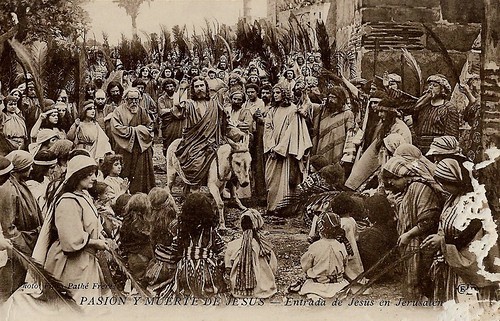
Spanish edition by ELD of the postcard series Passion et mort de Notre Seigneur Jésus-Christ. Photo: Films Pathé Frères. This was the fourth part of La Vie de Notre Seigneur Jésus-Christ (Maurice André Maître, 1914), with Jacques Norman playing Christ. Caption: The Entry of Jesus into Jerusalem.
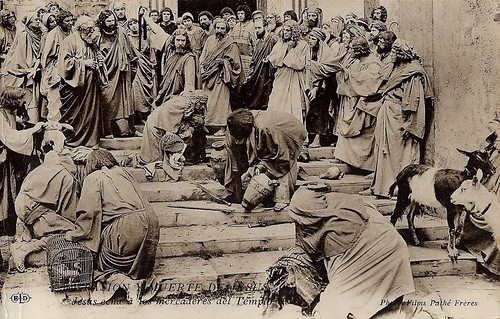
Spanish edition by ELD of the postcard series Passion et mort de Notre Seigneur Jésus-Christ. Photo: Films Pathé Frères. This was the fourth part of La Vie de Notre Seigneur Jésus-Christ (Maurice André Maître, 1914), with Jacques Norman playing Christ. Caption: Jesus chases the Mercenaries from the Temple.
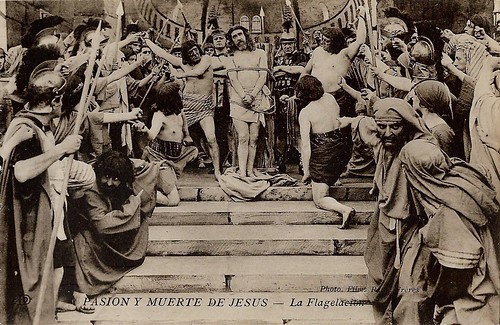
Spanish edition by ELD of the postcard series Passion et mort de Notre Seigneur Jésus-Christ. Photo: Films Pathé Frères. This was the fourth part of La Vie de Notre Seigneur Jésus-Christ (Maurice André Maître, 1914), with Jacques Norman playing Christ. Caption: The Flagellation.
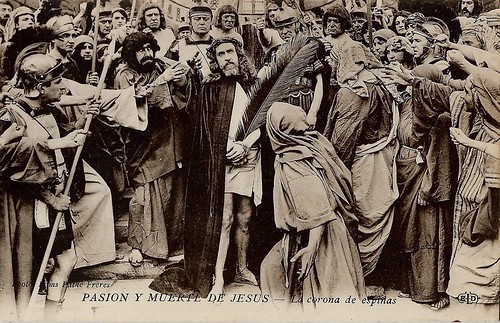
Spanish edition by ELD of the postcard series Passion et mort de Notre Seigneur Jésus-Christ. Photo: Films Pathé Frères. This was the fourth part of La Vie de Notre Seigneur Jésus-Christ (Maurice André Maître, 1914), with Jacques Norman playing Christ. Caption: The Crown of Thorns.
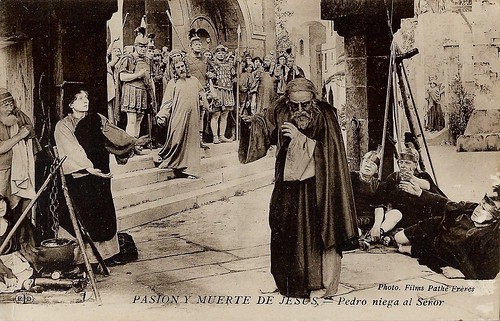
Spanish edition by ELD of the postcard series Passion et mort de Notre Seigneur Jésus-Christ. Photo: Films Pathé Frères. This was the fourth part of La Vie de Notre Seigneur Jésus-Christ (Maurice André Maître, 1914), with Jacques Norman playing Christ. Caption: Peter denies the Lord.
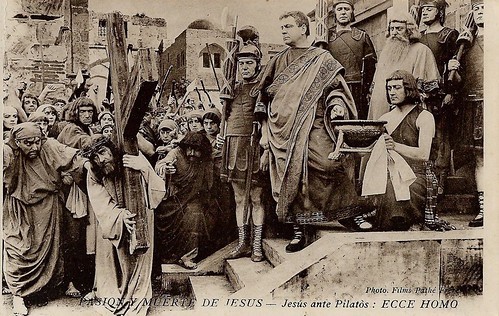
Spanish edition by ELD of the postcard series Passion et mort de Notre Seigneur Jésus-Christ. Photo: Films Pathé Frères. This was the fourth part of La Vie de Notre Seigneur Jésus-Christ (Maurice André Maître, 1914), with Jacques Norman playing Christ. Caption: Jesus before Pilate: Ecce Homo.
Pathé Frères' four versions of the life of Christ
In addition to the Gaumont version by Alice Guy , and the Kalem version shot in Palestine and following the Bible Illustrations by James Tissot, it was the French company Pathé Frères who made its mark in early cinema with well four versions of the life of Christ.
While from the first version, Vie et Passion du Christ (c. 1897-1899) only pictures remain, a second version was made in 1902, called La Vie et la Passion de Jésus-Christ. Though some sources claim its director was Ferdinand Zecca, the Seydoux-Pathé website with the Pathé filmography indicates no director.
From the film, only a few fragments remain, despite claims on YouTube and elsewhere they show the full version - often confounded with the third version by Lucien Nonguet, made in 1907. The 1907 version exists at various archives and has nice Pathé color stenciling.
In 1913-1914 a new, longer, and more elaborate, and again stencil-colored version was made by Maurice Maître, containing 19 tableaux. As the titles of the captions perfectly match the titles of the tableaux, it is possible six cards may still be missing in our series: The Last Supper, Jesus at the Mountain of Olives, The Kiss of Judas, Jesus Before Pilate, Jesus Falls under the Cross, and the final scene: The King of Kings.
Among the tableaux, Jesus Falls under the Cross and The Wonder of Veronica are presented as separate scenes, while our card seems to synthesize the two. A photo series at the time was made that indeed contained 18 and not 19 photos.
With most of these film versions, exhibitors could choose to show only one part of the life of Christ around, say, Christmas and Easter.
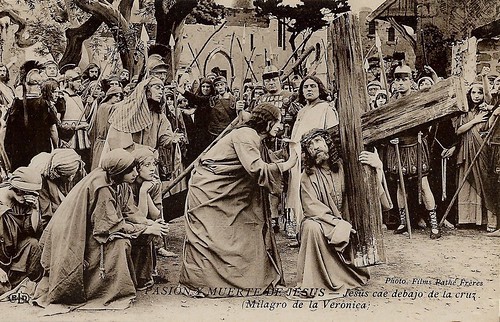
Spanish edition by ELD of the postcard series Passion et mort de Notre Seigneur Jésus-Christ. Photo: Films Pathé Frères. This was the fourth part of La Vie de Notre Seigneur Jésus-Christ (Maurice André Maître, Pathé Frères 1914), with Jacques Norman playing Christ. Caption: Jesus falls under the cross (Miracle of Veronica).
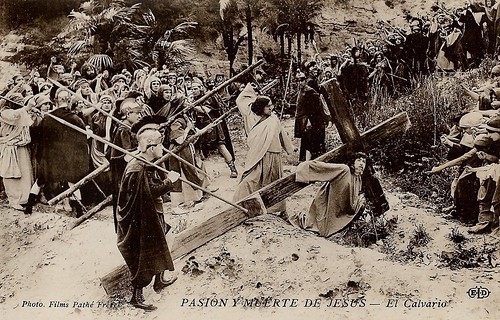
Spanish edition by ELD of the postcard series Passion et mort de Notre Seigneur Jésus-Christ. Photo: Films Pathé Frères. This was the fourth part of La Vie de Notre Seigneur Jésus-Christ (Maurice André Maître, 1914), with Jacques Norman playing Christ. Caption: Calvary.
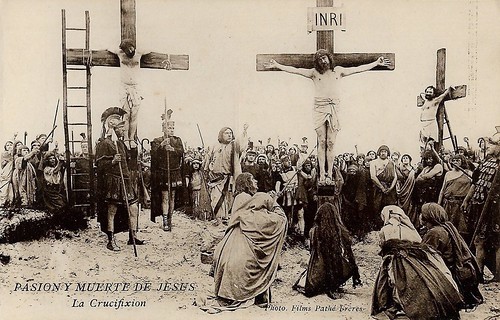
Spanish edition by ELD of the postcard series Passion et mort de Notre Seigneur Jésus-Christ. Photo: Films Pathé Frères. This was the fourth part of La Vie de Notre Seigneur Jésus-Christ (Maurice André Maître, 1914), with Jacques Norman playing Christ. Caption: The Crucifixion.
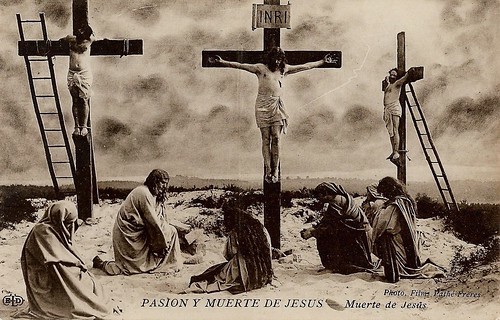
Spanish edition by ELD of the postcard series Passion et mort de Notre Seigneur Jésus-Christ. Photo: Films Pathé Frères. This was the fourth part of La Vie de Notre Seigneur Jésus-Christ (Maurice André Maître, 1914), with Jacques Norman playing Christ. Caption: Death of Jesus.
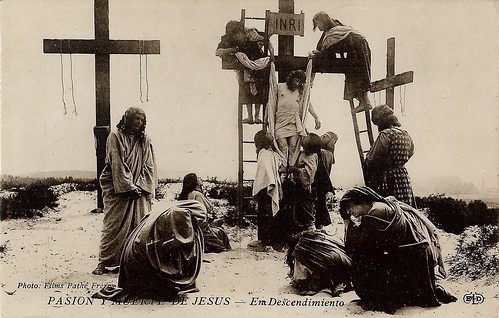
Spanish edition by ELD of the postcard series Passion et mort de Notre Seigneur Jésus-Christ. Photo: Films Pathé Frères. This was the fourth part of La Vie de Notre Seigneur Jésus-Christ (Maurice André Maître, 1914), with Jacques Norman playing Christ. Caption: In Descent.
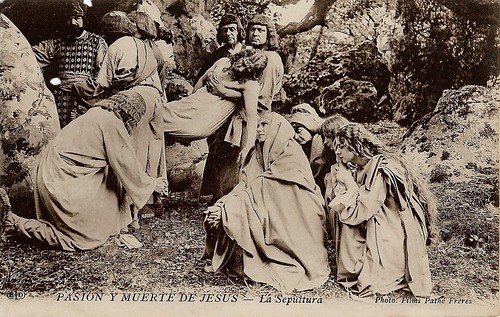
Spanish edition by ELD of the postcard series Passion et mort de Notre Seigneur Jésus-Christ. Photo: Films Pathé Frères. This was the fourth part of La Vie de Notre Seigneur Jésus-Christ (Maurice André Maître, 1914), with Jacques Norman playing Christ. Caption: The Grave.
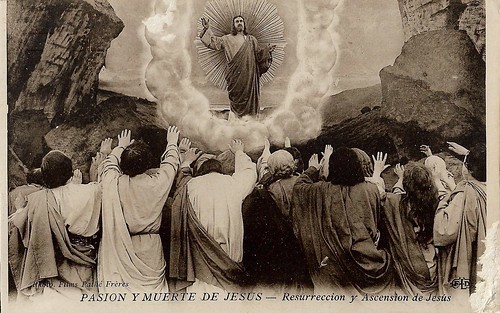
Spanish edition by ELD of the postcard series Passion et mort de Notre Seigneur Jésus-Christ. Photo: Films Pathé Frères. This was the fourth part of La Vie de Notre Seigneur Jésus-Christ (Maurice André Maître, 1914), with Jacques Norman playing Christ. Caption: Resurrection and Ascension of Jesus.
Sources: Fondation Jerome Seydoux - Pathe, and IMDb.

Spanish edition by ELD of the postcard series Passion et mort de Notre Seigneur Jésus-Christ. Photo: Films Pathé Frères. This was the fourth part of La Vie de Notre Seigneur Jésus-Christ (Maurice André Maître, 1914), with Jacques Norman playing Christ. Caption: The Entry of Jesus into Jerusalem.

Spanish edition by ELD of the postcard series Passion et mort de Notre Seigneur Jésus-Christ. Photo: Films Pathé Frères. This was the fourth part of La Vie de Notre Seigneur Jésus-Christ (Maurice André Maître, 1914), with Jacques Norman playing Christ. Caption: Jesus chases the Mercenaries from the Temple.

Spanish edition by ELD of the postcard series Passion et mort de Notre Seigneur Jésus-Christ. Photo: Films Pathé Frères. This was the fourth part of La Vie de Notre Seigneur Jésus-Christ (Maurice André Maître, 1914), with Jacques Norman playing Christ. Caption: The Flagellation.

Spanish edition by ELD of the postcard series Passion et mort de Notre Seigneur Jésus-Christ. Photo: Films Pathé Frères. This was the fourth part of La Vie de Notre Seigneur Jésus-Christ (Maurice André Maître, 1914), with Jacques Norman playing Christ. Caption: The Crown of Thorns.

Spanish edition by ELD of the postcard series Passion et mort de Notre Seigneur Jésus-Christ. Photo: Films Pathé Frères. This was the fourth part of La Vie de Notre Seigneur Jésus-Christ (Maurice André Maître, 1914), with Jacques Norman playing Christ. Caption: Peter denies the Lord.

Spanish edition by ELD of the postcard series Passion et mort de Notre Seigneur Jésus-Christ. Photo: Films Pathé Frères. This was the fourth part of La Vie de Notre Seigneur Jésus-Christ (Maurice André Maître, 1914), with Jacques Norman playing Christ. Caption: Jesus before Pilate: Ecce Homo.
Pathé Frères' four versions of the life of Christ
In addition to the Gaumont version by Alice Guy , and the Kalem version shot in Palestine and following the Bible Illustrations by James Tissot, it was the French company Pathé Frères who made its mark in early cinema with well four versions of the life of Christ.
While from the first version, Vie et Passion du Christ (c. 1897-1899) only pictures remain, a second version was made in 1902, called La Vie et la Passion de Jésus-Christ. Though some sources claim its director was Ferdinand Zecca, the Seydoux-Pathé website with the Pathé filmography indicates no director.
From the film, only a few fragments remain, despite claims on YouTube and elsewhere they show the full version - often confounded with the third version by Lucien Nonguet, made in 1907. The 1907 version exists at various archives and has nice Pathé color stenciling.
In 1913-1914 a new, longer, and more elaborate, and again stencil-colored version was made by Maurice Maître, containing 19 tableaux. As the titles of the captions perfectly match the titles of the tableaux, it is possible six cards may still be missing in our series: The Last Supper, Jesus at the Mountain of Olives, The Kiss of Judas, Jesus Before Pilate, Jesus Falls under the Cross, and the final scene: The King of Kings.
Among the tableaux, Jesus Falls under the Cross and The Wonder of Veronica are presented as separate scenes, while our card seems to synthesize the two. A photo series at the time was made that indeed contained 18 and not 19 photos.
With most of these film versions, exhibitors could choose to show only one part of the life of Christ around, say, Christmas and Easter.

Spanish edition by ELD of the postcard series Passion et mort de Notre Seigneur Jésus-Christ. Photo: Films Pathé Frères. This was the fourth part of La Vie de Notre Seigneur Jésus-Christ (Maurice André Maître, Pathé Frères 1914), with Jacques Norman playing Christ. Caption: Jesus falls under the cross (Miracle of Veronica).

Spanish edition by ELD of the postcard series Passion et mort de Notre Seigneur Jésus-Christ. Photo: Films Pathé Frères. This was the fourth part of La Vie de Notre Seigneur Jésus-Christ (Maurice André Maître, 1914), with Jacques Norman playing Christ. Caption: Calvary.

Spanish edition by ELD of the postcard series Passion et mort de Notre Seigneur Jésus-Christ. Photo: Films Pathé Frères. This was the fourth part of La Vie de Notre Seigneur Jésus-Christ (Maurice André Maître, 1914), with Jacques Norman playing Christ. Caption: The Crucifixion.

Spanish edition by ELD of the postcard series Passion et mort de Notre Seigneur Jésus-Christ. Photo: Films Pathé Frères. This was the fourth part of La Vie de Notre Seigneur Jésus-Christ (Maurice André Maître, 1914), with Jacques Norman playing Christ. Caption: Death of Jesus.

Spanish edition by ELD of the postcard series Passion et mort de Notre Seigneur Jésus-Christ. Photo: Films Pathé Frères. This was the fourth part of La Vie de Notre Seigneur Jésus-Christ (Maurice André Maître, 1914), with Jacques Norman playing Christ. Caption: In Descent.

Spanish edition by ELD of the postcard series Passion et mort de Notre Seigneur Jésus-Christ. Photo: Films Pathé Frères. This was the fourth part of La Vie de Notre Seigneur Jésus-Christ (Maurice André Maître, 1914), with Jacques Norman playing Christ. Caption: The Grave.

Spanish edition by ELD of the postcard series Passion et mort de Notre Seigneur Jésus-Christ. Photo: Films Pathé Frères. This was the fourth part of La Vie de Notre Seigneur Jésus-Christ (Maurice André Maître, 1914), with Jacques Norman playing Christ. Caption: Resurrection and Ascension of Jesus.
Sources: Fondation Jerome Seydoux - Pathe, and IMDb.
Published on April 03, 2021 22:00
April 2, 2021
Clacquesin
Clacquesin is a liqueur produced from ca. 1860 by Paul Clacquesin, industrialist, owner of a distillery company founded in 1775 at rue du Dragon in Paris, and produced in his factories in Malakoff. Clacquesin was very popular at the beginning of the 20th century. To promote their liqueur, Claquesin published a unique series of postcards in the mid-1930s. The cards show portraits of French film and stage stars and sports celebrities combined with nice little drawings that illustrate their careers.
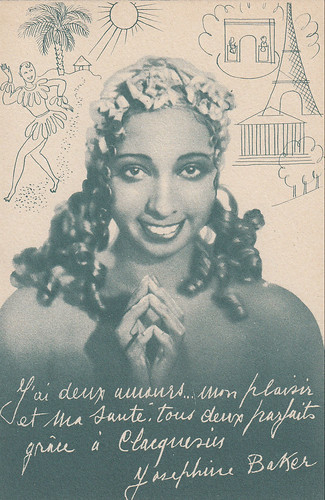
French promotion postcard for Clacquesin. Collection: Marlene Pilaete.
Josephine Baker (1906-1975) was well-known as a singer and dancer. In 1925 she became an instant success in Paris, because of her erotic dance. She also performed in a handful of silent and early sound films, La Sirene des Tropiques (1927), Zouzou (1934), and La princesse TamTam (1935).
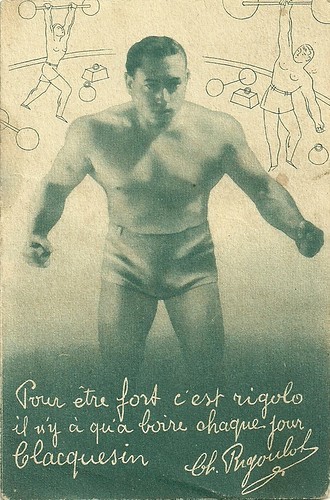
French promotion postcard for Clacquesin, Extrait de Pins. Caption: "To be[come] strong, it is funny but you only have to drink every day a Clacquesin."
Charles Rigoulot (1903-1962) was a French weightlifter, professional wrestler, racing driver, and actor. Rigoulot won a gold medal at the 1924 Olympics, and between 1923 and 1926 he set eight official world records. In 1931 Rigoulot hurt himself in weightlifting and quit. He turned professional and worked as a car racer, strongman in the circus, an actor and singer in the theatre, and as a wrestler. Rigoulot acted in several films: Un soire de bombe (Maurice de Cammage, 1935), L'aventure est au coin de la rue (Jacques Daniel-Norman, 1944), Cent francs par seconde (Jean Boyer, 1953) - in which he played himself, just as in Sur deux roues (René Lucot, 1953). His last film role was in À la manière de Sherlock Holmes (Henri Lepage, 1956).
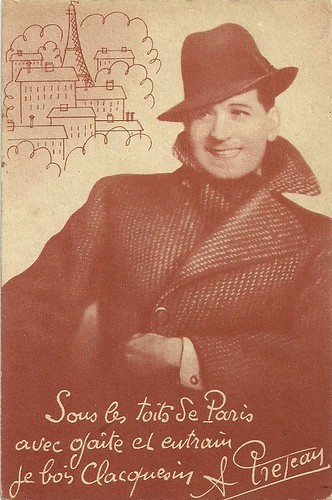
French promotion postcard for Clacquesin, Extrait de Pins. Caption: "Under the Roofs of Paris, with gaiety and spirit I drink Clacquesin." 'Sous les toits de Paris' refers to one of Préjean's most popular films, Sous les toits de Paris (René Clair, 1930).
French actor and singer Albert Préjean (1894-1979) was a former WWI flying ace. He is best known for playing heroes in the silent films of René Clair, and for playing George Simenon's detective Maigret.
A medalist at the Paris 1900 World Fair
Clacquesin was described as a tar liqueur or hygienic tar, in reference to one of its main constituents, Norway pine tar. Clacquesin was a medalist at the Paris 1900 World Fair and enjoyed growing success on this occasion.
From 1903, the production, until then at rue du Dragon, was transported to a factory located in Malakoff. Clacquesin was very popular during the 1920s and 1930s - in the 1930s it was one of the most consumed French liquors - but production stopped in 1942, during World War II. Clacquesin struggled to restart afterwards.
The Malakoff factory ceased production in 1995 and the building was classified as a historic monument in 2002. Clacquesin was then produced in Provins, from which 50,000 bottles were produced each year, distributed mainly by wine merchants.
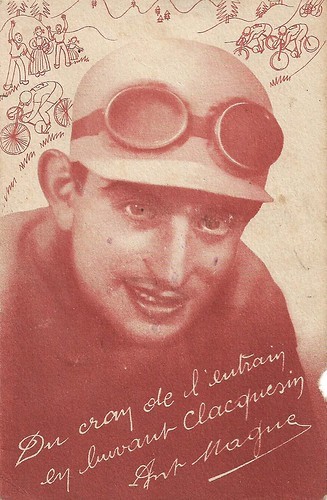
French promotion postcard for Clacquesin, Extrait de Pins.
Antonin Magne (1904-1983) was a French racing cyclist, who won the Tour de France in 1931 and 1934. He raced as a professional from 1927 to 1939 and then became a team manager.
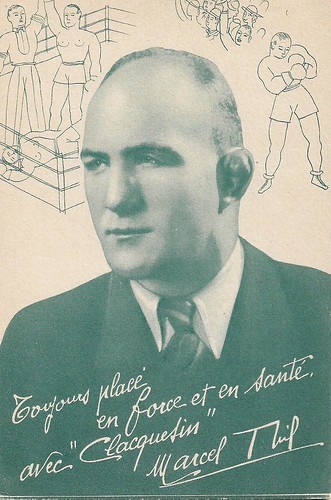
French postcard. Publicity for Clacquesin liquor.
Marcel Thil (1904-1968) was a French boxer. A big friend of actor Jean Gabin, Marcel Thil fought in the 1930s in the middleweight category, a category in which he was world champion from 1932 to 1937. After his boxing career was over, he became a trader in wood and coal. During the war he was a trainer of boxing amateurs. In 1942 he played a boxing arbiter in the film Le grand combat (Bernard-Roland, 1942). Thill died after a car accident.
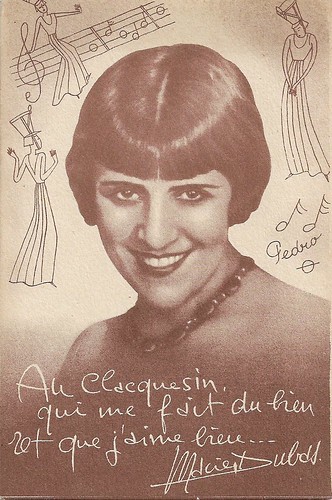
French postcard. Publicity for Clacquesin liquor.
Marie Dubas (1894-1972) was a French actress and singer, who starred in several popular operettas. Later, she became one of the queens of the music hall.
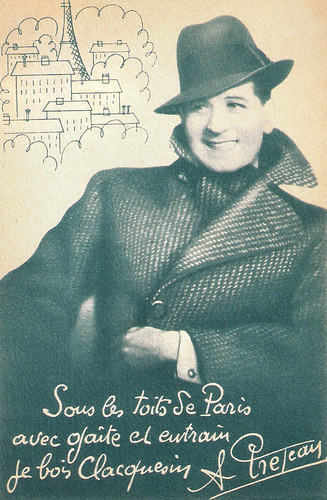
French promotion postcard for Clacquesin, Extrait de Pins. Caption: "For your pleasure, for your health, drink Clacquesin every season. The healthiest appetizer."
French actor and singer Albert Préjean (1894-1979) was a former WWI flying ace. He is best known for playing heroes in the silent films of René Clair, and for playing George Simenon's detective Maigret.
Source: Wikipedia (French).

French promotion postcard for Clacquesin. Collection: Marlene Pilaete.
Josephine Baker (1906-1975) was well-known as a singer and dancer. In 1925 she became an instant success in Paris, because of her erotic dance. She also performed in a handful of silent and early sound films, La Sirene des Tropiques (1927), Zouzou (1934), and La princesse TamTam (1935).

French promotion postcard for Clacquesin, Extrait de Pins. Caption: "To be[come] strong, it is funny but you only have to drink every day a Clacquesin."
Charles Rigoulot (1903-1962) was a French weightlifter, professional wrestler, racing driver, and actor. Rigoulot won a gold medal at the 1924 Olympics, and between 1923 and 1926 he set eight official world records. In 1931 Rigoulot hurt himself in weightlifting and quit. He turned professional and worked as a car racer, strongman in the circus, an actor and singer in the theatre, and as a wrestler. Rigoulot acted in several films: Un soire de bombe (Maurice de Cammage, 1935), L'aventure est au coin de la rue (Jacques Daniel-Norman, 1944), Cent francs par seconde (Jean Boyer, 1953) - in which he played himself, just as in Sur deux roues (René Lucot, 1953). His last film role was in À la manière de Sherlock Holmes (Henri Lepage, 1956).

French promotion postcard for Clacquesin, Extrait de Pins. Caption: "Under the Roofs of Paris, with gaiety and spirit I drink Clacquesin." 'Sous les toits de Paris' refers to one of Préjean's most popular films, Sous les toits de Paris (René Clair, 1930).
French actor and singer Albert Préjean (1894-1979) was a former WWI flying ace. He is best known for playing heroes in the silent films of René Clair, and for playing George Simenon's detective Maigret.
A medalist at the Paris 1900 World Fair
Clacquesin was described as a tar liqueur or hygienic tar, in reference to one of its main constituents, Norway pine tar. Clacquesin was a medalist at the Paris 1900 World Fair and enjoyed growing success on this occasion.
From 1903, the production, until then at rue du Dragon, was transported to a factory located in Malakoff. Clacquesin was very popular during the 1920s and 1930s - in the 1930s it was one of the most consumed French liquors - but production stopped in 1942, during World War II. Clacquesin struggled to restart afterwards.
The Malakoff factory ceased production in 1995 and the building was classified as a historic monument in 2002. Clacquesin was then produced in Provins, from which 50,000 bottles were produced each year, distributed mainly by wine merchants.

French promotion postcard for Clacquesin, Extrait de Pins.
Antonin Magne (1904-1983) was a French racing cyclist, who won the Tour de France in 1931 and 1934. He raced as a professional from 1927 to 1939 and then became a team manager.

French postcard. Publicity for Clacquesin liquor.
Marcel Thil (1904-1968) was a French boxer. A big friend of actor Jean Gabin, Marcel Thil fought in the 1930s in the middleweight category, a category in which he was world champion from 1932 to 1937. After his boxing career was over, he became a trader in wood and coal. During the war he was a trainer of boxing amateurs. In 1942 he played a boxing arbiter in the film Le grand combat (Bernard-Roland, 1942). Thill died after a car accident.

French postcard. Publicity for Clacquesin liquor.
Marie Dubas (1894-1972) was a French actress and singer, who starred in several popular operettas. Later, she became one of the queens of the music hall.

French promotion postcard for Clacquesin, Extrait de Pins. Caption: "For your pleasure, for your health, drink Clacquesin every season. The healthiest appetizer."
French actor and singer Albert Préjean (1894-1979) was a former WWI flying ace. He is best known for playing heroes in the silent films of René Clair, and for playing George Simenon's detective Maigret.
Source: Wikipedia (French).
Published on April 02, 2021 22:00
Paul van Yperen's Blog
- Paul van Yperen's profile
- 13 followers
Paul van Yperen isn't a Goodreads Author
(yet),
but they
do have a blog,
so here are some recent posts imported from
their feed.



